Feb 2012
Jeans
29/02/12 04:35
We wore jeans as kids. In those days there were three brands sold in our town: Farah, Lee and Levis. I don’t remember having anything to say about what brand of jeans I wore until I was a high school student. It was absolutely clear in our home that jeans were not suitable for church. On Sundays we wore our dress pants, except for Rodeo Sunday, when we were allowed to wear a brand-new pair of jeans to church. We had multiple pairs of jeans. The newest pair was reserved for school. These were supposed to not have holes in the knees, but a little hole would be tolerated as long as they were our best pair of jeans. We were supposed to change our jeans after school, and we usually did.
After we completely wore the knees out of our jeans, they gained a new life as a pair of cutoff shorts. We wore cutoffs all summer long. Sometimes in the spring and sometimes in the fall we were allowed to wear cutoffs after school in the afternoon, but springs were relatively cool in our home town, so the season for wearing cutoffs after school was always short.
We got one pair of new jeans for Rodeo weekend. Usually there also was a new shirt with snaps instead of buttons. We often got a couple of pairs of jeans for back to school and some years we’d get a new pair of jeans at Christmas as well. I was the oldest boy and so I didn’t wear hand-me-downs as much as my brothers, but they rarely had to wear hand-me-down jeans because the jeans were thoroughly worn out before they could be handed down.
 Somewhere along the line, I learned to enjoy getting dressed up. When I went away to college I owned several pairs of jeans, but I didn’t wear jeans for everyday. I often wore slacks to class. Jeans were saved for weekends and for summer time, when I often had a job that required clothing that could take a beating.
Somewhere along the line, I learned to enjoy getting dressed up. When I went away to college I owned several pairs of jeans, but I didn’t wear jeans for everyday. I often wore slacks to class. Jeans were saved for weekends and for summer time, when I often had a job that required clothing that could take a beating.
Four years of college plus four years of graduate school convinced me that I was a “professional,” whatever that might mean. I started to wear dress slacks and dress shirts to work as I began my career. But my career began in rural North Dakota, where even school teachers and lawyers who wore shirts and ties to work every day switched to jeans as soon as they got off of work. Youth work, Vacation Bible School, camp and other activities were times when jeans were the appropriate apparel.
When we moved to Boise, I went to work in a tie and a jacket most days. Jeans and t-shirts were reserved for youth group, camp and days off. I often rode my bicycle to work in those days, so I learned to put band around the legs of my pants to keep them from getting grease from the chain.
I continued the white shirt and tie routine for the first five years that I served our current congregation in Rapid City. Along the way, I began to wear colored shirts with ties from time to time and then more often. After a few more years passed, I reserved white shirts and ties for Sundays. I didn’t wear a tie to work every day any more. Around me the dress of other professionals was also becoming more casual. I noticed that my colleagues didn’t dress up as often as before. I found myself at meetings where I was the only pastor wearing a tie.
Along the way, I found myself occasionally wearing a sports coat without a tie. I would even wear a blue blazer with a new pair of jeans occasionally. My wardrobe continued to evolve.
In the autumn of 2010, I came home from a visit to England with a beautiful Harris Tweed jacket. It is warm and comfortable and wonderful. And I found myself wearing it over a long-sleeved t-shirt.
These days I often wear jeans, a long-sleeved t-shirt and a sport coat to work. I am not the only one who has changed my manner of dress. Like the days when I was a kid, I sometimes have two pairs of new jeans at the same time.
The manner of my dress isn’t the only thing that has changed. My Levis have changed as well. Since the closure of the last US Levis plant in 1990, all Levis brand jeans are made overseas. In the mid 1990’s the company took on multi-billion dollar debt. In 2002, the company entered into a contract with Wal-Mart that called for a special line of “Signature” jeans. Those jeans are produced in huge volume at very low prices by Chinese laborers. Although Levis are available at other retailers, the percentage of the jeans that go to Wal-Mart is significant and the methods of production for the signature line are not different than those sold at other outlets.
Being a person with an inseam that is an odd number, I have enjoyed wearing Levis because I can purchase ones that fit. However, I began to notice that jeans with odd inseams were getting harder and harder to find. I can still find them, but these days the difference between odd- and even- length inseams is more in the label than the measurement of the inseam.
In 1920, Homer Campbell of Constellation, Arizona, returned a pair of Jeans to the Levi Strauss Company with a letter. His letter explained that he has purchased the jeans in 1917. He went on to say, “I have worn them every day except Sunday since that time and for some reason which I wish you would explain they have gone to pieces.” Having worn Levi brand jeans for 30 years, Mr. Campbell was disappointed with the decrease in quality that produced a pair of jeans that would last for only three years of every day wear.
If I could get a pair of jeans to last three years, I think I would be satisfied.
 I still own dress slacks. I still wear them on Sundays and during the week when I have an important meeting or a reason to look a bit more professional. More and more, however, I find myself wearing jeans in settings where I wouldn’t previously have considered such clothes.
I still own dress slacks. I still wear them on Sundays and during the week when I have an important meeting or a reason to look a bit more professional. More and more, however, I find myself wearing jeans in settings where I wouldn’t previously have considered such clothes.
Perhaps it is appropriate for a servant of God to wear the clothes of a servant when heading to work.
After we completely wore the knees out of our jeans, they gained a new life as a pair of cutoff shorts. We wore cutoffs all summer long. Sometimes in the spring and sometimes in the fall we were allowed to wear cutoffs after school in the afternoon, but springs were relatively cool in our home town, so the season for wearing cutoffs after school was always short.
We got one pair of new jeans for Rodeo weekend. Usually there also was a new shirt with snaps instead of buttons. We often got a couple of pairs of jeans for back to school and some years we’d get a new pair of jeans at Christmas as well. I was the oldest boy and so I didn’t wear hand-me-downs as much as my brothers, but they rarely had to wear hand-me-down jeans because the jeans were thoroughly worn out before they could be handed down.

Four years of college plus four years of graduate school convinced me that I was a “professional,” whatever that might mean. I started to wear dress slacks and dress shirts to work as I began my career. But my career began in rural North Dakota, where even school teachers and lawyers who wore shirts and ties to work every day switched to jeans as soon as they got off of work. Youth work, Vacation Bible School, camp and other activities were times when jeans were the appropriate apparel.
When we moved to Boise, I went to work in a tie and a jacket most days. Jeans and t-shirts were reserved for youth group, camp and days off. I often rode my bicycle to work in those days, so I learned to put band around the legs of my pants to keep them from getting grease from the chain.
I continued the white shirt and tie routine for the first five years that I served our current congregation in Rapid City. Along the way, I began to wear colored shirts with ties from time to time and then more often. After a few more years passed, I reserved white shirts and ties for Sundays. I didn’t wear a tie to work every day any more. Around me the dress of other professionals was also becoming more casual. I noticed that my colleagues didn’t dress up as often as before. I found myself at meetings where I was the only pastor wearing a tie.
Along the way, I found myself occasionally wearing a sports coat without a tie. I would even wear a blue blazer with a new pair of jeans occasionally. My wardrobe continued to evolve.
In the autumn of 2010, I came home from a visit to England with a beautiful Harris Tweed jacket. It is warm and comfortable and wonderful. And I found myself wearing it over a long-sleeved t-shirt.
These days I often wear jeans, a long-sleeved t-shirt and a sport coat to work. I am not the only one who has changed my manner of dress. Like the days when I was a kid, I sometimes have two pairs of new jeans at the same time.
The manner of my dress isn’t the only thing that has changed. My Levis have changed as well. Since the closure of the last US Levis plant in 1990, all Levis brand jeans are made overseas. In the mid 1990’s the company took on multi-billion dollar debt. In 2002, the company entered into a contract with Wal-Mart that called for a special line of “Signature” jeans. Those jeans are produced in huge volume at very low prices by Chinese laborers. Although Levis are available at other retailers, the percentage of the jeans that go to Wal-Mart is significant and the methods of production for the signature line are not different than those sold at other outlets.
Being a person with an inseam that is an odd number, I have enjoyed wearing Levis because I can purchase ones that fit. However, I began to notice that jeans with odd inseams were getting harder and harder to find. I can still find them, but these days the difference between odd- and even- length inseams is more in the label than the measurement of the inseam.
In 1920, Homer Campbell of Constellation, Arizona, returned a pair of Jeans to the Levi Strauss Company with a letter. His letter explained that he has purchased the jeans in 1917. He went on to say, “I have worn them every day except Sunday since that time and for some reason which I wish you would explain they have gone to pieces.” Having worn Levi brand jeans for 30 years, Mr. Campbell was disappointed with the decrease in quality that produced a pair of jeans that would last for only three years of every day wear.
If I could get a pair of jeans to last three years, I think I would be satisfied.

Perhaps it is appropriate for a servant of God to wear the clothes of a servant when heading to work.
Copyright © 2012 by Ted Huffman. I wrote this. If you want to copy it, please ask for permission. There is a contact me button at the bottom of this page. If you want to share my blog a friend, please direct your friend to my web site.
The Night Sky
28/02/12 05:49
Early Saturday evening we were visiting friends and as we went out to the car we were treated with a spectacular view of the crescent moon and Venus in the evening sky. It was a clear night and I remembered that the third bright light in the same vicinity was another planet, but had forgotten for the moment which one. A quick check after arriving at home revealed that the beautiful formation was Venus and Jupiter making an appearance in the sky along with the moon. Those who had a good view of the sky a bit earlier, just after the sun set, might have also gotten a glimpse of Mercury setting along with the bright trio appearing above.

We’ve got a winter storm moving in, so star gazing hasn’t been in the picture for us for the last couple of nights. I didn’t get an opportunity to go out with my camera to try to capture the beautiful vision. The way that the hill and the trees rise to the west of our home made getting a picture probably out of the question anyway. I’m not too good with taking night pictures. My photo archives have lots of images with tiny lights in fields of black. The people who capture the kind of images that accompany today’s blog have more patience, more experience and more knowledge than I.
But I do have an appreciation for the night sky.
We are fortunate to live in a place where we can go out on our deck and look up to see the stars overhead. Our neighborhood does not have commercial streetlights. The smaller post lights that most of us have contribute a bit to light pollution, but don’t pose a significant threat to stargazing. We have one neighbor, a convenience store about a quarter of a mile around the hill, that has gotten carried away with bright lights, but hopefully it will be a while before too many others feel a need to light up too much of the neighborhood.
Years ago, when we worked as managers of a church camp that was far from town in the mountains of Montana, I developed a sense of being at home in the dark. When we had a time with no campers, we wouldn’t turn on any of the yard lights. Our eyes would quickly adjust to the darkness and we would be able to see whatever we needed by moonlight. On nights when clouds obscured the sky, there was an awesome blackness that surrounded us. The area was safe. About the only critter that might pose a bit of a danger was an occasional bear that wandered through and the bears were as afraid of us as we were of them. They didn’t move about when it was very dark, either.
It always surprised me how afraid of the dark many of the campers were. There was no need for them to go out in the dark alone. We had good yard lights to illuminate the paths between the cabins. The program of the camp was based on group activities and times to be alone where scheduled during the day when it was easy to keep track of all of the campers.
There was one pattern that I often noticed. After a day’s work, when vespers were completed and the campers were in their cabins and lights out had occurred there would occasionally be an individual or a couple who would try to sneak off for a private moment. We liked to sit in our cabin with all of the lights off, which made it easy for us to see what was going on all around the camp. We’d sit and watch and when a worried counselor would come by we almost always were able to tell them exactly where the “missing” camper was. They never wandered far.
There was one counselor that came to camp who was very proud of his bright flashlight that took 4 D batteries, had a long handle and threw out a beam. He would wander around the camp with the flashlight, shining it into the dark places and looking for whatever it was that he thought he might find. Sitting in our dark cabin, he was easy to spot wherever he went. The problem with a good bright light in a very dark place is that your eyes adjust to the light and you can see only in the direction that the light is shining. All else seems even darker than if the light were turned off. Most nights I didn’t need a flashlight to see. And with no flashlight, I could see into the shadows and wasn’t startled by the darkness around me. I still love to go for a night hike in the woods, though I do make a few extra precautions now that we have mountain lions for neighbors.
The glory of the night is in the sky. On a clear night it is easy to see why the ancients imagined a huge dome hanging over the earth filled with stars. People have seen the incredible beauty that we witness for thousands and thousands of years. The ancient poems of our people speak of the beauty of the night sky: “When I consider thy heavens, the work of thy fingers, the moon and the stars, which thou hast made . . .”
 Looking at the night sky can give one important perspective. In the vastness of this great universe, an individual human is a pretty small thing. The great distances of space are far too vast to traverse in a lifetime. The light that we see has covered distances that are beyond our understanding. And yet here we are. On this somewhat insignificant planet, the third from the sun in a rather ordinary solar system in the midst of a normal galaxy, we peer out at the vastness of the universe and ponder the meaning of it all. We may not be unique, but at least in this one place, the universe takes a look at itself and tries to grasp its meaning. We many not understand it all, but at least we are looking and aware that the glory of that which lies beyond is worthy of our contemplation.
Looking at the night sky can give one important perspective. In the vastness of this great universe, an individual human is a pretty small thing. The great distances of space are far too vast to traverse in a lifetime. The light that we see has covered distances that are beyond our understanding. And yet here we are. On this somewhat insignificant planet, the third from the sun in a rather ordinary solar system in the midst of a normal galaxy, we peer out at the vastness of the universe and ponder the meaning of it all. We may not be unique, but at least in this one place, the universe takes a look at itself and tries to grasp its meaning. We many not understand it all, but at least we are looking and aware that the glory of that which lies beyond is worthy of our contemplation.
I know that the increasing urbanization of the planet means there will be more lights. I know that the need for health care will draw me into cities as I grow older. But I hope that I will always be able to find a dark place in the evening where I can look out and see the night sky. And, if I should one day find myself where there is no such view I hope I will at least remember the beauty of looking up last Saturday night, glimpsing the moon and Venus and the way they took my breath away.

We’ve got a winter storm moving in, so star gazing hasn’t been in the picture for us for the last couple of nights. I didn’t get an opportunity to go out with my camera to try to capture the beautiful vision. The way that the hill and the trees rise to the west of our home made getting a picture probably out of the question anyway. I’m not too good with taking night pictures. My photo archives have lots of images with tiny lights in fields of black. The people who capture the kind of images that accompany today’s blog have more patience, more experience and more knowledge than I.
But I do have an appreciation for the night sky.
We are fortunate to live in a place where we can go out on our deck and look up to see the stars overhead. Our neighborhood does not have commercial streetlights. The smaller post lights that most of us have contribute a bit to light pollution, but don’t pose a significant threat to stargazing. We have one neighbor, a convenience store about a quarter of a mile around the hill, that has gotten carried away with bright lights, but hopefully it will be a while before too many others feel a need to light up too much of the neighborhood.
Years ago, when we worked as managers of a church camp that was far from town in the mountains of Montana, I developed a sense of being at home in the dark. When we had a time with no campers, we wouldn’t turn on any of the yard lights. Our eyes would quickly adjust to the darkness and we would be able to see whatever we needed by moonlight. On nights when clouds obscured the sky, there was an awesome blackness that surrounded us. The area was safe. About the only critter that might pose a bit of a danger was an occasional bear that wandered through and the bears were as afraid of us as we were of them. They didn’t move about when it was very dark, either.
It always surprised me how afraid of the dark many of the campers were. There was no need for them to go out in the dark alone. We had good yard lights to illuminate the paths between the cabins. The program of the camp was based on group activities and times to be alone where scheduled during the day when it was easy to keep track of all of the campers.
There was one pattern that I often noticed. After a day’s work, when vespers were completed and the campers were in their cabins and lights out had occurred there would occasionally be an individual or a couple who would try to sneak off for a private moment. We liked to sit in our cabin with all of the lights off, which made it easy for us to see what was going on all around the camp. We’d sit and watch and when a worried counselor would come by we almost always were able to tell them exactly where the “missing” camper was. They never wandered far.
There was one counselor that came to camp who was very proud of his bright flashlight that took 4 D batteries, had a long handle and threw out a beam. He would wander around the camp with the flashlight, shining it into the dark places and looking for whatever it was that he thought he might find. Sitting in our dark cabin, he was easy to spot wherever he went. The problem with a good bright light in a very dark place is that your eyes adjust to the light and you can see only in the direction that the light is shining. All else seems even darker than if the light were turned off. Most nights I didn’t need a flashlight to see. And with no flashlight, I could see into the shadows and wasn’t startled by the darkness around me. I still love to go for a night hike in the woods, though I do make a few extra precautions now that we have mountain lions for neighbors.
The glory of the night is in the sky. On a clear night it is easy to see why the ancients imagined a huge dome hanging over the earth filled with stars. People have seen the incredible beauty that we witness for thousands and thousands of years. The ancient poems of our people speak of the beauty of the night sky: “When I consider thy heavens, the work of thy fingers, the moon and the stars, which thou hast made . . .”

I know that the increasing urbanization of the planet means there will be more lights. I know that the need for health care will draw me into cities as I grow older. But I hope that I will always be able to find a dark place in the evening where I can look out and see the night sky. And, if I should one day find myself where there is no such view I hope I will at least remember the beauty of looking up last Saturday night, glimpsing the moon and Venus and the way they took my breath away.
Copyright © 2012 by Ted Huffman. I wrote this. If you want to copy it, please ask for permission. There is a contact me button at the bottom of this page. If you want to share my blog a friend, please direct your friend to my web site.
What Makes a South Dakotan?
27/02/12 04:06
The South Dakota Humanities Council will celebrate its 40 year anniversary this year and one of their projects has been to ask “What Makes a South Dakotan?” They are inviting South Dakotans to write and submit essays of 100 to 600 words that they intend to incorporate into a book. It is an intriguing idea.
 I need to start by saying that I probably will not submit an essay. I’m probably too long-winded for the project. My daily blogs average over 1,000 words each. But that isn’t the real reason. You see, I don’t know whether or not I am a South Dakotan. I have lived in this state over 16 years now. I have many friends and I have driven a fair share of the back roads. I love the land and I really enjoy each opportunity to get out into the open space. And I love the people. In this state are many really good people who go out of their ways to help their neighbors, who invest deeply in community, who share values of hard work, family and care for the land and the critters.
I need to start by saying that I probably will not submit an essay. I’m probably too long-winded for the project. My daily blogs average over 1,000 words each. But that isn’t the real reason. You see, I don’t know whether or not I am a South Dakotan. I have lived in this state over 16 years now. I have many friends and I have driven a fair share of the back roads. I love the land and I really enjoy each opportunity to get out into the open space. And I love the people. In this state are many really good people who go out of their ways to help their neighbors, who invest deeply in community, who share values of hard work, family and care for the land and the critters.
But I was not born in this state. I did not grow up here. I do not know where my life will lead me. I might retire in this place and I might retire in another place. Yesterday our congregation said farewell to a couple whose history has been intertwined with South Dakota for a long time. Ray Schatz was born in North Dakota, but attended college in South Dakota and began his career as a minister here. He served a congregation in Minnesota while furthering his education and another in Oregon and then came back to South Dakota where he served one of our congregations for over 20 years, was an Associate Conference Minister, and served several interim ministries. His wife, born and raised in South Dakota has many family ties in our state. Now, in their seventies, they are pulling up stakes and moving to Tennessee, where there is a retirement community closely related to our church that attracts many ministers and has the right cobination of services for people at their stage of life. Something tells me that they will always be South Dakotans even though they will be living in another state.
 I don’t know about myself. I was born in Montana, attended Seminary in Illinois, and have served congregations in North Dakota, Idaho and South Dakota. I have lived in the house that we now own more years than I have lived in any other house. Which is to say that I have moved about a fair amount. For many years, I identified myself as a Montanan. At each point in our lives when we have been looking to discern God’s call, I have thought that we would find a way to move back to Montana. Each time, we somehow ended up somewhere else. As the years have gone by, though my roots and loyalties run deep, I realize that the state of my birth might not really be my home state.
I don’t know about myself. I was born in Montana, attended Seminary in Illinois, and have served congregations in North Dakota, Idaho and South Dakota. I have lived in the house that we now own more years than I have lived in any other house. Which is to say that I have moved about a fair amount. For many years, I identified myself as a Montanan. At each point in our lives when we have been looking to discern God’s call, I have thought that we would find a way to move back to Montana. Each time, we somehow ended up somewhere else. As the years have gone by, though my roots and loyalties run deep, I realize that the state of my birth might not really be my home state.
That means that I will never have the connections to a single place that some people have. There are folks in our congregation who celebrate five generations of participation in our church. Not only have I never lived in the same state continuously for 25 years, neither of our children live in South Dakota. It is unlikely that our grandchildren will ever live here.
 One of the realities of South Dakota – and one of the things that might be a defining quality of South Dakotans – is that people who grow up here maintain their connections even when they live somewhere else. From a sociological viewpoint one of the things that makes a South Dakotan is that we export our children. Children who grow up in South Dakota are likely to live elsewhere for much of their income-producing years. There simply are not enough jobs to support those who grow up here and South Dakota offers some of the lowest wages in the country. In almost any profession there are higher wages to be earned by simply crossing state lines. However, those young people who move away to earn their living remain connected and many of them return to South Dakota to retire. In many parts of the world a growing population means that the population is young. Here in Rapid City we have a population that is growing larger and growing older at the same time.
One of the realities of South Dakota – and one of the things that might be a defining quality of South Dakotans – is that people who grow up here maintain their connections even when they live somewhere else. From a sociological viewpoint one of the things that makes a South Dakotan is that we export our children. Children who grow up in South Dakota are likely to live elsewhere for much of their income-producing years. There simply are not enough jobs to support those who grow up here and South Dakota offers some of the lowest wages in the country. In almost any profession there are higher wages to be earned by simply crossing state lines. However, those young people who move away to earn their living remain connected and many of them return to South Dakota to retire. In many parts of the world a growing population means that the population is young. Here in Rapid City we have a population that is growing larger and growing older at the same time.
Of course there is a sociological reality that follows the exporting of children. Those people tend to give birth to and raise their children in other places. Fewer children who are born and raised here continue to keep our state a place that has a lot of land populated by a few people. To be honest, it is one of the things that those of us who live here love about our lives – lots of open space. We can spend time alone when we want to.
One thing that binds South Dakotans is a sense of shared history. 2012 is not only the 40th anniversary of the founding of the South Dakota Humanities Council, it is also the 40th anniversary of the devastating flash flood that ripped through Rapid City leaving hundreds of fatalities and millions of dollars of destruction in its wake. I am often part of conversations where the participants are divided into two camps – those who remember the flood and those who came after the flood. I belong to the second camp, but I did visit Rapid City in the aftermath of the flood and witnessed much of the destruction before things had been cleaned up. I have a few first-hand memories of the aftermath that allow me to participate in conversations with both groups of people.
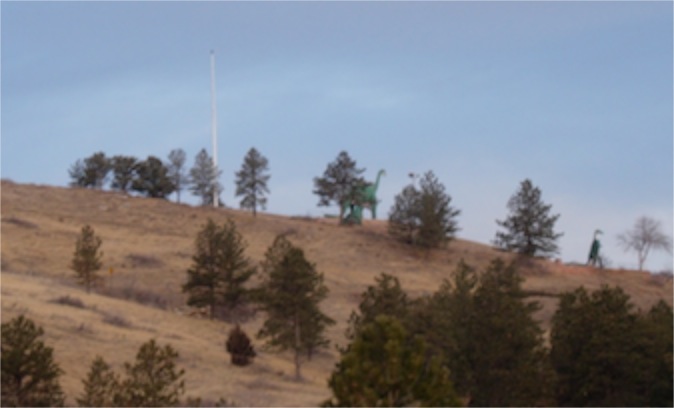 Still, I don’t think that I am really a South Dakotan in the same sense as the residents of the century farms or the reservation families that can trace their lineage to before the coming of European settlers. Maybe like many other people who end up living as wanderers in this world, I don’t have any single place that I can claim. Perhaps I am a Montanan-Illinoisan-North Dakotan-Idahoan-South Dakotan-perhaps some other-ian. That has been the story of our people. With our roots in Exodus and Exile, our people have always been wanderers. But we do know our home. “Lord, Thou hast been our dwelling place in all generations,” begins the 90th Psalm. It is the song of our people and it is my song as well.
Still, I don’t think that I am really a South Dakotan in the same sense as the residents of the century farms or the reservation families that can trace their lineage to before the coming of European settlers. Maybe like many other people who end up living as wanderers in this world, I don’t have any single place that I can claim. Perhaps I am a Montanan-Illinoisan-North Dakotan-Idahoan-South Dakotan-perhaps some other-ian. That has been the story of our people. With our roots in Exodus and Exile, our people have always been wanderers. But we do know our home. “Lord, Thou hast been our dwelling place in all generations,” begins the 90th Psalm. It is the song of our people and it is my song as well.
I probably will never write a “South Dakotan” essay. But I intend to buy and read the book. I’ve been around here enough to know that South Dakotans are fascinating and wonderful people. They make really good neighbors. It is part of the reason I’ve been living here for so long.

But I was not born in this state. I did not grow up here. I do not know where my life will lead me. I might retire in this place and I might retire in another place. Yesterday our congregation said farewell to a couple whose history has been intertwined with South Dakota for a long time. Ray Schatz was born in North Dakota, but attended college in South Dakota and began his career as a minister here. He served a congregation in Minnesota while furthering his education and another in Oregon and then came back to South Dakota where he served one of our congregations for over 20 years, was an Associate Conference Minister, and served several interim ministries. His wife, born and raised in South Dakota has many family ties in our state. Now, in their seventies, they are pulling up stakes and moving to Tennessee, where there is a retirement community closely related to our church that attracts many ministers and has the right cobination of services for people at their stage of life. Something tells me that they will always be South Dakotans even though they will be living in another state.

That means that I will never have the connections to a single place that some people have. There are folks in our congregation who celebrate five generations of participation in our church. Not only have I never lived in the same state continuously for 25 years, neither of our children live in South Dakota. It is unlikely that our grandchildren will ever live here.

Of course there is a sociological reality that follows the exporting of children. Those people tend to give birth to and raise their children in other places. Fewer children who are born and raised here continue to keep our state a place that has a lot of land populated by a few people. To be honest, it is one of the things that those of us who live here love about our lives – lots of open space. We can spend time alone when we want to.
One thing that binds South Dakotans is a sense of shared history. 2012 is not only the 40th anniversary of the founding of the South Dakota Humanities Council, it is also the 40th anniversary of the devastating flash flood that ripped through Rapid City leaving hundreds of fatalities and millions of dollars of destruction in its wake. I am often part of conversations where the participants are divided into two camps – those who remember the flood and those who came after the flood. I belong to the second camp, but I did visit Rapid City in the aftermath of the flood and witnessed much of the destruction before things had been cleaned up. I have a few first-hand memories of the aftermath that allow me to participate in conversations with both groups of people.

I probably will never write a “South Dakotan” essay. But I intend to buy and read the book. I’ve been around here enough to know that South Dakotans are fascinating and wonderful people. They make really good neighbors. It is part of the reason I’ve been living here for so long.
Copyright © 2012 by Ted Huffman. I wrote this. If you want to copy it, please ask for permission. There is a contact me button at the bottom of this page. If you want to share my blog a friend, please direct your friend to my web site.
How Many Bricks?
26/02/12 05:33
This afternoon we begin our annual Lenten Bible Study series. We have done different kinds of studies over the years. Last year we used resources from the Radio Show “On Being” to spark discussions on faith and science. This year we’ve settled on small group discussion with short video presentations by the Old Testament scholar Walter Brueggemann. The sessions explore a variety of themes centering on the role of prophets in the history of Israel and what the prophets have to say about contemporary culture.
Like many others of our time, I have been deeply influenced by Brueggemann. When I was in seminary, he was teaching at another seminary, Eden, but his books were already becoming influential in academic Bible study. Over the years I have had numerous opportunities to hear him speak and to participate in Bible studies that he has led and each time I have found him to be a unique combination of challenge and inspiration.
That’s appropriate, because the Bible is a tough book. There are plenty of people who try to read the bible “thinly.” A thin reading looks for the most obvious truth, seeks the answers that lie on the surface and pretends to have collected the meaning of the Bible in a single pass. Such an approach seems to be meaningful to some people, and provides the basis for more than a few sermons and the marketing plans of some bookstores, but in the end, I believe misses the truth that lies in the book.
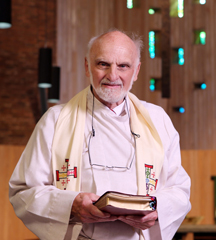 Brueggemann urges us to read the book “thickly,” digging deeply for hidden meanings, encountering the words over and over again, wrestling with the challenging and troubling images, using the book as the catalyst for a give and take relationship with God. He loves to tell the stories of Moses and the prophets arguing with God, struggling with their call and shaping history in the context of that dialogue.
Brueggemann urges us to read the book “thickly,” digging deeply for hidden meanings, encountering the words over and over again, wrestling with the challenging and troubling images, using the book as the catalyst for a give and take relationship with God. He loves to tell the stories of Moses and the prophets arguing with God, struggling with their call and shaping history in the context of that dialogue.
One of the Biblical stories that I have heard Brueggemann tell on different occasions is the tale of Moses advocating for the people of Israel after the incident with the Golden Calf. As he tells the story it is evident that he has read it many times and has peered into the most obscure details in the text. In one lecture, he asked those of us in the audience to ponder why, in the covenant surrounding 10 commandments, the people would agree to the commandments before they even knew what they were. They make the commitment to God before the commandments are revealed. After letting us think for a few moments, he begins to unfold his theory that the experience of Slavery in Egypt led the people to the belief that anything that God had to offer would be better than what they had known in Egypt.
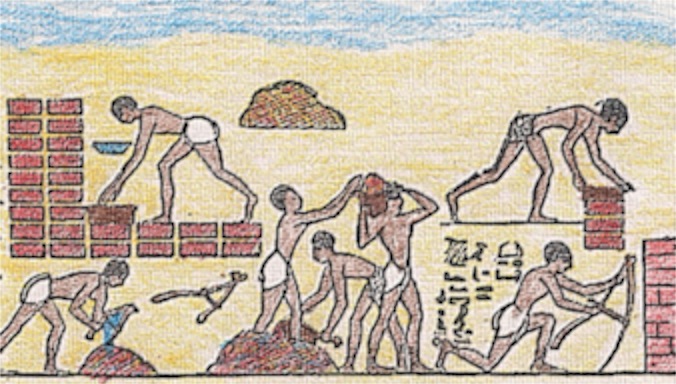 He describes Egyptian slavery as being trapped in the rat race of a consumerist economy. The Israelites were to make bricks. But no matter how many bricks they made, it was never enough. Their population grew. There were more workers. They couldn’t satisfy Pharaoh’s demand. They were forced to work longer hours. The demand could not be satiated. The more bricks they made the more bricks Pharaoh wanted. There was no end to the process. Brueggemann compares this with the consumer society in our contemporary world. The more you buy the more you want. The more you earn, the more you need. There is no winning in a race that has no end.
He describes Egyptian slavery as being trapped in the rat race of a consumerist economy. The Israelites were to make bricks. But no matter how many bricks they made, it was never enough. Their population grew. There were more workers. They couldn’t satisfy Pharaoh’s demand. They were forced to work longer hours. The demand could not be satiated. The more bricks they made the more bricks Pharaoh wanted. There was no end to the process. Brueggemann compares this with the consumer society in our contemporary world. The more you buy the more you want. The more you earn, the more you need. There is no winning in a race that has no end.
The covenant with God is the only way out of that endless cycle.
But the people seem to keep forgetting it. No small amount of our trouble comes from our failures with the 10th commandment: thou shalt not covet. We look at other people and we want what they have. We lose the freedom that God offers. It happens over and over again. Church people seem to be especially bad about the process. I don’t know how many times I have heard wishes that our church would be more like some other church. If only we . . . You can insert almost any phrase here: had a bigger building, had more children, did more advertising, had a better preacher, had a praise band . . . The list goes on and on. That is the point. When you define your life and meaning by your desire for what you do not have, there is no end to the list of things you will desire. In a metaphorical sense, you are right back with the children of Israel in Egypt making bricks in an endless production line. It is slavery.
One of the places where I do some online buying is the well-known web site Amazon.com. Each time I order a book from the site, it recommends six additional books that I would find interesting. Because it is not the only place I purchase books, there is an occasional offer of a book that I have already read, but most often it has six more books that I might buy. Were I to buy any of them, they would be replaced. The automatic marketing tools on the site would continue recommending things for me to buy well beyond my capacity to pay. It even allows the creation of a wish list for those who want to have a permanent condition of wanting things that they do not have. The more bricks you make, the more bricks Pharaoh will demand.
I am really looking forward to this year’s Lenten study. I think that Brueggemann will raise issues that are important for our church to consider. I think that we need to wrestle with the Bible and read it a bit more “thickly.” We are quick to say that God has more truth and light to break forth from the holy word, but often we behave as if we knew it all and possessed all of the answers.
The amazing and wonderful thing about God is that God continually offers another chance at the covenant. We don’t have to live the way we do. We don’t have to think the way we do. God gives us the opportunity to return to the commandments and to the covenant again and again.
Maybe it is time to give up making bricks.
Like many others of our time, I have been deeply influenced by Brueggemann. When I was in seminary, he was teaching at another seminary, Eden, but his books were already becoming influential in academic Bible study. Over the years I have had numerous opportunities to hear him speak and to participate in Bible studies that he has led and each time I have found him to be a unique combination of challenge and inspiration.
That’s appropriate, because the Bible is a tough book. There are plenty of people who try to read the bible “thinly.” A thin reading looks for the most obvious truth, seeks the answers that lie on the surface and pretends to have collected the meaning of the Bible in a single pass. Such an approach seems to be meaningful to some people, and provides the basis for more than a few sermons and the marketing plans of some bookstores, but in the end, I believe misses the truth that lies in the book.

One of the Biblical stories that I have heard Brueggemann tell on different occasions is the tale of Moses advocating for the people of Israel after the incident with the Golden Calf. As he tells the story it is evident that he has read it many times and has peered into the most obscure details in the text. In one lecture, he asked those of us in the audience to ponder why, in the covenant surrounding 10 commandments, the people would agree to the commandments before they even knew what they were. They make the commitment to God before the commandments are revealed. After letting us think for a few moments, he begins to unfold his theory that the experience of Slavery in Egypt led the people to the belief that anything that God had to offer would be better than what they had known in Egypt.

The covenant with God is the only way out of that endless cycle.
But the people seem to keep forgetting it. No small amount of our trouble comes from our failures with the 10th commandment: thou shalt not covet. We look at other people and we want what they have. We lose the freedom that God offers. It happens over and over again. Church people seem to be especially bad about the process. I don’t know how many times I have heard wishes that our church would be more like some other church. If only we . . . You can insert almost any phrase here: had a bigger building, had more children, did more advertising, had a better preacher, had a praise band . . . The list goes on and on. That is the point. When you define your life and meaning by your desire for what you do not have, there is no end to the list of things you will desire. In a metaphorical sense, you are right back with the children of Israel in Egypt making bricks in an endless production line. It is slavery.
One of the places where I do some online buying is the well-known web site Amazon.com. Each time I order a book from the site, it recommends six additional books that I would find interesting. Because it is not the only place I purchase books, there is an occasional offer of a book that I have already read, but most often it has six more books that I might buy. Were I to buy any of them, they would be replaced. The automatic marketing tools on the site would continue recommending things for me to buy well beyond my capacity to pay. It even allows the creation of a wish list for those who want to have a permanent condition of wanting things that they do not have. The more bricks you make, the more bricks Pharaoh will demand.
I am really looking forward to this year’s Lenten study. I think that Brueggemann will raise issues that are important for our church to consider. I think that we need to wrestle with the Bible and read it a bit more “thickly.” We are quick to say that God has more truth and light to break forth from the holy word, but often we behave as if we knew it all and possessed all of the answers.
The amazing and wonderful thing about God is that God continually offers another chance at the covenant. We don’t have to live the way we do. We don’t have to think the way we do. God gives us the opportunity to return to the commandments and to the covenant again and again.
Maybe it is time to give up making bricks.
Copyright © 2012 by Ted Huffman. I wrote this. If you want to copy it, please ask for permission. There is a contact me button at the bottom of this page. If you want to share my blog a friend, please direct your friend to my web site.
In the Headlines
25/02/12 05:05
This language we inherited from the people of England is a really complex method of communicating. People whose native languages are different than English often find our grammar, sentence structure and use of slang to be confusing. When we have had the privilege to host exchange students or other guests from abroad we often find ourselves with an open dictionary trying to explain the nuances of our language. Often we end up laughing at the silliness of it all. No, there are no dogs or parts of dogs in hot dogs. Although the distinction in sound is subtle and very difficult for a native Japanese speaker to hear, we find a big difference between lice and rice.
Then there are the regional variations of our language. To our ears people from New England pronounce bear and beer the same, though we see and hear a big distinction in our version of the language. Down south, my name is said as if it has two syllables: Tay-ed. And when an Australian asks an American if he put the esky in the boot, the American says, “what?” Even when we figure out that we call the boot a trunk, it seems like the wrong place to put a member of the Edmonton Eskimos football team. And Upers (from the upper peninsula of Michigan) think that Esky refers to the city of Escanaba.
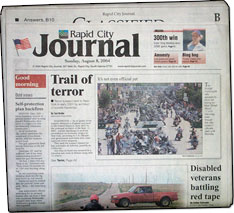 As a reader of newspapers, more and more in their online versions, I have decided that there must be a difference in the language that is used by headline writers and the authors of the articles themselves.
As a reader of newspapers, more and more in their online versions, I have decided that there must be a difference in the language that is used by headline writers and the authors of the articles themselves.
Our local newspaper declares “40th Anniversary Flood Committee to meet next week.” I wonder if we really need a 40th anniversary flood. The original event in 1972 wasn’t all that much fun. Besides any event planned by a committee is bound to be a little strange. I wish we could form a committee to plan a commemoration of the 40th anniversary of the flood that we already had, which comes up this June.
In the same issue of the paper I read that the “South Dakota Senate approves $6M for mountain pine beetle.” These pesky little critters are not in need of additional funding, in my humble opinion. And I oppose the use of any taxpayer monies to fund their destructive activities. Now if the Senate had approved $6M to help mitigate the effects of the beetles . . . O wait, the article and the headline say two different things.
Again in that paper I read “South Dakota lawmakers pass bill on cremation of indigents.” I know that indigent people in our communities can be a problem. We need to find housing and food, job training and other support services. But cremating them seems like a severe punishment. The dictionary defines indigent as “lacking food, clothing, and other necessities of life because of poverty; needy; poor; impoverished.” Once a person has passed away, can they be indigent any more?
 Ah yes, we are capable of using the language to communicate at times, but it can also be a way to communicate meanings that are different from what was intended. Even the venerable New York Times, a newspaper known for having more editors and paying them more than our local newspaper can leave one scratching one’s head after reading the headlines. “Web Deals Cheer Hollywood, Despite Drop in Moviegoers.” It might be more newsworthy had the people who live in Hollywood found cheer rather than their city and perhaps they would be cheered if they would stop dropping moviegoers. If they keep up that kind of nonsense, pretty soon people are going to go to the theatre less often . . . oh wait that’s what the article says.
Ah yes, we are capable of using the language to communicate at times, but it can also be a way to communicate meanings that are different from what was intended. Even the venerable New York Times, a newspaper known for having more editors and paying them more than our local newspaper can leave one scratching one’s head after reading the headlines. “Web Deals Cheer Hollywood, Despite Drop in Moviegoers.” It might be more newsworthy had the people who live in Hollywood found cheer rather than their city and perhaps they would be cheered if they would stop dropping moviegoers. If they keep up that kind of nonsense, pretty soon people are going to go to the theatre less often . . . oh wait that’s what the article says.
What if every newspaper were to require the people who write the headlines to actually read the articles? Hmm . . . that’s probably too much to ask.
The Washington Post recently published “India shuts aid groups over anti-nuclear protests.” If they had only had the space to put the word “down” in the sentence so it would read, “India shuts down aid groups . . .”
 It is not just an east coast phenomenon. The Los Angeles Times ran this headline recently: “A golden spirit stills shines in Randsburg, Calif.” The extra “s” brings to mind the possibility that there may be moonshiners in the golden state. Who knows? Maybe those people who live out in the Mojave Desert need to make their own liquid refreshment from time to time.
It is not just an east coast phenomenon. The Los Angeles Times ran this headline recently: “A golden spirit stills shines in Randsburg, Calif.” The extra “s” brings to mind the possibility that there may be moonshiners in the golden state. Who knows? Maybe those people who live out in the Mojave Desert need to make their own liquid refreshment from time to time.
Do you have to be from Seattle to understand that the headline “Winter Blahs Get the Bluegrass Boot” signals an article about a clogging class? Or is it even safe to assume that readers of the Seattle Times understand what the headline writers were thinking? After all the same issue of the paper had news of the “Afghan Quran Protests.” A literalist might point out that few religious Afghans could be organized to protest the Quran - especially when there are so many people there out protesting the burning of the holy book.
I’m not from Oregon, but I get an interesting mental image trying to picture “Gov. John Kitzhber pushes Oregon lawmakers to move his education bills.” That explains why legislation is such a slow and convoluted process, if you have to shove around a group of people in order to get the paper from one place to another. And as long as I am reading the Oregonian, will “Making Homelessness Visible” help insensitive individuals connect with the people who have no homes?
Here is the good news. You only have to read my rants about the use of language occasionally in this blog – that is assuming you haven’t quit reading and gone on to something more productive by now. My beautiful, talented and extremely tolerant wife has to listen to such complaints every time she is in the same room with a newspaper and me.
And don’t get me started on the ads.
Then there are the regional variations of our language. To our ears people from New England pronounce bear and beer the same, though we see and hear a big distinction in our version of the language. Down south, my name is said as if it has two syllables: Tay-ed. And when an Australian asks an American if he put the esky in the boot, the American says, “what?” Even when we figure out that we call the boot a trunk, it seems like the wrong place to put a member of the Edmonton Eskimos football team. And Upers (from the upper peninsula of Michigan) think that Esky refers to the city of Escanaba.

Our local newspaper declares “40th Anniversary Flood Committee to meet next week.” I wonder if we really need a 40th anniversary flood. The original event in 1972 wasn’t all that much fun. Besides any event planned by a committee is bound to be a little strange. I wish we could form a committee to plan a commemoration of the 40th anniversary of the flood that we already had, which comes up this June.
In the same issue of the paper I read that the “South Dakota Senate approves $6M for mountain pine beetle.” These pesky little critters are not in need of additional funding, in my humble opinion. And I oppose the use of any taxpayer monies to fund their destructive activities. Now if the Senate had approved $6M to help mitigate the effects of the beetles . . . O wait, the article and the headline say two different things.
Again in that paper I read “South Dakota lawmakers pass bill on cremation of indigents.” I know that indigent people in our communities can be a problem. We need to find housing and food, job training and other support services. But cremating them seems like a severe punishment. The dictionary defines indigent as “lacking food, clothing, and other necessities of life because of poverty; needy; poor; impoverished.” Once a person has passed away, can they be indigent any more?

What if every newspaper were to require the people who write the headlines to actually read the articles? Hmm . . . that’s probably too much to ask.
The Washington Post recently published “India shuts aid groups over anti-nuclear protests.” If they had only had the space to put the word “down” in the sentence so it would read, “India shuts down aid groups . . .”

Do you have to be from Seattle to understand that the headline “Winter Blahs Get the Bluegrass Boot” signals an article about a clogging class? Or is it even safe to assume that readers of the Seattle Times understand what the headline writers were thinking? After all the same issue of the paper had news of the “Afghan Quran Protests.” A literalist might point out that few religious Afghans could be organized to protest the Quran - especially when there are so many people there out protesting the burning of the holy book.
I’m not from Oregon, but I get an interesting mental image trying to picture “Gov. John Kitzhber pushes Oregon lawmakers to move his education bills.” That explains why legislation is such a slow and convoluted process, if you have to shove around a group of people in order to get the paper from one place to another. And as long as I am reading the Oregonian, will “Making Homelessness Visible” help insensitive individuals connect with the people who have no homes?
Here is the good news. You only have to read my rants about the use of language occasionally in this blog – that is assuming you haven’t quit reading and gone on to something more productive by now. My beautiful, talented and extremely tolerant wife has to listen to such complaints every time she is in the same room with a newspaper and me.
And don’t get me started on the ads.
Copyright © 2012 by Ted Huffman. I wrote this. If you want to copy it, please ask for permission. There is a contact me button at the bottom of this page. If you want to share my blog a friend, please direct your friend to my web site.
The Fourth Plinth
24/02/12 05:12
When you visit London, one of the must-see areas is Trafalgar Square. I have had the opportunity to visit the space twice, once in 1978 when traveling with my family and again in 2010 when we were in England visiting our daughter. On the second trip, Trafalgar Square was the convenient meeting place for making connections with a friend from our Seminary days who now lives in England. Between our two visits, a major redevelopment of the square was completed in 2003, including the closing of a street to automobile traffic to accommodate increased pedestrian traffic, and a new set of steps leading up to a terrace in front of the National Gallery. The changes mean that one no longer has to dodge taxis to get from the square to the National Gallery. There are also new public restrooms, a café and elevators for those who have difficulty climbing the steps.

Cities need open spaces and places to gather. Our town of Rapid City is just putting the finishing touches on a new Main Street Square that has been designed to provide a similar space, scaled to the size of our city.
Trafalgar Square was a space known as Charing Cross. Plans for development of the space into a public square were begun in the 1820’s. In 1837 funds were approved for construction. The official opening of the square was in 1844, although at that time the paving and fountains were not completed until a year later.
At the center of the square is Nelson’s column, guarded by four lions – or rather four statues of lions. The designer of the square, Charles Barry was upset that the obelisk was placed in the center of his square. He wanted the works of art to be at the edges and corners of the space, leaving the center open. He did plan a pair of dramatic fountains and lots of open space.
The name itself was a matter of considerable controversy and it took a while for authorities to settle on Trafalgar Square. The name commemorates the 1805 Battle of Trafalgar when the British navy defeated the French during the Napoleonic Wars. The name narrowly defeated “King William the Fourth’s Square,” the moniker said to be preferred by the royal family. Technically the royal family owns the square, while the Westminster City Council owns the roads, including the pedestrian area that is now the North terrace.
 There are four plinths designed to hold major sculptures at the corners of the square. The original design by Charles Barry called for two monumental statues. A bronze equestrian statue of George IV tops the first. The statue, originally slated for the Marble Arch, was installed in time for the dedication in 1844. The second remained empty. It was rumored that the Lord Mayor of London wanted the plinth left empty so that it could one day accommodate a statue of him. The plinth was still bare when we visited in 1978. Two other plinths with statues were added. One is topped by a statue of General Sir Charles James Napier and was added in 1855. The other displays a statue of Major-Geneeral Sir Henry Havelock. Though constructed as one of the first two plinths, the empty one has been called the fourth plinth for a long time. In 1998, the city began to display a series of specially commissioned artworks atop the fourth plinth. When we visited in November of 2010, a model of the HMS Victory in a giant glass bottle topped it.
There are four plinths designed to hold major sculptures at the corners of the square. The original design by Charles Barry called for two monumental statues. A bronze equestrian statue of George IV tops the first. The statue, originally slated for the Marble Arch, was installed in time for the dedication in 1844. The second remained empty. It was rumored that the Lord Mayor of London wanted the plinth left empty so that it could one day accommodate a statue of him. The plinth was still bare when we visited in 1978. Two other plinths with statues were added. One is topped by a statue of General Sir Charles James Napier and was added in 1855. The other displays a statue of Major-Geneeral Sir Henry Havelock. Though constructed as one of the first two plinths, the empty one has been called the fourth plinth for a long time. In 1998, the city began to display a series of specially commissioned artworks atop the fourth plinth. When we visited in November of 2010, a model of the HMS Victory in a giant glass bottle topped it.
 The coming of the Olympic games to London this summer has occasioned the commissioning of a new piece of art for the fourth plinth and the much-anticipated unveiling took place yesterday. My first glimpse of the new statue brought a smile to my face and nearly made me giggle. I think it is a wonderful statue for the year of the games. It is a giant statue of a small boy on a rocking horse.
The coming of the Olympic games to London this summer has occasioned the commissioning of a new piece of art for the fourth plinth and the much-anticipated unveiling took place yesterday. My first glimpse of the new statue brought a smile to my face and nearly made me giggle. I think it is a wonderful statue for the year of the games. It is a giant statue of a small boy on a rocking horse.
I don’t know if it there is anything particularly British in the humor that the statue exudes, but it is simply delightful. Surrounded by statues of military heroes, one of which is mounted on a giant horse, there is a child. In the imagination of the child there can be a great leader, or a speedy jockey, or a hero rushing to the rescue. King George the fourth will forever be the king. The boy on the rocking horse might grow up to be king, but his future is still open. There are limitless possibilities in the imagination of the child.
 The people of London do not need my opinion in order to choose their public art. Truth be told, the planners of Main Street Square here in Rapid City didn’t consult me in their choices of artwork. But, for what it is worth, I favor having something atop the empty plinth. There was a type of hopefulness to a city that left space for future artwork. But there was also a type of sadness to a city that couldn’t choose a sculpture more than a century after the base had been erected. There was a sense that the stone might erode and fall down before they got around to placing anything atop the plinth. It carried an air of poor or failed planning.
The people of London do not need my opinion in order to choose their public art. Truth be told, the planners of Main Street Square here in Rapid City didn’t consult me in their choices of artwork. But, for what it is worth, I favor having something atop the empty plinth. There was a type of hopefulness to a city that left space for future artwork. But there was also a type of sadness to a city that couldn’t choose a sculpture more than a century after the base had been erected. There was a sense that the stone might erode and fall down before they got around to placing anything atop the plinth. It carried an air of poor or failed planning.
No longer is the emptiness the focus of one’s vision when standing in the square. No longer is the jarring contrast of three bronze sculptures and one great big ship in a bottle the thing that catches your eye. Now there are four bronze statues. Still, one stands out, as has been the case since the beginning of Trafalgar Square. Monuments to the glorious past of England top three plinths. The final stands as a statement of hope about the future. It is good to remember, but it is also good to hope.
I don’t know if I will make it to England to see the sculpture in person. I have no plans to make such a big trip anytime soon. I do not know how long the new sculpture will remain displayed on the plinth. It has been touted as a project for the year of the Olympics. Perhaps there are plans to move it after the year is finished. On the other hand, the Millennium Wheel still graces the skyline of London more than a decade after it was erected to celebrate a one-year event.
Sometimes change takes more time than anticipated in London.

Cities need open spaces and places to gather. Our town of Rapid City is just putting the finishing touches on a new Main Street Square that has been designed to provide a similar space, scaled to the size of our city.
Trafalgar Square was a space known as Charing Cross. Plans for development of the space into a public square were begun in the 1820’s. In 1837 funds were approved for construction. The official opening of the square was in 1844, although at that time the paving and fountains were not completed until a year later.
At the center of the square is Nelson’s column, guarded by four lions – or rather four statues of lions. The designer of the square, Charles Barry was upset that the obelisk was placed in the center of his square. He wanted the works of art to be at the edges and corners of the space, leaving the center open. He did plan a pair of dramatic fountains and lots of open space.
The name itself was a matter of considerable controversy and it took a while for authorities to settle on Trafalgar Square. The name commemorates the 1805 Battle of Trafalgar when the British navy defeated the French during the Napoleonic Wars. The name narrowly defeated “King William the Fourth’s Square,” the moniker said to be preferred by the royal family. Technically the royal family owns the square, while the Westminster City Council owns the roads, including the pedestrian area that is now the North terrace.


I don’t know if it there is anything particularly British in the humor that the statue exudes, but it is simply delightful. Surrounded by statues of military heroes, one of which is mounted on a giant horse, there is a child. In the imagination of the child there can be a great leader, or a speedy jockey, or a hero rushing to the rescue. King George the fourth will forever be the king. The boy on the rocking horse might grow up to be king, but his future is still open. There are limitless possibilities in the imagination of the child.

No longer is the emptiness the focus of one’s vision when standing in the square. No longer is the jarring contrast of three bronze sculptures and one great big ship in a bottle the thing that catches your eye. Now there are four bronze statues. Still, one stands out, as has been the case since the beginning of Trafalgar Square. Monuments to the glorious past of England top three plinths. The final stands as a statement of hope about the future. It is good to remember, but it is also good to hope.
I don’t know if I will make it to England to see the sculpture in person. I have no plans to make such a big trip anytime soon. I do not know how long the new sculpture will remain displayed on the plinth. It has been touted as a project for the year of the Olympics. Perhaps there are plans to move it after the year is finished. On the other hand, the Millennium Wheel still graces the skyline of London more than a decade after it was erected to celebrate a one-year event.
Sometimes change takes more time than anticipated in London.
Copyright © 2012 by Ted Huffman. I wrote this. If you want to copy it, please ask for permission. There is a contact me button at the bottom of this page. If you want to share my blog a friend, please direct your friend to my web site.
Teaching the Path of Service
23/02/12 05:22
I’ve been involved in the church all of my life. I grew up in the church, I was active in church as a college student and when I completed my education I began to serve congregations. Over the years I have seen the institutional church at its best and at its worst.
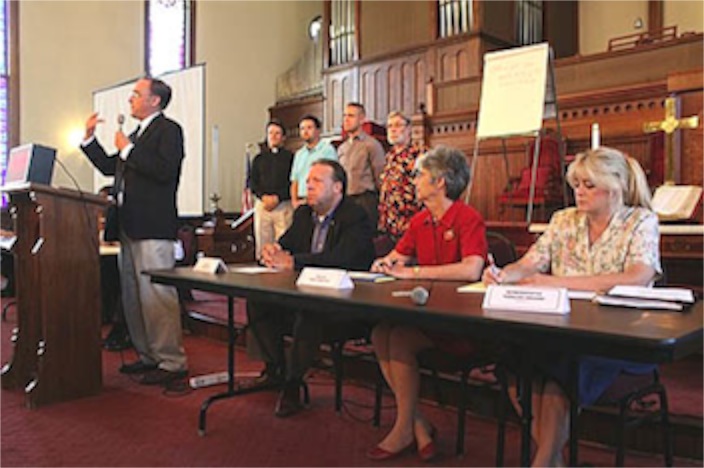 I have been involved in investigations where clergy misconduct was documented and actions recommended. I have been present at meetings where angry statements have been made and feelings have been hurt. I have supported colleagues when they were victims of abuse by bullying church leaders. I have a colleague who was raped in her church office. I have listened as church members reported their anguish over a division in their congregation. I have sat at the table of people who were forced to leave a congregation they had belonged to and loved for years. I have witnessed hostility towards newcomers and visitors.
I have been involved in investigations where clergy misconduct was documented and actions recommended. I have been present at meetings where angry statements have been made and feelings have been hurt. I have supported colleagues when they were victims of abuse by bullying church leaders. I have a colleague who was raped in her church office. I have listened as church members reported their anguish over a division in their congregation. I have sat at the table of people who were forced to leave a congregation they had belonged to and loved for years. I have witnessed hostility towards newcomers and visitors.
I am fully aware that church members can be incredibly mean to each other. I know that there is a considerable amount of behavior in churches that seems to me to be not “Christian” at all. There is no doubt in my mind that church people can be petty, mean spirited, rude, and cruel. No wonder the epistles are filled with advice on how to get along and how to reach beyond differences and disagreements.
But when I look back over my life in the church, these stories of ill behavior are not what I remember. I remember the quiet and faithful service of a church janitor who always worked more hours than those for which she was paid, who made extra trips to the church to make sure it was ready for worship, and who worked even when she was ill because she wanted the church to be clean and welcoming.
I remember the people who quietly paid for a tank of gas when a young woman was trying to make ends meet.
 I remember the gentle servants who fold and collate bulletins, who prepare newsletters for mailing, who water the plants and do all sorts of behind-the-scene work for which they will never receive recognition or even thanks.
I remember the gentle servants who fold and collate bulletins, who prepare newsletters for mailing, who water the plants and do all sorts of behind-the-scene work for which they will never receive recognition or even thanks.
I remember the people who wrote notes of thanks to their pastor.
I remember the workers who turned out to clean up the church yard, to split firewood, to put up the Christmas tree, to set up the fellowship hall and wash the windows.
I remember the camp counselors who gave up a week of their vacation for the sake of the campers.
I remember the people who faithfully visited the old curmudgeon as he became more cranky and ornery and hostile long after it ceased to be any fun simply because they represented the only connection between that person and the church.
I remember the people who came to the funeral of the recluse that no one knew because they were determined to support his brother in the midst of his grief.
I could go on for pages and pages of memories of service that has been given and acts of kindness that I have witnessed. There is a quality of selfless service that one gets to witness when one hangs around the church. Not everyone who attends committee meetings is interested in power and has a need to be in control. Not everyone who pauses for a cup of coffee starts to gossip as soon as they sit down. Sure the church has its share of characters, but it also has more than its share of genuinely faithful servants.
 The question that arises each time I work with the children and the youth of the church, is how we teach the path of service to the next generation. Of course there is no substitute for teaching by example. Youth learn far more from what we do than from what we say. They are keen judges of our character and identity. That is why I am so deeply committed to mentorship as youth prepare for the rite of confirmation. Every young person deserves an “adult guarantor” who is not his or her parent, but another adult who believes in and advocates for that young person. I get to see some examples of excellent parenting skills but even children who grow up with the best of parents need other adults in their lives.
The question that arises each time I work with the children and the youth of the church, is how we teach the path of service to the next generation. Of course there is no substitute for teaching by example. Youth learn far more from what we do than from what we say. They are keen judges of our character and identity. That is why I am so deeply committed to mentorship as youth prepare for the rite of confirmation. Every young person deserves an “adult guarantor” who is not his or her parent, but another adult who believes in and advocates for that young person. I get to see some examples of excellent parenting skills but even children who grow up with the best of parents need other adults in their lives.
I also am convinced that our youth learn best when they engage in hands on mission. I’m not a big fan of youth raising funds for their own programs and projects. I know it is necessary for youth to work and save for trips and other special events, but if that is all that occurs in a church youth group I fear that the youth will think that church life is about getting things for oneself. The youth in our church provide leadership in raising funds for Church Response, in raising food for hungry people in our community, and in raising funds and awareness for our local Big Brothers Big Sisters organization. Ours isn’t anywhere near the largest congregation in our city, but our youth almost always are the biggest contributors to the annual Bowl for Kids sake fund raiser for Big Brothers Big Sisters. The only youth group to exceed them in the past decade is the honor society of a high school with 2,000 students. There isn’t another church group that comes close. I am not saying this to brag, but rather to identify something that is very important in the kind of youth ministry that we do in our congregation.
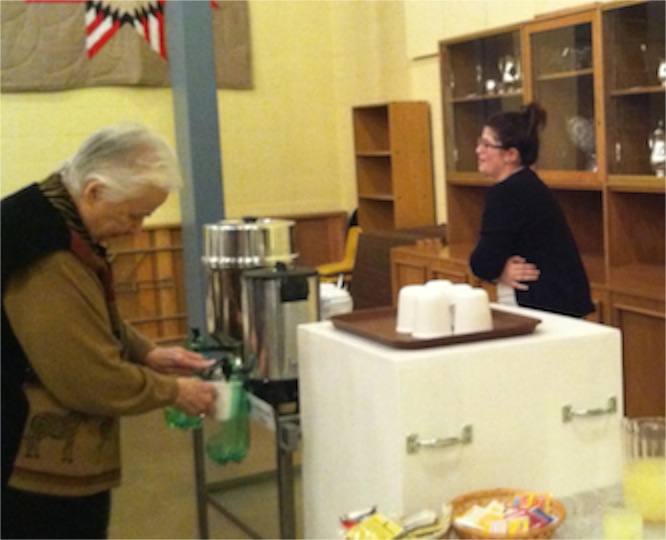 We are in the business of teaching discipleship and service. We are not about trying to be the biggest, the most fun, or the loudest youth group in town.
We are in the business of teaching discipleship and service. We are not about trying to be the biggest, the most fun, or the loudest youth group in town.
The long-term track record of church youth groups isn’t particularly good. Youth programs that are judged to be successful tend to produce adults who do not participate in the church. Our communities are filled with adults who were involved in youth programs that they continue to describe as exciting, but who never grasped that belonging to a church is about serving others, not about being entertained or about what you get for yourself.
The biggest complaint I hear about churches is: “it doesn’t meet my needs.”
We remain committed to helping young people discover that there is far more meaning in meeting the needs of others than in pursuing what’s in it for you.

I am fully aware that church members can be incredibly mean to each other. I know that there is a considerable amount of behavior in churches that seems to me to be not “Christian” at all. There is no doubt in my mind that church people can be petty, mean spirited, rude, and cruel. No wonder the epistles are filled with advice on how to get along and how to reach beyond differences and disagreements.
But when I look back over my life in the church, these stories of ill behavior are not what I remember. I remember the quiet and faithful service of a church janitor who always worked more hours than those for which she was paid, who made extra trips to the church to make sure it was ready for worship, and who worked even when she was ill because she wanted the church to be clean and welcoming.
I remember the people who quietly paid for a tank of gas when a young woman was trying to make ends meet.

I remember the people who wrote notes of thanks to their pastor.
I remember the workers who turned out to clean up the church yard, to split firewood, to put up the Christmas tree, to set up the fellowship hall and wash the windows.
I remember the camp counselors who gave up a week of their vacation for the sake of the campers.
I remember the people who faithfully visited the old curmudgeon as he became more cranky and ornery and hostile long after it ceased to be any fun simply because they represented the only connection between that person and the church.
I remember the people who came to the funeral of the recluse that no one knew because they were determined to support his brother in the midst of his grief.
I could go on for pages and pages of memories of service that has been given and acts of kindness that I have witnessed. There is a quality of selfless service that one gets to witness when one hangs around the church. Not everyone who attends committee meetings is interested in power and has a need to be in control. Not everyone who pauses for a cup of coffee starts to gossip as soon as they sit down. Sure the church has its share of characters, but it also has more than its share of genuinely faithful servants.

I also am convinced that our youth learn best when they engage in hands on mission. I’m not a big fan of youth raising funds for their own programs and projects. I know it is necessary for youth to work and save for trips and other special events, but if that is all that occurs in a church youth group I fear that the youth will think that church life is about getting things for oneself. The youth in our church provide leadership in raising funds for Church Response, in raising food for hungry people in our community, and in raising funds and awareness for our local Big Brothers Big Sisters organization. Ours isn’t anywhere near the largest congregation in our city, but our youth almost always are the biggest contributors to the annual Bowl for Kids sake fund raiser for Big Brothers Big Sisters. The only youth group to exceed them in the past decade is the honor society of a high school with 2,000 students. There isn’t another church group that comes close. I am not saying this to brag, but rather to identify something that is very important in the kind of youth ministry that we do in our congregation.

The long-term track record of church youth groups isn’t particularly good. Youth programs that are judged to be successful tend to produce adults who do not participate in the church. Our communities are filled with adults who were involved in youth programs that they continue to describe as exciting, but who never grasped that belonging to a church is about serving others, not about being entertained or about what you get for yourself.
The biggest complaint I hear about churches is: “it doesn’t meet my needs.”
We remain committed to helping young people discover that there is far more meaning in meeting the needs of others than in pursuing what’s in it for you.
Copyright © 2012 by Ted Huffman. I wrote this. If you want to copy it, please ask for permission. There is a contact me button at the bottom of this page. If you want to share my blog a friend, please direct your friend to my web site.
Ash Wednesday 2012
22/02/12 05:37
“Remember that you are dust, and to dust you shall return.” It is a simple reminder of our mortality. It sometimes surprises me how little we think of our own death and how much of our lives we live as if we might go on forever. Our thinking is, in part, a testament to the power of life. Even in the face of the death of a loved one, in the depths of grief, life triumphs. We discover the strength to go on with our lives. We find sources of hope. We endure.

Ash Wednesday is one of those days that is really different for me as a pastor. There are small gestures of touch that are a part of my job. I shake hands after worship. I offer blessings in homes and hospitals. I place my hand on the shoulder of another. But on Ash Wednesday, I touch the people who come to the service one by one. As others wait, I dip my fingers in the ashes and make the sign of the cross on each person and repeat the words: “Remember that you are dust, and to dust you shall return.”
I will not be pastor of these people forever. Our moment is finite. It will come to an end. For some of the people I greet this Ash Wednesday, I will officiate at their funeral. Others will live beyond the time of my being pastor in this place. We live and work in a narrow window of time.
Having the people come by one by one, looking each in the eyes, and saying the simple, yet powerful words – these things never fail to move me deeply.
 For much of our lives, we focus our attention on differences. We silently measure differences in wealth, power, beauty, fame, and more. We evaluate others in part by whether or not they pose a threat to our way of life. Ash Wednesday reminds us that we all share the simple fact of mortality.
For much of our lives, we focus our attention on differences. We silently measure differences in wealth, power, beauty, fame, and more. We evaluate others in part by whether or not they pose a threat to our way of life. Ash Wednesday reminds us that we all share the simple fact of mortality.
In ancient times, ashes were a sign of mourning. The rituals of grieving involved dusting oneself with ashes. The sadness felt on the inside found an outward expression in a simple ritual. Ashes were common and readily available. Because fires were used for cooking and heating, every home had an ample supply. There are many places in the Bible where the ashes of mourning were also used as a sign of sadness for wrongs or sins committed. Ashes became a sign of repentance – of turning away from hurtful actions. Job, Jeremiah, Daniel and many others used ashes as a sign of making significant changes in their lives.
We use ashes to mark the beginning of Lent. Our confirmation class carefully burned the palms from last year’s Palm Sunday celebrations. The ashes were saved, sifted and mixed with a few drops of oil. They sit in my office awaiting the ceremonies of this day. The day marks the beginning of Lent. Ash Wednesday does not stand alone. It is the beginning of a season of repentance. There are plenty of Biblical stories that speak of 40-days of fasting. Moses and the people of Israel fasted and repented for 40 days after the making of the golden calf. Contemporary Jews have a 40-day period of repenting during the High Holy Days from Rosh Chodesh Elul to Yom Kippur. Jesus spent 40 days in the wilderness fasting and praying. During this time he was also tempted. Contemporary Christian Lenten observances last for forty days. Sundays are not counted, so we have six weeks of Lent.
Lent is a traditional time to give up luxuries. In Ireland, Ash Wednesday is the national No Smoking Day. Making a connection between quitting smoking and giving up luxury for Lent works in that nation. Many Christians think of small luxuries that they can give up as a sign of commitment to a different way of life. Sometimes the things given up are not all that significant. The process of giving things up can be deeply meaningful or a fairly shallow ritual – it all depends on the attitude of the person.
We view lent as a time when we should give something up – or feel guilty because we don’t. But Ash Wednesday gives us an opportunity to think differently. A season of repentance can be a season of new thinking. What if we gave up old ways of thinking for Lent? What would it mean to give up our anxieties? How could we give up judging others? Imagine what would happen if we decided to give up complaining? Could we give up feeling discouraged? Maybe this is the year to give up making excuses? Is this the time to give up worry?
 Today we begin. Ash Wednesday is not an end in and of itself. It is the start of a journey. We know a bit of the conclusion of that journey. God’s promise to us is that the time of darkness will end – the light will come. Making real changes in our lives takes time. Lent gives us the time. It can be a season of giving up old ways of thinking and embracing new relationships with each other and with God.
Today we begin. Ash Wednesday is not an end in and of itself. It is the start of a journey. We know a bit of the conclusion of that journey. God’s promise to us is that the time of darkness will end – the light will come. Making real changes in our lives takes time. Lent gives us the time. It can be a season of giving up old ways of thinking and embracing new relationships with each other and with God.
In our family, Ash Wednesday will forever be a day that carries a twinge of grief. It was on Ash Wednesday last year that Susan’s father died. This wonderful, kind, loving man ended his life’s journey in the early hours of the day. He simply didn’t wake up. We began our Lent with a season of grief. It took us a while to imagine what it meant for us to go on now that he has died. But our happy memories far outweigh our sad ones. We cannot think of him without thinking of how much he meant to us and how good it was to have him in our lives. Grief gives way to hope. Even though we will all one day die from this life, God’s gift of life has the final victory.
Still it is good each year to pause and to be reminded that we are mortal. It is good to remember that we are dust and to dust we will return.

Ash Wednesday is one of those days that is really different for me as a pastor. There are small gestures of touch that are a part of my job. I shake hands after worship. I offer blessings in homes and hospitals. I place my hand on the shoulder of another. But on Ash Wednesday, I touch the people who come to the service one by one. As others wait, I dip my fingers in the ashes and make the sign of the cross on each person and repeat the words: “Remember that you are dust, and to dust you shall return.”
I will not be pastor of these people forever. Our moment is finite. It will come to an end. For some of the people I greet this Ash Wednesday, I will officiate at their funeral. Others will live beyond the time of my being pastor in this place. We live and work in a narrow window of time.
Having the people come by one by one, looking each in the eyes, and saying the simple, yet powerful words – these things never fail to move me deeply.

In ancient times, ashes were a sign of mourning. The rituals of grieving involved dusting oneself with ashes. The sadness felt on the inside found an outward expression in a simple ritual. Ashes were common and readily available. Because fires were used for cooking and heating, every home had an ample supply. There are many places in the Bible where the ashes of mourning were also used as a sign of sadness for wrongs or sins committed. Ashes became a sign of repentance – of turning away from hurtful actions. Job, Jeremiah, Daniel and many others used ashes as a sign of making significant changes in their lives.
We use ashes to mark the beginning of Lent. Our confirmation class carefully burned the palms from last year’s Palm Sunday celebrations. The ashes were saved, sifted and mixed with a few drops of oil. They sit in my office awaiting the ceremonies of this day. The day marks the beginning of Lent. Ash Wednesday does not stand alone. It is the beginning of a season of repentance. There are plenty of Biblical stories that speak of 40-days of fasting. Moses and the people of Israel fasted and repented for 40 days after the making of the golden calf. Contemporary Jews have a 40-day period of repenting during the High Holy Days from Rosh Chodesh Elul to Yom Kippur. Jesus spent 40 days in the wilderness fasting and praying. During this time he was also tempted. Contemporary Christian Lenten observances last for forty days. Sundays are not counted, so we have six weeks of Lent.
Lent is a traditional time to give up luxuries. In Ireland, Ash Wednesday is the national No Smoking Day. Making a connection between quitting smoking and giving up luxury for Lent works in that nation. Many Christians think of small luxuries that they can give up as a sign of commitment to a different way of life. Sometimes the things given up are not all that significant. The process of giving things up can be deeply meaningful or a fairly shallow ritual – it all depends on the attitude of the person.
We view lent as a time when we should give something up – or feel guilty because we don’t. But Ash Wednesday gives us an opportunity to think differently. A season of repentance can be a season of new thinking. What if we gave up old ways of thinking for Lent? What would it mean to give up our anxieties? How could we give up judging others? Imagine what would happen if we decided to give up complaining? Could we give up feeling discouraged? Maybe this is the year to give up making excuses? Is this the time to give up worry?

In our family, Ash Wednesday will forever be a day that carries a twinge of grief. It was on Ash Wednesday last year that Susan’s father died. This wonderful, kind, loving man ended his life’s journey in the early hours of the day. He simply didn’t wake up. We began our Lent with a season of grief. It took us a while to imagine what it meant for us to go on now that he has died. But our happy memories far outweigh our sad ones. We cannot think of him without thinking of how much he meant to us and how good it was to have him in our lives. Grief gives way to hope. Even though we will all one day die from this life, God’s gift of life has the final victory.
Still it is good each year to pause and to be reminded that we are mortal. It is good to remember that we are dust and to dust we will return.
Copyright © 2012 by Ted Huffman. I wrote this. If you want to copy it, please ask for permission. There is a contact me button at the bottom of this page. If you want to share my blog a friend, please direct your friend to my web site.
Much Ado about Nothing
21/02/12 05:50
The Shakespeare play has a rather simple plot line. There are two couples. Benedick and Beatrice both talk about how much they dislike romance, love and marriage. They also dislike each other. Claudio and Hero are so much in love that they can’t find the words to say to each other. With a lot of gossip and rumor and a little overhearing of conversations, Benedick and Beatrice are tricked into expressing their love and Claudio rejects Hero. The Constable uncovers the trickery of Don John, the villain, who is captured and the two couples marry and presumably live happily ever after.
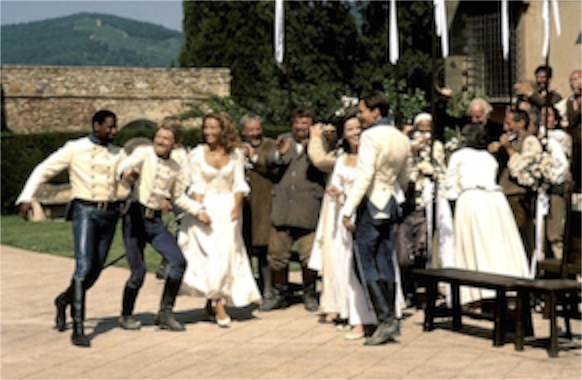 It is a fun little play. Its title is more famous than the play itself. The phrase is often used when people get unnecessarily upset over things, when rumors are proven false, and when too much attention is given to a small problem.
It is a fun little play. Its title is more famous than the play itself. The phrase is often used when people get unnecessarily upset over things, when rumors are proven false, and when too much attention is given to a small problem.
The nature of nothing – or perhaps the existence of anything at all – has been a question that people have pondered from the beginnings of human consciousness. Why do things exist? Is there a place, or was there a time when nothing existed at all? It is the question of cosmologists in every generation.
The first account of creation in Genesis comments on the question in the second verse: “The earth was without form and void, and darkness was upon the face of the deep; and the Spirit of God was moving over the face of the waters.” It starts to describe nothing: “without form and void, and darkness . . .” but can’t quite describe such a thing as total nothingness and so comes up with something over which the Spirit of God was moving. There is no particular description of “the face of the waters,” but the use of the word “waters” implies something that is known and recognizable.
By the second century of the Christian era, the discussion of what exists before creation was common among theologians. Two Latin phrases illustrate two sides of the argument. “Creatio ex nihilo” posits that all that exists came from nothing.
“Creatio ex material” is the theory that there was some pre-existent, eternal matter.
Physicists have returned to that argument in modern cosmology theory. Lawrence Krauss, professor at Arizona State University, has a new book, “A Universe From Nothing” in which he states that science may be able, at some time in the near future, to explain how our universe came from nothingness. And then he hedges his bet a bit by stating that if not nothingness, then something very close to it. If you understand the Universe as the combination of sub-atomic particles, you end up with the question: “Where did the particles come from?”
Theologians have no problem with naming God as the creative force that is at the origin of the existence of everything. Secular physicists in our time seem to chafe at the use of a concept of God. They seem to want to declare their atheism. Christopher Hitchens book, “God is Not Great,” Richard Dawkins, “The God Delusion,” and Stephen Hawking’s “The Grand Design,” are all relatively recent books by physicists that try to explain the universe without God. I am not a physicist. My mathematical skills are limited. But I find the arguments of these cosmologists to be unconvincing. In fact, I think it is a stretch to claim that they have presented anything that is very new in their books. To use the Latin terminology, they have written “creatio ex material.” They have added some sophisticated observations to some very ancient ideas.
 Dr. Krauss tries to push the argument into new territory. What he claims is that modern science has come up with a better way of explaining nothingness. What has for millennia been a vague philosophical concept now is directly observable according to Krauss. He describes three kinds of nothingness. The first is empty space. It worked for ancients who used only their eyes to scan the night skies. It certainly appears that there is a lot of emptiness between the stars. However, scientists now know that the space is filled with energy. There are measurable electromagnetic fields and the movements of stars, planets and other things in the universe has led physicists to theorize that there are “virtual particles” and “borrowed energy” that explain some of the randomness of the universe. (Remember, I’m not a physicist and I don’t always explain these things as well as a trained scientist.)
Dr. Krauss tries to push the argument into new territory. What he claims is that modern science has come up with a better way of explaining nothingness. What has for millennia been a vague philosophical concept now is directly observable according to Krauss. He describes three kinds of nothingness. The first is empty space. It worked for ancients who used only their eyes to scan the night skies. It certainly appears that there is a lot of emptiness between the stars. However, scientists now know that the space is filled with energy. There are measurable electromagnetic fields and the movements of stars, planets and other things in the universe has led physicists to theorize that there are “virtual particles” and “borrowed energy” that explain some of the randomness of the universe. (Remember, I’m not a physicist and I don’t always explain these things as well as a trained scientist.)
The second “nothing” is not directly observable. This, according to Krauss, is what exists when there is no space and no time. He describes the universe as a “bubble of space-time” that pops into existence, like a bubble in boiling water. This theoretical, though not observable nothingness still conforms to the laws of physics according to Krauss.
Krauss goes on to posit a third and deeper nothingness where even the laws of physics do not exist. I’m not sure that he has succeeded in making the argument that the third “nothing” is distinct from the second “nothing.” At least the existence of the laws of physics where there is no time and space seems to be pure speculation. It seems possible to me that Krauss’ second and third nothingness are the same. Krauss, however, wants to make an argument for another popular theory of modern cosmology: multiverse. The basic theory is that there can exist multiple universes that may or may not conform to the same laws of physics.
These physical cosmologists, Hitchens, Dawkins and Hawking, and perhaps Krauss as well, go so far into speculative physics that their claim that science is based on actual observation seems to be at best questionable. Their argument that God and religion are human inventions would almost make sense if they didn’t seem to be incapable of seeing that their so called “laws” of physics are every bit an invention of human intellectual endeavor. The very thing they criticize about religion is inherent in what they call science.
From my point of view, it looks like they are engaged in theology, but they can’t bring themselves to use the word God. I’ve heard a four-year-old ask, “What happened before I was born?” and a six year old ask, “What was before God?” The questions are not significantly different from those of modern cosmologists.
During the Middle Ages, theology was dubbed “the Queen of the Sciences.” In more recent times, Physics has been called the “King of the Sciences.” It seems to me that it may all be much ado about nothing. Even Shakespeare understood that you can’t have the king without the queen.

The nature of nothing – or perhaps the existence of anything at all – has been a question that people have pondered from the beginnings of human consciousness. Why do things exist? Is there a place, or was there a time when nothing existed at all? It is the question of cosmologists in every generation.
The first account of creation in Genesis comments on the question in the second verse: “The earth was without form and void, and darkness was upon the face of the deep; and the Spirit of God was moving over the face of the waters.” It starts to describe nothing: “without form and void, and darkness . . .” but can’t quite describe such a thing as total nothingness and so comes up with something over which the Spirit of God was moving. There is no particular description of “the face of the waters,” but the use of the word “waters” implies something that is known and recognizable.
By the second century of the Christian era, the discussion of what exists before creation was common among theologians. Two Latin phrases illustrate two sides of the argument. “Creatio ex nihilo” posits that all that exists came from nothing.
“Creatio ex material” is the theory that there was some pre-existent, eternal matter.
Physicists have returned to that argument in modern cosmology theory. Lawrence Krauss, professor at Arizona State University, has a new book, “A Universe From Nothing” in which he states that science may be able, at some time in the near future, to explain how our universe came from nothingness. And then he hedges his bet a bit by stating that if not nothingness, then something very close to it. If you understand the Universe as the combination of sub-atomic particles, you end up with the question: “Where did the particles come from?”
Theologians have no problem with naming God as the creative force that is at the origin of the existence of everything. Secular physicists in our time seem to chafe at the use of a concept of God. They seem to want to declare their atheism. Christopher Hitchens book, “God is Not Great,” Richard Dawkins, “The God Delusion,” and Stephen Hawking’s “The Grand Design,” are all relatively recent books by physicists that try to explain the universe without God. I am not a physicist. My mathematical skills are limited. But I find the arguments of these cosmologists to be unconvincing. In fact, I think it is a stretch to claim that they have presented anything that is very new in their books. To use the Latin terminology, they have written “creatio ex material.” They have added some sophisticated observations to some very ancient ideas.

The second “nothing” is not directly observable. This, according to Krauss, is what exists when there is no space and no time. He describes the universe as a “bubble of space-time” that pops into existence, like a bubble in boiling water. This theoretical, though not observable nothingness still conforms to the laws of physics according to Krauss.
Krauss goes on to posit a third and deeper nothingness where even the laws of physics do not exist. I’m not sure that he has succeeded in making the argument that the third “nothing” is distinct from the second “nothing.” At least the existence of the laws of physics where there is no time and space seems to be pure speculation. It seems possible to me that Krauss’ second and third nothingness are the same. Krauss, however, wants to make an argument for another popular theory of modern cosmology: multiverse. The basic theory is that there can exist multiple universes that may or may not conform to the same laws of physics.
These physical cosmologists, Hitchens, Dawkins and Hawking, and perhaps Krauss as well, go so far into speculative physics that their claim that science is based on actual observation seems to be at best questionable. Their argument that God and religion are human inventions would almost make sense if they didn’t seem to be incapable of seeing that their so called “laws” of physics are every bit an invention of human intellectual endeavor. The very thing they criticize about religion is inherent in what they call science.
From my point of view, it looks like they are engaged in theology, but they can’t bring themselves to use the word God. I’ve heard a four-year-old ask, “What happened before I was born?” and a six year old ask, “What was before God?” The questions are not significantly different from those of modern cosmologists.
During the Middle Ages, theology was dubbed “the Queen of the Sciences.” In more recent times, Physics has been called the “King of the Sciences.” It seems to me that it may all be much ado about nothing. Even Shakespeare understood that you can’t have the king without the queen.
Copyright © 2012 by Ted Huffman. I wrote this. If you want to copy it, please ask for permission. There is a contact me button at the bottom of this page. If you want to share my blog a friend, please direct your friend to my web site.
Reflecting on the Death Penalty
20/02/12 05:57
I have blogged about the death penalty at least once before and I am not sure that I have much to add to the long-standing arguments that have already been made. On the one hand, the proponents of the death penalty argue that there are some crimes that are so heinous that they warrant the worst punishment that society can hand out. Many proponents of the penalty argue that state executions serve as deterrents to violent crimes. Those who do not make the deterrent argument will at least argue that possibility of future crimes by that individual criminal is completely eliminated. There is also a compassionate argument offered in favor of the death penalty that considers the feelings of the families of victims. There is a belief that an execution brings events surrounding the loss to a final conclusion. The term “closure” is often used to describe the situation where there can be no more trials, no more appeals, no more legal actions surrounding the crime that so injured the victim’s family.
Opponents offer arguments that there is an inherent hypocrisy in the state engaging in killing to demonstrate that killing is wrong. They cite statistics to support their belief that the death penalty is not an effective deterrent to crime. They also demonstrate compassion for the families of victims but offer their belief that such a loss is something from which one never can fully recover. They believe that closure is impossible. The loss cannot be forgotten. Life cannot return to normal. People survive the loss of loved ones. They do not get over that loss. Opponents of the death penalty often cite the statistics about the majority of countries that no longer practice the death penalty and portray the laws in most states that do practice the penalty as a relic of pre-modern societies that has been eliminated in most parts of the world.
I once read that on topics such as the death penalty, people rarely change their opinions. Even when opportunities are provided for reasoned debate, people are unlikely to be persuaded to change their beliefs. The one argument that has produced changes in opinions about the law has centered about the inability of the state to administer the death penalty in a fair manner. States with a high number of executions inadvertently execute people who were wrongly convicted of their crimes. Guilty persons escape punishment because of failures of our human-administered justice system. The current suspension of executions in the state of Illinois is based on substantial evidence that even with complex processes of appeals and many levels of re-examination of previous decisions the state was incapable of administering a system that was fair. The presence of the death penalty acted as a deterrent to justice.
Our state of South Dakota, however, finds itself in a much different position. We are a state with a small population and crimes in which the death penalty is considered are rare. We currently have five persons who have been convicted of murder and sentenced to death who are awaiting execution pending the outcome of further legal proceedings. Cases are handled individually and very carefully. In these cases there is very little possibility that the convicted persons are not guilty of the crimes.
The government in South Dakota has executed 15 persons. The first, Jack McCall, was the killer of Wild Bill Hickock. Three more were executed under the territorial government before Statehood was established. After the establishment of the state, ten more persons were executed by hanging before the death penalty was abolished in South Dakota in 1915. A new law reinstated the death penalty in 1933 and one person was executed by electric chair in 1947. This was the second to last use of the electric chair by any state. In 1972 a ruling by the United States Supreme court resulted in a moratorium on all death penalties that remained until 1976. South Dakota’s current death penalty law was the first law signed by Governor Bill Janklow in 1979.
Under the new law, only one person has been executed. Elijah Page was executed by lethal injection in July 2007. He was convicted of the murder of Chester Allan Poage. He voluntarily suspended his appeals and directed his attorneys to allow his execution to proceed. The process was relatively painless. The drugs administered through an IV first put him to sleep before the lethal dose was administered.
Now South Dakota has a new prisoner on death row that is asking to be executed. Eric Robert pleaded guilty to killing prison guard Ronald Johnson in an escape attempt. He then asked the judge for the death penalty. He has instructed his attorneys not to appeal or to argue against the death sentence. The South Dakota Supreme Court has appointed Randall Connelly of Rapid City to submit friend-of-the-court briefs and oral arguments on whether the death penalty is appropriate in the case in order to have two sides argued in the mandatory appeal.
It appears that in its modern application, the death penalty in South Dakota is a form of state-assisted suicide. Prisoners who do not want to die have decades of appeals, re-trials and other legal maneuvers that can stall execution. The only ones actually executed by the state are those who choose to die.
The situation brings forth a new possibility in the discussion of the death penalty. What if death by lethal injection is not the worst punishment that the state can hand out? What if those convicted of crimes see death as preferable to life in prison? The arguments about the death penalty have, in the past, assumed that death was the most severe punishment that the state could administer. The current situation in South Dakota questions that assumption.
As one who lost a sister to murder decades ago, I believe that victims of crimes need to look beyond the state for justice. Peace comes from trusting God to be the arbitrator of justice and accepting that state systems of justice, though well meaning and necessary, are always prone to mistakes. We are human and human justice is incomplete and imperfect. Final justice comes from God. With that belief, I don’t think the state should grant the wishes of prisoners to die. In as much as we have the ability, extending life as long as possible giving the criminal more days to think of the crime with no easy exits from the reality of their situation seems like a more severe punishment. If the families of the victim have to live with the crime for the rest of their lives, why not the criminal as well?
There are no easy answers and I suspect that the arguments will continue for many more years.
In the meantime, my sympathies lie with those who have lost family members to violent crimes. My passion lies with those who work daily to prevent the crimes from occurring in the first place.
Opponents offer arguments that there is an inherent hypocrisy in the state engaging in killing to demonstrate that killing is wrong. They cite statistics to support their belief that the death penalty is not an effective deterrent to crime. They also demonstrate compassion for the families of victims but offer their belief that such a loss is something from which one never can fully recover. They believe that closure is impossible. The loss cannot be forgotten. Life cannot return to normal. People survive the loss of loved ones. They do not get over that loss. Opponents of the death penalty often cite the statistics about the majority of countries that no longer practice the death penalty and portray the laws in most states that do practice the penalty as a relic of pre-modern societies that has been eliminated in most parts of the world.
I once read that on topics such as the death penalty, people rarely change their opinions. Even when opportunities are provided for reasoned debate, people are unlikely to be persuaded to change their beliefs. The one argument that has produced changes in opinions about the law has centered about the inability of the state to administer the death penalty in a fair manner. States with a high number of executions inadvertently execute people who were wrongly convicted of their crimes. Guilty persons escape punishment because of failures of our human-administered justice system. The current suspension of executions in the state of Illinois is based on substantial evidence that even with complex processes of appeals and many levels of re-examination of previous decisions the state was incapable of administering a system that was fair. The presence of the death penalty acted as a deterrent to justice.
Our state of South Dakota, however, finds itself in a much different position. We are a state with a small population and crimes in which the death penalty is considered are rare. We currently have five persons who have been convicted of murder and sentenced to death who are awaiting execution pending the outcome of further legal proceedings. Cases are handled individually and very carefully. In these cases there is very little possibility that the convicted persons are not guilty of the crimes.
The government in South Dakota has executed 15 persons. The first, Jack McCall, was the killer of Wild Bill Hickock. Three more were executed under the territorial government before Statehood was established. After the establishment of the state, ten more persons were executed by hanging before the death penalty was abolished in South Dakota in 1915. A new law reinstated the death penalty in 1933 and one person was executed by electric chair in 1947. This was the second to last use of the electric chair by any state. In 1972 a ruling by the United States Supreme court resulted in a moratorium on all death penalties that remained until 1976. South Dakota’s current death penalty law was the first law signed by Governor Bill Janklow in 1979.
Under the new law, only one person has been executed. Elijah Page was executed by lethal injection in July 2007. He was convicted of the murder of Chester Allan Poage. He voluntarily suspended his appeals and directed his attorneys to allow his execution to proceed. The process was relatively painless. The drugs administered through an IV first put him to sleep before the lethal dose was administered.
Now South Dakota has a new prisoner on death row that is asking to be executed. Eric Robert pleaded guilty to killing prison guard Ronald Johnson in an escape attempt. He then asked the judge for the death penalty. He has instructed his attorneys not to appeal or to argue against the death sentence. The South Dakota Supreme Court has appointed Randall Connelly of Rapid City to submit friend-of-the-court briefs and oral arguments on whether the death penalty is appropriate in the case in order to have two sides argued in the mandatory appeal.
It appears that in its modern application, the death penalty in South Dakota is a form of state-assisted suicide. Prisoners who do not want to die have decades of appeals, re-trials and other legal maneuvers that can stall execution. The only ones actually executed by the state are those who choose to die.
The situation brings forth a new possibility in the discussion of the death penalty. What if death by lethal injection is not the worst punishment that the state can hand out? What if those convicted of crimes see death as preferable to life in prison? The arguments about the death penalty have, in the past, assumed that death was the most severe punishment that the state could administer. The current situation in South Dakota questions that assumption.
As one who lost a sister to murder decades ago, I believe that victims of crimes need to look beyond the state for justice. Peace comes from trusting God to be the arbitrator of justice and accepting that state systems of justice, though well meaning and necessary, are always prone to mistakes. We are human and human justice is incomplete and imperfect. Final justice comes from God. With that belief, I don’t think the state should grant the wishes of prisoners to die. In as much as we have the ability, extending life as long as possible giving the criminal more days to think of the crime with no easy exits from the reality of their situation seems like a more severe punishment. If the families of the victim have to live with the crime for the rest of their lives, why not the criminal as well?
There are no easy answers and I suspect that the arguments will continue for many more years.
In the meantime, my sympathies lie with those who have lost family members to violent crimes. My passion lies with those who work daily to prevent the crimes from occurring in the first place.
Copyright © 2012 by Ted Huffman. I wrote this. If you want to copy it, please ask for permission. There is a contact me button at the bottom of this page. If you want to share my blog a friend, please direct your friend to my web site.
Transfiguration
19/02/12 05:14

I sometimes think that I should be better at remembering sermons that I have given in past years. In some cases, I can remember how I felt or the circumstances better than the actual sermons. I can tell the story of my first sermon in a congregation I served as a student, but I don’t know the text or the content of the sermon. I have kept some of my old sermons and they often surprise me. From my current perspective, I think that some of my early sermons were pretty awful. I guess that congregations can be pretty tolerant. People used to tell me they enjoyed my sermons, but when I read some of them, I now wonder why.
The holidays that repeat every year are sometimes very challenging. Christmas and Easter are generally the largest congregations we face each year, but there is little expectation of dramatic new ideas or prophetic preaching on those occasions. People come to church in observance of family traditions and in celebration of holidays. The folks who don’t come to church regularly throughout the rest of the year generally aren’t drawn to the church by the power of preaching.
Holidays that are turning points in the Christian calendar and not observed by the wider community are challenging in different ways. Reign of Christ Sunday and the 1st Sunday of Advent are the last and first days of the Christian calendar. They are important days in the cycle of life inside of the church, but they aren’t recognized as holidays outside of the church. There are no marketing campaigns in retail stores geared around those days. The rest of the world is focused on Christmas shopping instead of the mood and tone of the church holidays.
Transfiguration Sunday is a similar holiday. In the secular world, the stores have just taken down their Valentine’s Day displays. Some stores have some mildly patriotic displays geared around the President’s Day holiday, but most are taking out the pastel colors and pictures of baby chicks in anticipation of Easter. Jelly beans are replacing boxes of chocolates on the shelves in the grocery store.
Transfiguration isn’t one of the really big holidays in part because it is not well understood. It is the last Sunday before Ash Wednesday. When observances of fasts were more severe, the holidays that preceded fasts gained significance simply through the cycles of feast and scarcity. The story of the transfiguration is easy to remember, but difficult to understand. Jesus and some of the disciples go up on a mountain and while they are there everything changes. The witnesses described a change in Jesus’ appearance. His clothing was so bright that they fumbled with words to describe the event. More importantly, the conventional rules of time and life and death seemed to be suspended. Jesus has a conversation with two great heroes of our faith – Moses and Elijah. But they are not long-dead corpses. Rather they appear to be fully alive and fully present. It is as if the distinction between the past and the present has fallen away and both are occurring at the same time.
The moment doesn’t last. The experience is fleeting. There is a brief proposal that they build some shelters and stay on the mountain, but in their hearts all of those who witnessed the events know that it is not an experience that can be held or recreated at will. They descend from the mountain with the instructions to wait before telling the story.
Some years I have described experiences that I have had in the mountains in my transfiguration experiences. I talk about church camp, or a couple of memorable family vacations, or the experience of mountain flying with my father when I was a boy. Each of those experiences involves the sense of experiences that are fleeting. Each of those experiences came to an end and the end came sooner than I wanted. I desired to hang on to the experience and to stretch it out, but I have learned that such cannot be done. But these experiences are probably farther from what the disciples experienced with Jesus than other experiences of my life.
There have been moments, when journeying with families through grief, when we have felt the definite presence of one who has died. The experience is as real as anything else in life. Those who have the experience can’t deny the sense of reality despite the fact that the experience cannot be recreated. Some who are strict adherents to scientific methods of observance question any experiences that cannot be duplicated. There may be different ways to explain the experience, but there is no denying that something unique has occurred.
Like the disciples, sometimes we need to wait and process our experiences before talking about them.
This particular transfiguration Sunday falls in the midst of grief in our congregation. Three funerals surround the day: one on Thursday, one yesterday and one tomorrow. None of the people who died were every-Sunday worshipers. None were part of the leadership structure of the congregation. None were what might be described as well known. One had been a snowbird for years, leaving our community in the winter. He had been struggling with illness and hadn’t been able to attend worship for three months or so. Another had been in various health care institutions for nearly a decade and away from our city for at least five years. Another drifted from the church in which he grew up as his life took him through a variety of experiences including changes in career, major family transformations and a couple of decisions that raised the eyebrows of some people who didn’t understand.
All three have now taken their place among the saints of our congregation. “In my house are many rooms,” Jesus said. I have no doubt that their role in the family of Christ is no less significant than that of people whose names are more easily recognized and whose fame in this life was more significant.
We know that our understanding of time is incomplete and our present perspective skews our ability to grasp the fullness of the concept. Transfiguration opens a glimpse at a different way of perceiving time. It is equally true that our perception of life and death and loss is incomplete. Perhaps this day is an invitation to open our spirits to glimpse a wider reality than we have before imagined.
Copyright © 2012 by Ted Huffman. I wrote this. If you want to copy it, please ask for permission. There is a contact me button at the bottom of this page. If you want to share my blog a friend, please direct your friend to my web site.
Life and Death
18/02/12 04:46
I did not grow up in a ranch family. We lived in town, walked to school, and although our dad wasn’t always able to leave the shop at closing time, his place of work did have a closing time and we were used to eating our meals as a family at regular times. My earliest memories of life and death are of kittens some of which contracted distemper and died from the disease. Our father’s business and our town, however, were linked to the cycles of farm and ranch life and we were aware that when it was haying season ranchers needed parts regardless of the time of day and in calving season, vet supplies had to be made available when the ranchers had time to get to town. Dad would get up from the dinner table or his chair and head back to the shop when there was a need even if it was evening or Sunday.
 So I know that there are ranchers out there who are calving. Calving can be any time from January to April, with most of the ranchers preferring to have the bulk of their critters born when the weather is a bit better. The problem is that we can have some really mild Februarys and some really harsh Aprils and predicting the weather is always a challenge in Montana. It takes somewhere around 280 – 290 days for a Hereford to produce a calf and while the bulls know their job the exact day to let them into the pasture is more of an art than a science.
So I know that there are ranchers out there who are calving. Calving can be any time from January to April, with most of the ranchers preferring to have the bulk of their critters born when the weather is a bit better. The problem is that we can have some really mild Februarys and some really harsh Aprils and predicting the weather is always a challenge in Montana. It takes somewhere around 280 – 290 days for a Hereford to produce a calf and while the bulls know their job the exact day to let them into the pasture is more of an art than a science.
Birthing calves in the winter can be harsh. On a blustery March day with snow on the ground the first few minutes can be critical. That wet calf can get cold quickly. Ears, tails and noses can freeze quickly. And a calf whose nose is frozen too badly won’t make it. Ranch hands are used to sweeping up the critters to get them anywhere warm: the cab of a pickup, a barn, the porch or bathtub at the house. Most ranchers try to get the heifers to give birth first, before things get too hectic. A first-time momma cow may not know that it’s her job to get that calf cleaned up, standing and nursing. Sometimes she just needs help.
The point of all of this is that ranch folk live in the midst of the cycles of birth and death and develop an innate understanding of the realities of life, while most of the rest of us have quite a bit of isolation from these processes. In my work it is not at all uncommon for a high school or college student to face the death of a grandparent or distant relative as their first experience with a funeral home or the funeral customs of a church. While there are exceptions and there are times when we work with young children in the midst of grieving families, even our experiences of death are pretty sanitized. Keeping elders in family homes is less common these days and many people face the ends of their lives in institutions where paid staff take care of the messes and families witness only part of the process of aging and dying.
The result is that there are many people who have unrealistic expectations of life and death. Too many people have watched too many television shows and have misread too many statistics. They have an exaggerated expectation of what can and cannot be done by modern hospitals and doctors. In an age where surgeons can reattach limbs and repair tiny hearts of infants, we have come to think of doctors as having superpowers, and if not that at least superior technology and there are people who treat death as if it were an option instead of an obligation.
The truth is that we all will one day die. Human bodies wear out. Disease takes its toll. Some are allowed to go through the process rather quickly. Most have a period of disease and decline. There are lots of things that happen to humans that doctors cannot fix. The wondrous technology of a modern hospital does not change the fact that people die. In many cases MRIs and sophisticated pharmaceuticals only make the end of life more complex. They never prevent death and the prolonging of life can be an increase in the amount of suffering instead of a gift of improved life.
 I will be officiating at a funeral today. The man died young by today’s standards, but he died only after having outlived many of the people he loved. I was with him at the death of his father, his brother, a stepdaughter and his wife. The family home has been sold, but when I received the news of his death, I pictured that living room and the chairs where we sat with the little round table between them as we pondered the meaning of life and death and the weight of grief on several different occasions. The man whose funeral we will conduct today ended his life in a nursing home over 300 miles from our town. The drive takes more than four hours each way. A visit to him in that location would have meant a long day. I never made the trip. I did visit him in other nursing homes that were a part of the journey, but I just never got down the road after they moved him the last time. I suspect that he didn’t receive visits from his Kiwanis brothers or old Boy Scout Friends or the folks with whom he served on the Literacy Council. It has been six years since the time he asked me why he had to live so long. “Why can’t I just die?” he asked. It is a question for which I had no answer except the observation that we don’t get to choose the timing of our lives.
I will be officiating at a funeral today. The man died young by today’s standards, but he died only after having outlived many of the people he loved. I was with him at the death of his father, his brother, a stepdaughter and his wife. The family home has been sold, but when I received the news of his death, I pictured that living room and the chairs where we sat with the little round table between them as we pondered the meaning of life and death and the weight of grief on several different occasions. The man whose funeral we will conduct today ended his life in a nursing home over 300 miles from our town. The drive takes more than four hours each way. A visit to him in that location would have meant a long day. I never made the trip. I did visit him in other nursing homes that were a part of the journey, but I just never got down the road after they moved him the last time. I suspect that he didn’t receive visits from his Kiwanis brothers or old Boy Scout Friends or the folks with whom he served on the Literacy Council. It has been six years since the time he asked me why he had to live so long. “Why can’t I just die?” he asked. It is a question for which I had no answer except the observation that we don’t get to choose the timing of our lives.

Modern medicine has given many people the gift of recovered health. Some of the things that are done are nearly miraculous. But medicine is powerless to grant extra days or increased depth of meaning. Doctors are better at replacing hips than addressing loneliness. A physician friend once told me, “If I have a heart attack, do not resuscitate me. It’s my only shot at getting out of this life with my dignity intact.” He knew that a certain percentage of people, perhaps most of us, will face an extended time of decline and a stint in an institution on our way out of this life’s journey. It is not for us to choose. That same friend will occasionally speak wistfully of ranch folk: “No matter how nice you make the nursing homes, there are a few old ranchers who are determined to die out on the prairie with their boots on.”
We agree that the “old ranchers” have something going for them. There is an attraction to life lived a bit closer to the cycles of life and death and an avoidance of some of the trappings and technologies of modern medicine. We probably over romanticize that life in the same way that we over estimate the power of medical technologies.
In the end, dying is about relinquishing control: letting go. In God’s eyes there isn’t one death that is better or worse than another. In God’s eyes life always triumphs and resurrection is never distant.
I may not be a rancher, but God has given me the gift of being close at hand at the times of dying and grieving for many families. It is, I know, a blessing.

Birthing calves in the winter can be harsh. On a blustery March day with snow on the ground the first few minutes can be critical. That wet calf can get cold quickly. Ears, tails and noses can freeze quickly. And a calf whose nose is frozen too badly won’t make it. Ranch hands are used to sweeping up the critters to get them anywhere warm: the cab of a pickup, a barn, the porch or bathtub at the house. Most ranchers try to get the heifers to give birth first, before things get too hectic. A first-time momma cow may not know that it’s her job to get that calf cleaned up, standing and nursing. Sometimes she just needs help.
The point of all of this is that ranch folk live in the midst of the cycles of birth and death and develop an innate understanding of the realities of life, while most of the rest of us have quite a bit of isolation from these processes. In my work it is not at all uncommon for a high school or college student to face the death of a grandparent or distant relative as their first experience with a funeral home or the funeral customs of a church. While there are exceptions and there are times when we work with young children in the midst of grieving families, even our experiences of death are pretty sanitized. Keeping elders in family homes is less common these days and many people face the ends of their lives in institutions where paid staff take care of the messes and families witness only part of the process of aging and dying.
The result is that there are many people who have unrealistic expectations of life and death. Too many people have watched too many television shows and have misread too many statistics. They have an exaggerated expectation of what can and cannot be done by modern hospitals and doctors. In an age where surgeons can reattach limbs and repair tiny hearts of infants, we have come to think of doctors as having superpowers, and if not that at least superior technology and there are people who treat death as if it were an option instead of an obligation.
The truth is that we all will one day die. Human bodies wear out. Disease takes its toll. Some are allowed to go through the process rather quickly. Most have a period of disease and decline. There are lots of things that happen to humans that doctors cannot fix. The wondrous technology of a modern hospital does not change the fact that people die. In many cases MRIs and sophisticated pharmaceuticals only make the end of life more complex. They never prevent death and the prolonging of life can be an increase in the amount of suffering instead of a gift of improved life.


Modern medicine has given many people the gift of recovered health. Some of the things that are done are nearly miraculous. But medicine is powerless to grant extra days or increased depth of meaning. Doctors are better at replacing hips than addressing loneliness. A physician friend once told me, “If I have a heart attack, do not resuscitate me. It’s my only shot at getting out of this life with my dignity intact.” He knew that a certain percentage of people, perhaps most of us, will face an extended time of decline and a stint in an institution on our way out of this life’s journey. It is not for us to choose. That same friend will occasionally speak wistfully of ranch folk: “No matter how nice you make the nursing homes, there are a few old ranchers who are determined to die out on the prairie with their boots on.”
We agree that the “old ranchers” have something going for them. There is an attraction to life lived a bit closer to the cycles of life and death and an avoidance of some of the trappings and technologies of modern medicine. We probably over romanticize that life in the same way that we over estimate the power of medical technologies.
In the end, dying is about relinquishing control: letting go. In God’s eyes there isn’t one death that is better or worse than another. In God’s eyes life always triumphs and resurrection is never distant.
I may not be a rancher, but God has given me the gift of being close at hand at the times of dying and grieving for many families. It is, I know, a blessing.
Copyright © 2012 by Ted Huffman. I wrote this. If you want to copy it, please ask for permission. There is a contact me button at the bottom of this page. If you want to share my blog a friend, please direct your friend to my web site.
The Difference Between Planning and Serving
17/02/12 05:36
Back in the 1970’s I was appointed to a planning team in our Seminary that was called the “President’s Commission on the Future.” The group was composed of directors, administrators, faculty and a couple of token students. We employed a consultant to guide us through a strategic planning process. Strategic planning has been around for a long time. Some claim that the Greeks invented the process. Most agree that its roots are in military planning. The process reflects the hierarchical values and linear systems of traditional organizations.
The process involves several key components. It begins with defining the vision and mission of the organization. This process often involves some brainstorming and thinking out of the box. It often involves setting high and lofty goals. One of the common pitfalls in strategic planning is confusion vision and mission. They are really quite different. The vision outlines what the organization wants to be. The mission defines the fundamental purpose of the organization. Once a Vision Statement and a Mission Statement are defined, some planning consultants proceed directly to the setting of strategies to move the organization toward its goals. This truncated process, though very common even today, misses a key component of the process – the understanding of the values of the organization. Beliefs that are shared among the stakeholders of an organization are critical. Values drive the organization’s culture and priorities and provide the framework in which decisions are made. Understanding the core values of an organization is critical to the success or failure of specific objectives.
In strategic planning, goals must be clearly defined and achievable. They must have assigned responsibilities, necessary resources devoted, and clear benchmarks for evaluation.
It is actually pretty rare for any organization to follow all of the steps and to be successful with strategic planning. At the time I first encountered the formal process back in the 1970’s, it was just beginning to move into nonprofit organizations. The process was very popular in business organizations in the 1950’s following the Second World War. During the 1960’s and 1970’s it was highly refined by the Rand Corporation as part of the Vietnam War effort. The late 1960’s and 1970’s saw corporate America obsessed with strategic planning. It was touted as the solution for almost every corporate problem.
In the next couple of decades strategic planning, by then mostly abandoned by business organizations except for a few specific and narrow contexts, began to gain popularity in nonprofit organizations. Its use began to wane in the 21st century in nonprofit organizations for the same reasons it is less popular in corporations: it has only limited success. To be more blunt, it rarely works.
Visionary corporations have often shunned strategic planning. Henry Ford was said to have opposed asking people what they wanted, preferring to stay ahead of demand. He is reported to have said, “If we had asked people what they wanted, they would have told us to build a faster horse.” During the technology boom of the 1980’s and 1990’s corporate culture shifted so dramatically that traditional models of planning were too slow and inefficient to keep up with technological changes. Corporations such as Microsoft and Apple invested in visionary leadership and devised ways of operation where meetings were avoided and the entire corporate focus was placed on product development.
But there are vestiges of strategic planning in many places. I still hear it proposed in nonprofit corporate boards from time to time. It is true that nonprofit boards often stray from the vision, mission and core values of their organization. Engaging in a planning process can be very helpful to focus the organization’s leadership. Sometimes it is good for an organization to take time to examine its operation and make changes.
But nonprofit organizations are not businesses. Volunteers are not employees. The most successful of nonprofits are not hierarchical and their tasks are rarely linear. Grassroots mission and ministry resist planning.
So over the years, I have read a lot of books on management, planning, and organizational strategy. About the time I moved to Rapid City, Peter Senge’s “The Fifth Dimension: The Art and Practice of the Learning Organization,” was very popular. I read the book and found elements that were useful in the early stages of building my relationship with this new congregation. The model of pastor as teacher and congregation as learning community resonates with Biblical descriptions of Jesus’ way of working with his first disciples.
Books on leadership, however, continue to assume a hierarchy in an organization and a linear direction to its mission. While this may be true of many areas of church life and several denominations, it is not true of congregational churches. We are not top-down organizations. In order to open ourselves to being Spirit-led, we must be more responsive, and more flexible. Our movements are rarely linear. In order to be faithful to our core values we must listen to individuals and respond to the marginalized.
The Bible presents two major styles of leadership that are most often intertwined. The first is that of a visionary prophet. The prophet listens carefully to God’s call and communicates it to the people. The call of God often is for radical change and dramatic new directions. Prophets are, however, few and far between. After the rise of Solomon to power it took over three centuries for the priests banished to Anatoth to produce the prophet Jeremiah.
The second biblical model of leadership is that of a suffering servant. The leader is the one who serves the people even to the point of taking on their punishment and pain. You can see the suffering servant in the book of Isaiah, the book most quoted by Jesus in the gospels. You can see it in Jesus’ life and ministry.
A suffering servant is in some ways the opposite of strategic. The servant simply does what is needed without any thought to glory, recognition or worldly definitions of success or failure. Often what the world sees as failure is the deepest success of faith. Read the Gospel of Mark. On the way to his resurrection, Jesus is crucified.
Still, as a servant of the people I am called to respond to them. When someone calls for another round of strategic planning and demands that we evaluate the employees of the church by whether or not goals are achieved, I try to listen carefully and respond faithfully. In the back of my mind, however, I carry an understanding that the goal is not glory, or recognition, or success in the eyes of the world. Faithfulness is not a strategy. It is not a destination. It is always a journey. When we walk with God, we are never alone.
The process involves several key components. It begins with defining the vision and mission of the organization. This process often involves some brainstorming and thinking out of the box. It often involves setting high and lofty goals. One of the common pitfalls in strategic planning is confusion vision and mission. They are really quite different. The vision outlines what the organization wants to be. The mission defines the fundamental purpose of the organization. Once a Vision Statement and a Mission Statement are defined, some planning consultants proceed directly to the setting of strategies to move the organization toward its goals. This truncated process, though very common even today, misses a key component of the process – the understanding of the values of the organization. Beliefs that are shared among the stakeholders of an organization are critical. Values drive the organization’s culture and priorities and provide the framework in which decisions are made. Understanding the core values of an organization is critical to the success or failure of specific objectives.
In strategic planning, goals must be clearly defined and achievable. They must have assigned responsibilities, necessary resources devoted, and clear benchmarks for evaluation.
It is actually pretty rare for any organization to follow all of the steps and to be successful with strategic planning. At the time I first encountered the formal process back in the 1970’s, it was just beginning to move into nonprofit organizations. The process was very popular in business organizations in the 1950’s following the Second World War. During the 1960’s and 1970’s it was highly refined by the Rand Corporation as part of the Vietnam War effort. The late 1960’s and 1970’s saw corporate America obsessed with strategic planning. It was touted as the solution for almost every corporate problem.
In the next couple of decades strategic planning, by then mostly abandoned by business organizations except for a few specific and narrow contexts, began to gain popularity in nonprofit organizations. Its use began to wane in the 21st century in nonprofit organizations for the same reasons it is less popular in corporations: it has only limited success. To be more blunt, it rarely works.
Visionary corporations have often shunned strategic planning. Henry Ford was said to have opposed asking people what they wanted, preferring to stay ahead of demand. He is reported to have said, “If we had asked people what they wanted, they would have told us to build a faster horse.” During the technology boom of the 1980’s and 1990’s corporate culture shifted so dramatically that traditional models of planning were too slow and inefficient to keep up with technological changes. Corporations such as Microsoft and Apple invested in visionary leadership and devised ways of operation where meetings were avoided and the entire corporate focus was placed on product development.
But there are vestiges of strategic planning in many places. I still hear it proposed in nonprofit corporate boards from time to time. It is true that nonprofit boards often stray from the vision, mission and core values of their organization. Engaging in a planning process can be very helpful to focus the organization’s leadership. Sometimes it is good for an organization to take time to examine its operation and make changes.
But nonprofit organizations are not businesses. Volunteers are not employees. The most successful of nonprofits are not hierarchical and their tasks are rarely linear. Grassroots mission and ministry resist planning.
So over the years, I have read a lot of books on management, planning, and organizational strategy. About the time I moved to Rapid City, Peter Senge’s “The Fifth Dimension: The Art and Practice of the Learning Organization,” was very popular. I read the book and found elements that were useful in the early stages of building my relationship with this new congregation. The model of pastor as teacher and congregation as learning community resonates with Biblical descriptions of Jesus’ way of working with his first disciples.
Books on leadership, however, continue to assume a hierarchy in an organization and a linear direction to its mission. While this may be true of many areas of church life and several denominations, it is not true of congregational churches. We are not top-down organizations. In order to open ourselves to being Spirit-led, we must be more responsive, and more flexible. Our movements are rarely linear. In order to be faithful to our core values we must listen to individuals and respond to the marginalized.
The Bible presents two major styles of leadership that are most often intertwined. The first is that of a visionary prophet. The prophet listens carefully to God’s call and communicates it to the people. The call of God often is for radical change and dramatic new directions. Prophets are, however, few and far between. After the rise of Solomon to power it took over three centuries for the priests banished to Anatoth to produce the prophet Jeremiah.
The second biblical model of leadership is that of a suffering servant. The leader is the one who serves the people even to the point of taking on their punishment and pain. You can see the suffering servant in the book of Isaiah, the book most quoted by Jesus in the gospels. You can see it in Jesus’ life and ministry.
A suffering servant is in some ways the opposite of strategic. The servant simply does what is needed without any thought to glory, recognition or worldly definitions of success or failure. Often what the world sees as failure is the deepest success of faith. Read the Gospel of Mark. On the way to his resurrection, Jesus is crucified.
Still, as a servant of the people I am called to respond to them. When someone calls for another round of strategic planning and demands that we evaluate the employees of the church by whether or not goals are achieved, I try to listen carefully and respond faithfully. In the back of my mind, however, I carry an understanding that the goal is not glory, or recognition, or success in the eyes of the world. Faithfulness is not a strategy. It is not a destination. It is always a journey. When we walk with God, we are never alone.
Copyright © 2012 by Ted Huffman. I wrote this. If you want to copy it, please ask for permission. There is a contact me button at the bottom of this page. If you want to share my blog a friend, please direct your friend to my web site.
Travel Day
16/02/12 05:37
Our travels went well on our recent trip. Despite snowy weather in Denver on our way to Washington, all of our flights were on schedule and we had no problems with connections. Over the years, we have experienced enough delays, missed flights and other problems that we know that travel can turn into a problem. When we focus on the problems we forget how often things go well. All of our flights were full or nearly so. Our flights between Rapid City and Denver were on Embraer 145 commuter jets, with a seating capacity of 50 passengers. We flew from Denver to Seattle on an Airbus a319, which seats 140 and from Seattle to Denver on a Boeing 757, with a capacity of 289 people. All of those people were loaded onto the airplanes and traveled their flights without delay. It is pretty impressive how many people travel and how well they are accommodated.
We saw plenty of signs that the airline industry is growing. Chief among those signs is the renovation and expansion of the terminal building here in Rapid City. While there is some disruption due to the construction, enough has been accomplished for us to see that there are significant improvements. There is more room for passenger screening, making it possible to check passengers at a faster pace. The gift shop and a café are now located beyond the security check point for travelers who are waiting for their flights.
As a result of shopping for discounted tickets, we did spend over 3 hours in the Denver Airport between our flights yesterday. There isn’t too much that one can do in such a place. We ate a meal, about halfway between our usual lunch and dinnertime, we looked in the shops, but didn’t have anything we wanted or needed to buy. The prices in such shops are enough to deter us from much purchasing. We walked around the B concourse, which is long enough to get some exercise. It is just under a half mile from end to end. If you don’t use the moving walkways you can get in nearly a mile by starting at any point in the concourse and walking to one end of the building, then to the opposite end and returning to the starting point.
 And we sat and looked at the people. There are a lot of different styles and approaches to travel. We saw a young man in shorts, a t-shirt and flip-flops. We hope his ticket was taking him to a warmer location. There were business people dressed for meetings, vacationers whose attire said something about their destinations. You can tell the people returning from ski vacations from those who are on their way home from Hawaii. Some people look very tired and are showing the effects of travel stress. Others are relaxed and unperturbed at the things that are bothering some of their fellow travelers. We witnessed some amazing feats of organization and attentiveness from parents traveling with small children and some creative solutions to shortages of plug-ins to charge mobile devices. It seems as if the majority of travelers are carrying computers, cell phones, electronic readers and other devices that require electricity to operate. Many of them had located outlets to charge the batteries as they waited for their flights.
And we sat and looked at the people. There are a lot of different styles and approaches to travel. We saw a young man in shorts, a t-shirt and flip-flops. We hope his ticket was taking him to a warmer location. There were business people dressed for meetings, vacationers whose attire said something about their destinations. You can tell the people returning from ski vacations from those who are on their way home from Hawaii. Some people look very tired and are showing the effects of travel stress. Others are relaxed and unperturbed at the things that are bothering some of their fellow travelers. We witnessed some amazing feats of organization and attentiveness from parents traveling with small children and some creative solutions to shortages of plug-ins to charge mobile devices. It seems as if the majority of travelers are carrying computers, cell phones, electronic readers and other devices that require electricity to operate. Many of them had located outlets to charge the batteries as they waited for their flights.
There are a lot of differences in how much people are carrying. We traveled relatively light compared to other travelers, with one shared suitcase and a backpack for each. We checked the suitcase. I don’t like having to pay the extra fee, but the convenience of not having to put anything in the overhead bins is nice and we didn’t have to bother with luggage during our transfers. We saw plenty of people who had everything they needed for their trip in hand. Wheeled luggage is the norm and there is plenty of competition for space in the overhead bins on the longer flights. In the smaller aircraft, people have trouble understanding that they can’t take everything into the cabin with them and crew members have to patiently explain how some bags need to be checked at the door of the aircraft and travel in the luggage compartment.
 There is plenty to watch as one travels. It offers a view at a wide cross-section of humanity. There are differences in cultures, varieties of dress, variations of emotional states and plenty more. What one doesn’t see when traveling by air is a wide cross section of economic means. While there are some people who obviously have more money to spend than others and there is a modest distinction between first class and cabin passengers, the extremes of the economic spectrum are not on display. Everyone beyond the security checkpoints has had enough money to purchase a ticket. Those who are very rich are traveling on private or charter aircraft. Those who are impoverished don’t have the money to travel on airplanes. We are pretty much all in the same class as we travel together.
There is plenty to watch as one travels. It offers a view at a wide cross-section of humanity. There are differences in cultures, varieties of dress, variations of emotional states and plenty more. What one doesn’t see when traveling by air is a wide cross section of economic means. While there are some people who obviously have more money to spend than others and there is a modest distinction between first class and cabin passengers, the extremes of the economic spectrum are not on display. Everyone beyond the security checkpoints has had enough money to purchase a ticket. Those who are very rich are traveling on private or charter aircraft. Those who are impoverished don’t have the money to travel on airplanes. We are pretty much all in the same class as we travel together.
The airlines try to make a bit of distinction, allowing those who have purchased first class tickets, frequent flyers, and those who have accumulated a lot of miles on prior trips to board the airplane first, but it is a convenience of little worth. Those who board first have to get up and accommodate those who board after them. We all have to get our carry on luggage stowed, and settle into the seats. There is a tiny variation in the width of the seats in First Class and a bit of extra legroom there and in business class. We always fly in the least expensive seats where the short legs with which I was born and somewhat average body widths are an advantage.
 So we are home and our travels are, for a while behind us. Today will be full and busy and by the time we get to the end of the day we will have no trouble sleeping. I travel more than many people, but not enough for the wonder of travel to pass me by. I am still amazed that we can be with our grandson in Washington one day, sleep in our own bed that night and be back in the office on time the next day. We have a luxury of travel unknown by previous generations.
So we are home and our travels are, for a while behind us. Today will be full and busy and by the time we get to the end of the day we will have no trouble sleeping. I travel more than many people, but not enough for the wonder of travel to pass me by. I am still amazed that we can be with our grandson in Washington one day, sleep in our own bed that night and be back in the office on time the next day. We have a luxury of travel unknown by previous generations.
And today, though my distances will be shorter, I will need to move more quickly. I have less time for watching others and sitting in the same place. There is a story in the fact that I speed up the pace and cover less distance, but that story will have to wait for another day. There is work to be done.
Onward!
We saw plenty of signs that the airline industry is growing. Chief among those signs is the renovation and expansion of the terminal building here in Rapid City. While there is some disruption due to the construction, enough has been accomplished for us to see that there are significant improvements. There is more room for passenger screening, making it possible to check passengers at a faster pace. The gift shop and a café are now located beyond the security check point for travelers who are waiting for their flights.
As a result of shopping for discounted tickets, we did spend over 3 hours in the Denver Airport between our flights yesterday. There isn’t too much that one can do in such a place. We ate a meal, about halfway between our usual lunch and dinnertime, we looked in the shops, but didn’t have anything we wanted or needed to buy. The prices in such shops are enough to deter us from much purchasing. We walked around the B concourse, which is long enough to get some exercise. It is just under a half mile from end to end. If you don’t use the moving walkways you can get in nearly a mile by starting at any point in the concourse and walking to one end of the building, then to the opposite end and returning to the starting point.

There are a lot of differences in how much people are carrying. We traveled relatively light compared to other travelers, with one shared suitcase and a backpack for each. We checked the suitcase. I don’t like having to pay the extra fee, but the convenience of not having to put anything in the overhead bins is nice and we didn’t have to bother with luggage during our transfers. We saw plenty of people who had everything they needed for their trip in hand. Wheeled luggage is the norm and there is plenty of competition for space in the overhead bins on the longer flights. In the smaller aircraft, people have trouble understanding that they can’t take everything into the cabin with them and crew members have to patiently explain how some bags need to be checked at the door of the aircraft and travel in the luggage compartment.

The airlines try to make a bit of distinction, allowing those who have purchased first class tickets, frequent flyers, and those who have accumulated a lot of miles on prior trips to board the airplane first, but it is a convenience of little worth. Those who board first have to get up and accommodate those who board after them. We all have to get our carry on luggage stowed, and settle into the seats. There is a tiny variation in the width of the seats in First Class and a bit of extra legroom there and in business class. We always fly in the least expensive seats where the short legs with which I was born and somewhat average body widths are an advantage.

And today, though my distances will be shorter, I will need to move more quickly. I have less time for watching others and sitting in the same place. There is a story in the fact that I speed up the pace and cover less distance, but that story will have to wait for another day. There is work to be done.
Onward!
Copyright © 2012 by Ted Huffman. I wrote this. If you want to copy it, please ask for permission. There is a contact me button at the bottom of this page. If you want to share my blog a friend, please direct your friend to my web site.
Times of Transition
15/02/12 04:35
Transitions are a challenge for us as individuals and for groups and institutions as well. It is difficult to head in new directions and to switch from one set of challenges and opportunities to another. But transitions are unavoidable. Over the past week we have observed our grandson as he learns to cope with the transitions of his life. He can be happy playing when he becomes so tired that he needs a nap. While it is apparent to all the adults around him that he just needs to relax and go to sleep, the process of relaxing can be a challenge. At his age there can be a few moments of tears as he is picked up from his toys and rocked to sleep.
 We too struggle with transitions. After a week of being immersed in family and focusing our attention on our children and grandson, it is time for us to go back to our home and back to work. Travel will take much of our day as we are going from one time zone to another. We have to be prepared to “hit the ground running,” as there are worship bulletins that need to be printed tomorrow morning, a funeral that will take place first thing in the morning, and two additional grieving families in need of our care and attention.
We too struggle with transitions. After a week of being immersed in family and focusing our attention on our children and grandson, it is time for us to go back to our home and back to work. Travel will take much of our day as we are going from one time zone to another. We have to be prepared to “hit the ground running,” as there are worship bulletins that need to be printed tomorrow morning, a funeral that will take place first thing in the morning, and two additional grieving families in need of our care and attention.
Jesus addressed these transitions in the lives of his disciples directly. He urged them to think in terms of a radically new set of relationships. The quote in Luke is really harsh. “If anyone comes to me and does not hate his own father and mother and wife and children and brothers and sisters yes, and even his own life, he cannot be my disciple.” (Luke 14:26). Matthew probably got the quote more accurately: “Whoever loves father or mother more than me is not worthy of me, and whoever loves son or daughter more than me is not worthy of me.” (Matthew 10:37) The issue is not rejection of traditional family relationships, it is understanding that following God’s call radically re-defines family and all of our relationships. We are called to put our priorities in order. John’s Gospel says it in a different way: “The one who loves his life will lose it, while the one who hates his life in this world will keep it for eternal life.” (John 12:25)
Being a leader in God’s realm means becoming a servant. And a servant does not place pleasure or individual desires above God’s call. Some days a loving and devoted father is called to leave his children and focus his attention on serving others. Some days a loving and devoted grandmother needs to love other children as much as she loves the children of her children. Today, even though there is a part of us that would like to remain here for a long time and see our grandson every day, there is another part that knows we are called to serve children who have lost their fathers and grandfathers back in South Dakota. Our family is much bigger than we are. And there are times of transition when we must embrace that larger family.
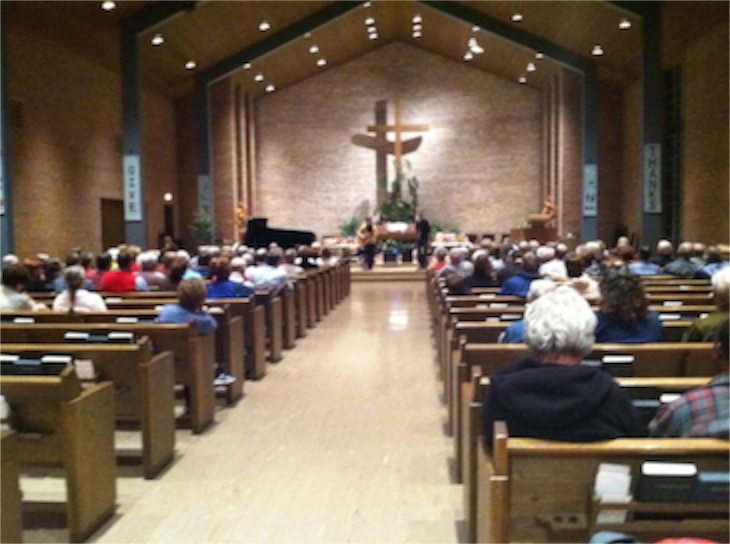 Times of transition are also difficult challenges for institutions. Whether it is a church, a service club or a business, there will always be some people involved in any organization that have loved and honored the past so much that they look backwards when they plan or dream of the future. They long to return to the way things were. This, of course, is impossible. God always calls us to the future and the future is never the past. The congregation we serve reached its largest numerical membership in 1951. Since that time there have been periods of decline and growth in membership, but the general trend has been toward a slow and gradual decline. But there are people who remember the full Sunday school rooms and crowded conditions of the 1950’s and who long for the way the church felt in those days. They want leaders who will chase numbers of people and attract large groups of children without genuinely considering the changes in family size and age profiles in our community that mean that times are different. In the worst cases, these people are so focused on the way things once were that they fail to recognize the opportunities for service that greet them every day. They need help with the transition from the way things were to the way things are before they can be captured by prophetic and visionary leadership.
Times of transition are also difficult challenges for institutions. Whether it is a church, a service club or a business, there will always be some people involved in any organization that have loved and honored the past so much that they look backwards when they plan or dream of the future. They long to return to the way things were. This, of course, is impossible. God always calls us to the future and the future is never the past. The congregation we serve reached its largest numerical membership in 1951. Since that time there have been periods of decline and growth in membership, but the general trend has been toward a slow and gradual decline. But there are people who remember the full Sunday school rooms and crowded conditions of the 1950’s and who long for the way the church felt in those days. They want leaders who will chase numbers of people and attract large groups of children without genuinely considering the changes in family size and age profiles in our community that mean that times are different. In the worst cases, these people are so focused on the way things once were that they fail to recognize the opportunities for service that greet them every day. They need help with the transition from the way things were to the way things are before they can be captured by prophetic and visionary leadership.
There are others who are involved in organizations that get caught up in envy of what they think are the qualities and successes of other institutions. The 10th Commandment, Exodus 20:17, clearly teaches that free people do not define themselves by what others have. But this does not stop faithful people from coming to church meetings with descriptions of other churches and a desire to imitate. In its most extreme form, this type of thinking can prevent individuals from sensing God’s call for their own unique institution. God does not call any of us to be someone else. God does not call churches to be other churches. God calls each to a unique form of discipleship, service and ministry.
But responding to the call means going through transitions. And transitions can be difficult. Sometimes, like with our grandson, there can be a few tears involved in getting from one thing to another. We will have to go through the sadness of saying good-bye to our family before we board the plane that will take us back to South Dakota. The ministry to which we are called requires us to face this pain directly. It is small compared to the pain being faced by grieving families back at home. Serving them requires us to put their needs ahead of our own desires. Sometimes a church has to say good-bye to its past in order to welcome new members who are very different from the folks who used to occupy the pews. Sometimes the path of service means going where success or failure is measured by faithfulness and not by statistics.
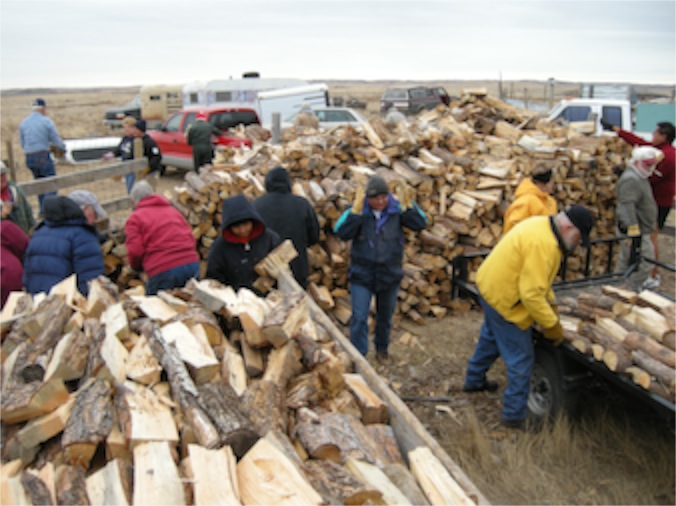 “Whoever wishes to save his life will lose it, but whoever loses his life for my sake is the one who will save it. “ (Luke 9:24, Matthew 10:39, Luke 17:33) Real service involves real loss. Real loss involves real grief. In this life of service, tears of joy and tears of sadness often mix on our cheeks as we listen carefully and respond to God’s call.
“Whoever wishes to save his life will lose it, but whoever loses his life for my sake is the one who will save it. “ (Luke 9:24, Matthew 10:39, Luke 17:33) Real service involves real loss. Real loss involves real grief. In this life of service, tears of joy and tears of sadness often mix on our cheeks as we listen carefully and respond to God’s call.
There are many things in life that are far worse than the pain of transitions. And there are transitions in this life that lead us to even greater joy. God keeps calling us to new directions and new possibilities.

Jesus addressed these transitions in the lives of his disciples directly. He urged them to think in terms of a radically new set of relationships. The quote in Luke is really harsh. “If anyone comes to me and does not hate his own father and mother and wife and children and brothers and sisters yes, and even his own life, he cannot be my disciple.” (Luke 14:26). Matthew probably got the quote more accurately: “Whoever loves father or mother more than me is not worthy of me, and whoever loves son or daughter more than me is not worthy of me.” (Matthew 10:37) The issue is not rejection of traditional family relationships, it is understanding that following God’s call radically re-defines family and all of our relationships. We are called to put our priorities in order. John’s Gospel says it in a different way: “The one who loves his life will lose it, while the one who hates his life in this world will keep it for eternal life.” (John 12:25)
Being a leader in God’s realm means becoming a servant. And a servant does not place pleasure or individual desires above God’s call. Some days a loving and devoted father is called to leave his children and focus his attention on serving others. Some days a loving and devoted grandmother needs to love other children as much as she loves the children of her children. Today, even though there is a part of us that would like to remain here for a long time and see our grandson every day, there is another part that knows we are called to serve children who have lost their fathers and grandfathers back in South Dakota. Our family is much bigger than we are. And there are times of transition when we must embrace that larger family.

There are others who are involved in organizations that get caught up in envy of what they think are the qualities and successes of other institutions. The 10th Commandment, Exodus 20:17, clearly teaches that free people do not define themselves by what others have. But this does not stop faithful people from coming to church meetings with descriptions of other churches and a desire to imitate. In its most extreme form, this type of thinking can prevent individuals from sensing God’s call for their own unique institution. God does not call any of us to be someone else. God does not call churches to be other churches. God calls each to a unique form of discipleship, service and ministry.
But responding to the call means going through transitions. And transitions can be difficult. Sometimes, like with our grandson, there can be a few tears involved in getting from one thing to another. We will have to go through the sadness of saying good-bye to our family before we board the plane that will take us back to South Dakota. The ministry to which we are called requires us to face this pain directly. It is small compared to the pain being faced by grieving families back at home. Serving them requires us to put their needs ahead of our own desires. Sometimes a church has to say good-bye to its past in order to welcome new members who are very different from the folks who used to occupy the pews. Sometimes the path of service means going where success or failure is measured by faithfulness and not by statistics.

There are many things in life that are far worse than the pain of transitions. And there are transitions in this life that lead us to even greater joy. God keeps calling us to new directions and new possibilities.
Copyright © 2012 by Ted Huffman. I wrote this. If you want to copy it, please ask for permission. There is a contact me button at the bottom of this page. If you want to share my blog a friend, please direct your friend to my web site.
Valentine's Day
14/02/12 04:32
Recently we were talking about how holidays have changed over the span of our lifetimes. We remember Valentine’s Day as being predominantly a children’s holiday when we were growing up. We made Valentine’s boxes, usually a shoe box decorated in red, white and pink paper, often with a heart cut out of a paper doily and a slot cut into the top. Most of us got inexpensive Valentine’s cards. They were printed on sheets and punched out, signed and placed in lightweight envelopes with the names of our classmates on the outside. At my house, we used a list of all of the children in our class to make sure that no one was left out. There would usually be a Valentine’s Party during the last half hour of the school day with cupcakes or cookies and a few candy hearts. The day was mostly a celebration of friendship. I can’t remember if my parents exchanged gifts on Valentine’s Day. I think there may have been a box of chocolates on some years, but I am not sure.

Valentine’s Day receives a big marketing push these days. As soon as the Christmas decorations are put away, Valentines are put on display. Retail stores devote entire sections of floor space to special cards, candies, decorations, stuffed animals, flowers and other gifts. Scanning the ads in the newspaper it appears that jewelry and underwear top the list of gifts that should be exchanged. Hotels and restaurants promote special Valentine’s Day packages and couples scramble to find babysitters under a sense of obligation and pressure to plan the perfect romantic evening.
 The origins of the celebration are a bit obscure. It is difficult to identify a single St. Valentine. Saints days are usually the day of their death or sometimes the day of their funeral. It is possible that the original St. Valentine could have been a priest in Rome, a bishop of Interamna, or a martyr in Africa. The official Roman Martyrology lists seven Saints Valentine. There are disputes about whether the saint’s day was originally recognized in July, October, November or February, as is the contemporary tradition. By the late 15th Century, stories arose of a priest who defied a Roman ban on the marriage of Christian couples. The report was that emperor Claudius II (Claudius Gothicus) ordered the arrest of anyone who conducted the marriage of a Christian couple as part of a crackdown on the emerging religion. Valentine defied the order and was arrested. Claudius, however, took a liking to the prisoner until Valentine tried to convert Claudius, whereupon he was executed. The first stories appear about 1200 years after the event reportedly took place, so tracing the origin to a single individual seems unlikely.
The origins of the celebration are a bit obscure. It is difficult to identify a single St. Valentine. Saints days are usually the day of their death or sometimes the day of their funeral. It is possible that the original St. Valentine could have been a priest in Rome, a bishop of Interamna, or a martyr in Africa. The official Roman Martyrology lists seven Saints Valentine. There are disputes about whether the saint’s day was originally recognized in July, October, November or February, as is the contemporary tradition. By the late 15th Century, stories arose of a priest who defied a Roman ban on the marriage of Christian couples. The report was that emperor Claudius II (Claudius Gothicus) ordered the arrest of anyone who conducted the marriage of a Christian couple as part of a crackdown on the emerging religion. Valentine defied the order and was arrested. Claudius, however, took a liking to the prisoner until Valentine tried to convert Claudius, whereupon he was executed. The first stories appear about 1200 years after the event reportedly took place, so tracing the origin to a single individual seems unlikely.
Valentine’s Day as a holiday may have its roots in other places. Some claim that it was an attempt by the Medieval Church to supersede the pagan holiday of Lupercalia, though such claims have also bee disputed by some scholars. The association of he day with romantic love seems to have gotten a big boost from the writings of Geoffrey Chaucer. Chaucer’s “Parliament of Foules” is set in a fictional context of an old tradition, but there is little evidence that the tradition existed before the book.
The confusion of the day and its origins seems appropriate. Love, after all, is a confusing thing for humans. It is an emotion, but it is expressed in deep commitment. Attempts at explaining love often end up as a jumble of words that do not fully explain the sentiment.
Greek, the language of the New Testament, has at least four words for love, each describing a different kind of love. Three of those words are used in the Bible. Philia is the affection between friends. Eros is the passion that flares between lovers. Agape is unconditional love, given without expectation of anything in return. It is this third kind of love that gains the most biblical attention. A forth Greek for love, storge, refers to familial love, such as the love of a parent for a child. Like many other complex concepts, the words get interchanged and often one word is used in the definition of another.
Scientific studies try to reduce love to chemistry with talk about dopamine and oxytocin, vasopressin and opioids. Neuroscientists refer to a small part of the brain called the ventral tegmental area. Journalist David Brooks in “The Social Animal,” speaks in terms of pheromones and lowered cortisol levels. He refers to the exchange of siliva in a kiss as a way of collecting genetic information. The reflections may have some kind of obscure meaning and may have a degree of detailed observation, but they are in no way a satisfying explanation of love.
The more we try to talk about love, the more we try to analyze it, the more we try to understand love – the more it seems that we really don’t understand anything at all. The novelist David James Duncan wrote, “People often don’t know what they’re talking about. When they talk about love, they really don’t know what they’re talking about.”
 Maybe that is true of the holiday we recognize today. It is a celebration of something that we really don’t understand and therefore our celebration is somewhat confused. We celebrate a day that may or may not have its roots in the Greek concept of agape, as may or may not have been demonstrated by the martyrdom of a priest or bishop by exchanging cards with pictures of a Roman God often portrayed as a child with a bow and an arrow. No wonder we’re confused!
Maybe that is true of the holiday we recognize today. It is a celebration of something that we really don’t understand and therefore our celebration is somewhat confused. We celebrate a day that may or may not have its roots in the Greek concept of agape, as may or may not have been demonstrated by the martyrdom of a priest or bishop by exchanging cards with pictures of a Roman God often portrayed as a child with a bow and an arrow. No wonder we’re confused!
What we do know is that love is a wonder. It is a joy that has the capacity to surprise and delight us. It makes us capable of sacrifice and service that reach far beyond our natural tendencies. It is worthy of our time and attention. Love should be celebrated.
I have been lucky in love. We have been given the gift not only of having grown up together, but now are experiencing the exquisite joy of growing old together. It is something that we can’t explain to young couples. We leave it for them to discover on their own. But we do hope they will discover it. There really is nothing better in this life than love over the span of many years. With the perspective of many decades of the coming and going of February 14, I prefer to celebrate love every day and not relegate the observance to a single day each year.
So have a happy Valentine’s Day. Enjoy yourself. But don’t forget to be thankful for the gift of love on all of the other days.

Valentine’s Day receives a big marketing push these days. As soon as the Christmas decorations are put away, Valentines are put on display. Retail stores devote entire sections of floor space to special cards, candies, decorations, stuffed animals, flowers and other gifts. Scanning the ads in the newspaper it appears that jewelry and underwear top the list of gifts that should be exchanged. Hotels and restaurants promote special Valentine’s Day packages and couples scramble to find babysitters under a sense of obligation and pressure to plan the perfect romantic evening.

Valentine’s Day as a holiday may have its roots in other places. Some claim that it was an attempt by the Medieval Church to supersede the pagan holiday of Lupercalia, though such claims have also bee disputed by some scholars. The association of he day with romantic love seems to have gotten a big boost from the writings of Geoffrey Chaucer. Chaucer’s “Parliament of Foules” is set in a fictional context of an old tradition, but there is little evidence that the tradition existed before the book.
The confusion of the day and its origins seems appropriate. Love, after all, is a confusing thing for humans. It is an emotion, but it is expressed in deep commitment. Attempts at explaining love often end up as a jumble of words that do not fully explain the sentiment.
Greek, the language of the New Testament, has at least four words for love, each describing a different kind of love. Three of those words are used in the Bible. Philia is the affection between friends. Eros is the passion that flares between lovers. Agape is unconditional love, given without expectation of anything in return. It is this third kind of love that gains the most biblical attention. A forth Greek for love, storge, refers to familial love, such as the love of a parent for a child. Like many other complex concepts, the words get interchanged and often one word is used in the definition of another.
Scientific studies try to reduce love to chemistry with talk about dopamine and oxytocin, vasopressin and opioids. Neuroscientists refer to a small part of the brain called the ventral tegmental area. Journalist David Brooks in “The Social Animal,” speaks in terms of pheromones and lowered cortisol levels. He refers to the exchange of siliva in a kiss as a way of collecting genetic information. The reflections may have some kind of obscure meaning and may have a degree of detailed observation, but they are in no way a satisfying explanation of love.
The more we try to talk about love, the more we try to analyze it, the more we try to understand love – the more it seems that we really don’t understand anything at all. The novelist David James Duncan wrote, “People often don’t know what they’re talking about. When they talk about love, they really don’t know what they’re talking about.”

What we do know is that love is a wonder. It is a joy that has the capacity to surprise and delight us. It makes us capable of sacrifice and service that reach far beyond our natural tendencies. It is worthy of our time and attention. Love should be celebrated.
I have been lucky in love. We have been given the gift not only of having grown up together, but now are experiencing the exquisite joy of growing old together. It is something that we can’t explain to young couples. We leave it for them to discover on their own. But we do hope they will discover it. There really is nothing better in this life than love over the span of many years. With the perspective of many decades of the coming and going of February 14, I prefer to celebrate love every day and not relegate the observance to a single day each year.
So have a happy Valentine’s Day. Enjoy yourself. But don’t forget to be thankful for the gift of love on all of the other days.
Copyright © 2012 by Ted Huffman. I wrote this. If you want to copy it, please ask for permission. There is a contact me button at the bottom of this page. If you want to share my blog a friend, please direct your friend to my web site.
Joy
13/02/12 03:11
As a father I have had many dreams for our children. When they were young, I dreamed of them growing up healthy and happy. I worried, at times, about all of the things that might threaten their well-being. I was aware, at times, of how decisions I made about my career, hobbies and other parts of life could impact their lives. Much of being a father has been about awe and wonder for me from the beginning. Our children have had the ability to continually impress, amaze, and delight me. I guess what I am trying to say is that being a father has been more than I was able to imagine from the beginning.
At the birthday party for our grandson, the adults who gathered were challenged to think about his future. His parents had made up some simple cards with an invitation to speculate about his future career. It was all in good fun and not intended to be prophecy. There were lots of divergent possibilities entered onto the cards. Suggestions included rock star, rodeo star, teacher, technology wizard, architect and ventriloquist. One card predicted that his career would be something that doesn’t exist in our contemporary world – something not yet invented.
It was a game we played with our children as they grew up. When I grow up I want to be a fireman, pilot, dancer, basketball player, racecar driver, doctor, and astronaut. The lists were often long and the possibilities seemed endless. When we played the game with our children, we encouraged them to follow their dreams and to work hard to overcome barriers and obstacles that they might encounter.

I don’t remember ever spending much time with them encouraging them to think of becoming a father or a mother. I guess the role of father was new enough to me at the time that I couldn’t quite think ahead to what life would be like when they were older. Children, however, learn more from who we are than from what we say. And they must have picked up the sense of the delight that we found in being married and the central role of children in our lives that struck a chord with our children. I’m not sure that I have ever said it to our children in these exact words, but from the beginning I have wanted their happiness. And I know that my happiness comes in part from having a career that I love. But it also comes from having a marriage and a family that sustains, challenges, and supports me.
In wedding ceremonies I have often said words like these: “We raise our children in love that they might learn to love. It should come as no surprise to us, then that they have come to this place to make commitments of their love.” Yet, somehow, it does surprise us. And it is a good sort of a surprise.
 This weekend I have had the delight of watching our adult children as our family gathered. I think I have long known that when the time comes our daughter will be a wonderful mother. What I have thought less about is that she already is a wonderful aunt. The delight in her nephew’s face when she comes into the room is evident. Her ability to focus on him and his needs is apparent. She does not hesitate to sacrifice her own comfort or convenience for her brother’s son.
This weekend I have had the delight of watching our adult children as our family gathered. I think I have long known that when the time comes our daughter will be a wonderful mother. What I have thought less about is that she already is a wonderful aunt. The delight in her nephew’s face when she comes into the room is evident. Her ability to focus on him and his needs is apparent. She does not hesitate to sacrifice her own comfort or convenience for her brother’s son.
When our children were growing up, we knew that they would always be brother and sister. It is an added bonus that they are also great friends. Learning to accept and love the partners of their siblings has required adjustment and grace and they have demonstrated those qualities beautifully. I don’t think that I thought much about what kind of brother-in-law or sister-in-law our children would be, but it certainly is delightful to see them moving into those roles as adults.
One of the perspectives of a grandfather is the knowledge of how quickly the days pass and how soon infants become children, children become teens and teens become adults. I know these days of our family with just one grandchild are precious days. I am well aware that our family will change as dramatically in the next few years as it has in the past few years. Families are constantly changing. Each gathering is a unique event and a unique combination of people. The next time we get together things will be different if for no other reason than that we are all getting older.
I think that I used to be able to imagine the pride and joy I might feel as our son talks about his new job and the changes in his career. I’m not sure that I was able to imagine the delight that would flood my life as I watched our daughter play with her nephew. I dreamed of dancing with our daughter on her wedding day for so many years that when it actually happened it seemed like a dream come true. I never quite imagined how wondrous it would feel to listen to her brother propose a toast to the new couple and welcome his new brother-in-law into the family.
 It doesn’t take more than a cursory read through of the bible or a few minutes of watching the people around us to understand that families come in all sizes and shapes. There is no magic formula that describes some sort of ideal or perfect set of relationships. But the Bible and the experiences of life are quick to teach that faith is more important than success, hope is more important than security, and love is more important than wealth.
It doesn’t take more than a cursory read through of the bible or a few minutes of watching the people around us to understand that families come in all sizes and shapes. There is no magic formula that describes some sort of ideal or perfect set of relationships. But the Bible and the experiences of life are quick to teach that faith is more important than success, hope is more important than security, and love is more important than wealth.
The Gospels report conversations between Jesus and his disciples in which the disciples are asking for recognition and deliverance from pain. Jesus does not promise that these requests will be granted. Instead he suggests that their lives will be marked by service and that they will experience grief. But he also promises them joy.
Our family has known the grief of loss. There are loved ones that we miss every day. And we know that we have been called to lives of service rather than lives of recognition and fame. And in these lives we have known deep joy. Just like Jesus promised, it is a joy that no one can take away. (John 16:22)
I have had an active imagination all of my life. But imagination has its limits. So far reality has exceeded my imagination at every turn. Joy, joy joy!
At the birthday party for our grandson, the adults who gathered were challenged to think about his future. His parents had made up some simple cards with an invitation to speculate about his future career. It was all in good fun and not intended to be prophecy. There were lots of divergent possibilities entered onto the cards. Suggestions included rock star, rodeo star, teacher, technology wizard, architect and ventriloquist. One card predicted that his career would be something that doesn’t exist in our contemporary world – something not yet invented.
It was a game we played with our children as they grew up. When I grow up I want to be a fireman, pilot, dancer, basketball player, racecar driver, doctor, and astronaut. The lists were often long and the possibilities seemed endless. When we played the game with our children, we encouraged them to follow their dreams and to work hard to overcome barriers and obstacles that they might encounter.

I don’t remember ever spending much time with them encouraging them to think of becoming a father or a mother. I guess the role of father was new enough to me at the time that I couldn’t quite think ahead to what life would be like when they were older. Children, however, learn more from who we are than from what we say. And they must have picked up the sense of the delight that we found in being married and the central role of children in our lives that struck a chord with our children. I’m not sure that I have ever said it to our children in these exact words, but from the beginning I have wanted their happiness. And I know that my happiness comes in part from having a career that I love. But it also comes from having a marriage and a family that sustains, challenges, and supports me.
In wedding ceremonies I have often said words like these: “We raise our children in love that they might learn to love. It should come as no surprise to us, then that they have come to this place to make commitments of their love.” Yet, somehow, it does surprise us. And it is a good sort of a surprise.

When our children were growing up, we knew that they would always be brother and sister. It is an added bonus that they are also great friends. Learning to accept and love the partners of their siblings has required adjustment and grace and they have demonstrated those qualities beautifully. I don’t think that I thought much about what kind of brother-in-law or sister-in-law our children would be, but it certainly is delightful to see them moving into those roles as adults.
One of the perspectives of a grandfather is the knowledge of how quickly the days pass and how soon infants become children, children become teens and teens become adults. I know these days of our family with just one grandchild are precious days. I am well aware that our family will change as dramatically in the next few years as it has in the past few years. Families are constantly changing. Each gathering is a unique event and a unique combination of people. The next time we get together things will be different if for no other reason than that we are all getting older.
I think that I used to be able to imagine the pride and joy I might feel as our son talks about his new job and the changes in his career. I’m not sure that I was able to imagine the delight that would flood my life as I watched our daughter play with her nephew. I dreamed of dancing with our daughter on her wedding day for so many years that when it actually happened it seemed like a dream come true. I never quite imagined how wondrous it would feel to listen to her brother propose a toast to the new couple and welcome his new brother-in-law into the family.

The Gospels report conversations between Jesus and his disciples in which the disciples are asking for recognition and deliverance from pain. Jesus does not promise that these requests will be granted. Instead he suggests that their lives will be marked by service and that they will experience grief. But he also promises them joy.
Our family has known the grief of loss. There are loved ones that we miss every day. And we know that we have been called to lives of service rather than lives of recognition and fame. And in these lives we have known deep joy. Just like Jesus promised, it is a joy that no one can take away. (John 16:22)
I have had an active imagination all of my life. But imagination has its limits. So far reality has exceeded my imagination at every turn. Joy, joy joy!
Copyright © 2012 by Ted Huffman. I wrote this. If you want to copy it, please ask for permission. There is a contact me button at the bottom of this page. If you want to share my blog a friend, please direct your friend to my web site.
Who owns ideas?
12/02/12 05:19
People have been arguing about who owns and idea for a long time. There are ideas that get shared informally and passed around so frequently that no one knows for sure the idea’s origin. Ideas are often shared intentionally. People want ideas to gain acceptance and to go from concept to reality. But people can also get touchy about their ideas claiming that they should have some exclusive right to their idea.
The concept of intellectual property has evolved over the centuries. As the industrial revolution swept Europe and the Americas, patent laws began to be codified. Early in the eighteenth century copyright laws for printed materials were added. Now there are laws that grant ownership and rights to many ideas and concepts. Music, literature, artistic works, discoveries and inventions can be owned. So, too can specific phrases, titles, symbols and designs.
The laws are designed to protect the creators of ideas and to allow them to gain benefit from their creativity. Disputes arise when the origin of an idea isn’t clear. They also arise when the rights are exchanged. One way to benefit from an idea is to sell that idea to someone else. Control of intellectual rights can also be inherited. This leaves the general society with the question of how far from its origin can an idea be controlled.
Other issues arise with the advance of technology. As the music industry made a transition from distributing music through physical objects such as records and CD’s to distributing music through downloadable computer files there were huge issues about how artists might be compensated for their work. Arguments about paying artists are often obscured by the simple fact that there are others who want to profit from music. The record industry was filled with huge salaries paid to people who were tangentially related to the production of popular music, but who were in no way the creators of that music.
Greedy people will always fight over money when there are sizeable amounts of money.
The question remains. Who should get the money that is exchanged when intellectual property is distributed? Most people can agree that the originator of the idea – the composer, author, artist, etc. – should be fairly compensated. We have disagreements about how much money and control should go to others.
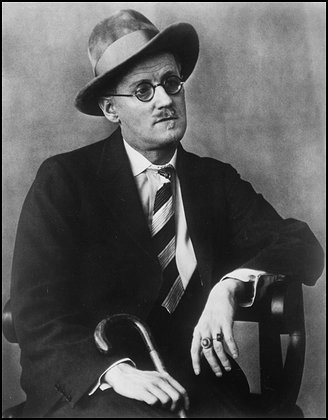
The literary world waited a long time for January, 2012. Well a few avid readers with unique tastes were waiting, at least. The date was the expiration date of the copyrights relating to the works of James Joyce. The Irish novelist and poet died in January of 1941. He is probably best known for the huge work, Ulysses, published in 1922, in which he parallels episodes of Homer’s Odyssey in contrasting literary styles. The book is a masterpiece of creative genius, but it isn’t technically a totally new idea. It wouldn’t exist if it weren’t for Homer’s original writing.
Joyce went on to produce many works that illustrated his creativity and skill as a writer. Dubliners is a collection of short stories. The novels A Portrait of the Artist as a Young Man and Finnegans Wake established his reputation as a complex thinker and significant writer.
Less known works by Joyce include a play, poems and letters that have all been published. There is also a little known children’s story, “The Cat and the Devil.”
Rumors of other unpublished works abounded. The copyrights and original materials have been closely guarded. The Zurich James Joyce Foundation maintains a large library of original works and charges handsomely for reproductions of their materials. They also use special watermarked papers in their reproductions that protect the materials from publication.
So it is no surprise that a small press in Dublin has produced a new James Joyce book. It is, however, a surprise that the book is another children’s story. “The Cats of Copenhagen” was written in a letter to Joyce’s grandson in 1936 as a “younger twin sister” to “The Cat and the Devil.” The publication of the story has started another big debate about who owns and who should control the works of the author 70 years after his death.
The folks at the Zurich James Joyce Foundation say that not all of the works of Joyce have passed into public domain, only previously published works. The folks at Ithys Press say that the world has a right to access to all of Joyce’s works and that it is only fair that the book be published.
For fans of Joyce, the argument is mute. The press produced only 200 copies of the book that have skyrocketed in value from about $400 per copy to nearly $1,600 for a copy if you can find one. It hasn’t shown up on Amazon.com yet. Once again the argument isn’t really about which ideas will be made public. It is, rather, an argument about who gets the money associated with the ideas.
Greedy people will always fight over money whenever there is money.
I’m not sure Joyce will be remembered as a children’s author anyway. His ideas are very complex, his characters sometimes very dark and his books not easily accessible for casual readers.

What I was hoping to see published was anything that might shed some light on Joyce’s complex relationship with the Catholic Church. The common viewpoint is that Joyce rejected his Catholic upbringing and lived as an atheist or at least an agnostic for his life, reconciling with the church near his death. However, the tension with the church continued to the end of his life. There was no mass of Christian burial at his death. His widow was once asked why there was no funeral mass and she replied, “I couldn’t do that to him.”
Umberto Eco compared Joyce to the stray bishops of the Middle Ages. They left a discipline, not a cultural heritage or a way of thinking. Joyce’s brother explained his break with the church as Joyce’s spiritual side outgrowing the confines of religious practice.
Much more, however, appears to be only speculation. We may never know the complexities of Joyce’s relationship with the church.
At least, I’ve come to the conclusion that there is little that will be revealed through the publication of previously unpublished words. It makes little difference to me. Given the current market, there is little chance I would be able to afford the books if they are ever published.
I am used to ending my blogs with this tag line:
The concept of intellectual property has evolved over the centuries. As the industrial revolution swept Europe and the Americas, patent laws began to be codified. Early in the eighteenth century copyright laws for printed materials were added. Now there are laws that grant ownership and rights to many ideas and concepts. Music, literature, artistic works, discoveries and inventions can be owned. So, too can specific phrases, titles, symbols and designs.
The laws are designed to protect the creators of ideas and to allow them to gain benefit from their creativity. Disputes arise when the origin of an idea isn’t clear. They also arise when the rights are exchanged. One way to benefit from an idea is to sell that idea to someone else. Control of intellectual rights can also be inherited. This leaves the general society with the question of how far from its origin can an idea be controlled.
Other issues arise with the advance of technology. As the music industry made a transition from distributing music through physical objects such as records and CD’s to distributing music through downloadable computer files there were huge issues about how artists might be compensated for their work. Arguments about paying artists are often obscured by the simple fact that there are others who want to profit from music. The record industry was filled with huge salaries paid to people who were tangentially related to the production of popular music, but who were in no way the creators of that music.
Greedy people will always fight over money when there are sizeable amounts of money.
The question remains. Who should get the money that is exchanged when intellectual property is distributed? Most people can agree that the originator of the idea – the composer, author, artist, etc. – should be fairly compensated. We have disagreements about how much money and control should go to others.

The literary world waited a long time for January, 2012. Well a few avid readers with unique tastes were waiting, at least. The date was the expiration date of the copyrights relating to the works of James Joyce. The Irish novelist and poet died in January of 1941. He is probably best known for the huge work, Ulysses, published in 1922, in which he parallels episodes of Homer’s Odyssey in contrasting literary styles. The book is a masterpiece of creative genius, but it isn’t technically a totally new idea. It wouldn’t exist if it weren’t for Homer’s original writing.
Joyce went on to produce many works that illustrated his creativity and skill as a writer. Dubliners is a collection of short stories. The novels A Portrait of the Artist as a Young Man and Finnegans Wake established his reputation as a complex thinker and significant writer.
Less known works by Joyce include a play, poems and letters that have all been published. There is also a little known children’s story, “The Cat and the Devil.”
Rumors of other unpublished works abounded. The copyrights and original materials have been closely guarded. The Zurich James Joyce Foundation maintains a large library of original works and charges handsomely for reproductions of their materials. They also use special watermarked papers in their reproductions that protect the materials from publication.
So it is no surprise that a small press in Dublin has produced a new James Joyce book. It is, however, a surprise that the book is another children’s story. “The Cats of Copenhagen” was written in a letter to Joyce’s grandson in 1936 as a “younger twin sister” to “The Cat and the Devil.” The publication of the story has started another big debate about who owns and who should control the works of the author 70 years after his death.
The folks at the Zurich James Joyce Foundation say that not all of the works of Joyce have passed into public domain, only previously published works. The folks at Ithys Press say that the world has a right to access to all of Joyce’s works and that it is only fair that the book be published.
For fans of Joyce, the argument is mute. The press produced only 200 copies of the book that have skyrocketed in value from about $400 per copy to nearly $1,600 for a copy if you can find one. It hasn’t shown up on Amazon.com yet. Once again the argument isn’t really about which ideas will be made public. It is, rather, an argument about who gets the money associated with the ideas.
Greedy people will always fight over money whenever there is money.
I’m not sure Joyce will be remembered as a children’s author anyway. His ideas are very complex, his characters sometimes very dark and his books not easily accessible for casual readers.

What I was hoping to see published was anything that might shed some light on Joyce’s complex relationship with the Catholic Church. The common viewpoint is that Joyce rejected his Catholic upbringing and lived as an atheist or at least an agnostic for his life, reconciling with the church near his death. However, the tension with the church continued to the end of his life. There was no mass of Christian burial at his death. His widow was once asked why there was no funeral mass and she replied, “I couldn’t do that to him.”
Umberto Eco compared Joyce to the stray bishops of the Middle Ages. They left a discipline, not a cultural heritage or a way of thinking. Joyce’s brother explained his break with the church as Joyce’s spiritual side outgrowing the confines of religious practice.
Much more, however, appears to be only speculation. We may never know the complexities of Joyce’s relationship with the church.
At least, I’ve come to the conclusion that there is little that will be revealed through the publication of previously unpublished words. It makes little difference to me. Given the current market, there is little chance I would be able to afford the books if they are ever published.
I am used to ending my blogs with this tag line:
Copyright © 2012 by Ted Huffman. I wrote this. If you want to copy it, please ask for permission. There is a contact me button at the bottom of this page. If you want to share my blog a friend, please direct your friend to my web site.
On the other hand, maybe the ideas about which I write aren’t really my own!Bread
11/02/12 06:33
The story of Joseph is well known to Sunday school children. Like many other narrative stories from Genesis and Exodus, it has an intriguing plot line that makes the story easy to tell. For decades the musical by Andrew Lloyd Webber with lyrics by Tim Rice has been performed to tell the story entirely in song. The musical has no spoken lyrics. The entire story is carried in the songs.
The basic story is relatively complex. Joseph is the eleventh of Jacob’s 12 sons, the first to be born to Rachel, who is the most beloved of the four mothers of Jacob’s children. A special coat that is a gift from his father demonstrates Joseph’s status among the brothers. His brothers don’t hide their animosity toward him. They plot to kill him, but at the last moment sell him into slavery at the last minute.
In Egypt, where Joseph is taken as a slave, his fortunes rise and fall and rise again as he makes his way into the role of manager of the household of the captain of Pharaoh’s guard, then is thrown into prison under false charges. His ability to interpret dreams gains him release from prison and eventually rose to become the administrator of the Pharaoh’s entire domain.
The key vision that gained him his freedom and position was the interpretation of one of Pharaoh’s dreams from which he accurately predicts seven years of plentiful harvests followed by seven years of famine for the entire region. Egypt’s careful saving of crops during the seven years of plenty makes it into the breadbasket of the entire region. People from distant lands are forced to come to Egypt in order to survive.
It is during this famine that Joseph is reunited with his family as they too are forced to beg for food from Egypt. Thus begins the journey that leads the people of Israel into slavery in Egypt and concludes with the Exodus.

So we all have the image of a plentiful Egypt with grain sufficient to share fixed in our minds. Even today, with intense desertification throughout northern Africa, we have grown to think of Egypt as a land of productive farmland and bountiful harvests. Thoughts of Egypt bring to mind images of street vendors with huge baskets of pita bread.
The image doesn’t ring true in contemporary Egypt. There is a shortage of bread and a shortage of flour to make bread these days in Egypt. Although there is still plenty of fertile land along the Nile River, Egypt has become a net importer of food. These days, Egypt imports about 80 percent of its agricultural products. Inflation is running at 9 percent, which further drives up the costs of basic food. The revolt that drove President Hosni Mubarak from office a year ago has not resulted in any improvement in the shortages of food. Charges of corruption in the Mubarak administration are especially accurate when it comes to agriculture. Two of the last three ministers of agriculture are in jail. Among the charges are the allowing of tainted pesticides into the country and selling prime farmland at a fraction of fair market value.
The destruction of the food economy was, in part, due to greed. With water in short supply, large farms turned from producing low-margin grain crops in favor of higher price products such as cut flowers, cotton and fruit. More and more agricultural land was sold to developers despite zoning laws prohibiting such changes in land use. The price of the land began to rise, making it impossible to earn a living off of the land producing grain, where the profit is small.
The potential famine threatens to eclipse the seven years of drought in the Biblical story of Joseph in the land of Egypt. There is not enough bread to feed the people. In a land where 40% of the people live on less than $2 a day, there simply is no way to pay the higher costs for imported food. A country that cannot produce its own food faces a future of perpetual dependence and famine. A weak transitional government exacerbates the situation. The administration is incapable of making long-term plans and developing strategies for increasing food production.
Images of wealthy Arab oil producers have tainted the perception of Egypt in the eyes of many in the West. While there are extremely wealthy countries in the Middle East that produce enormous amounts of oil for export, Egypt is not a major player in the world oil markets. While Egypt does produce oil and exporting oil is a source of income for the nation, it is a relatively small player in the world markets. The wealth produced by exporting oil is insufficient to offset the costs of importing food.
As is true in other countries with huge economic disparities, the benefits of a growing economy are felt by the wealthy elite and have failed to trickle down to improve economic conditions for the broader population. Unemployment, especially unemployment of those less than 30 years of age is a huge problem that is growing.

So there is famine in Egypt.
The response of our country is mixed at best. The United States has invested heavily in rural Egypt. USAID has spent over a billion dollars in training courses and water-management programs. At the same time, our country is a net exporter of food grains. Loan guarantees and other subsidies in our country mean that our grain is available at low cost throughout the world. Keeping the price of grain low benefits our producers, but narrows the potential for profit in other parts of the world. At the same time as our country continues to invest in Egyptian agriculture, our exports are seen as the reason that farmers cannot earn a living from growing grain in Egypt.
It is a complex problem. One might even say that it is a problem of Biblical proportions. The stories that our people have been telling for thousands of years ring true today. As was true in the story of Joseph, excessive dependence upon foreign sources for food leads away from freedom for the people. This time the roles have been reversed and it is Egypt that is wondering how to feed its people.

Once again there is a need for visionary leadership. The world is waiting and watching. And the lines for bread are getting longer and longer.
The basic story is relatively complex. Joseph is the eleventh of Jacob’s 12 sons, the first to be born to Rachel, who is the most beloved of the four mothers of Jacob’s children. A special coat that is a gift from his father demonstrates Joseph’s status among the brothers. His brothers don’t hide their animosity toward him. They plot to kill him, but at the last moment sell him into slavery at the last minute.
In Egypt, where Joseph is taken as a slave, his fortunes rise and fall and rise again as he makes his way into the role of manager of the household of the captain of Pharaoh’s guard, then is thrown into prison under false charges. His ability to interpret dreams gains him release from prison and eventually rose to become the administrator of the Pharaoh’s entire domain.
The key vision that gained him his freedom and position was the interpretation of one of Pharaoh’s dreams from which he accurately predicts seven years of plentiful harvests followed by seven years of famine for the entire region. Egypt’s careful saving of crops during the seven years of plenty makes it into the breadbasket of the entire region. People from distant lands are forced to come to Egypt in order to survive.
It is during this famine that Joseph is reunited with his family as they too are forced to beg for food from Egypt. Thus begins the journey that leads the people of Israel into slavery in Egypt and concludes with the Exodus.

So we all have the image of a plentiful Egypt with grain sufficient to share fixed in our minds. Even today, with intense desertification throughout northern Africa, we have grown to think of Egypt as a land of productive farmland and bountiful harvests. Thoughts of Egypt bring to mind images of street vendors with huge baskets of pita bread.
The image doesn’t ring true in contemporary Egypt. There is a shortage of bread and a shortage of flour to make bread these days in Egypt. Although there is still plenty of fertile land along the Nile River, Egypt has become a net importer of food. These days, Egypt imports about 80 percent of its agricultural products. Inflation is running at 9 percent, which further drives up the costs of basic food. The revolt that drove President Hosni Mubarak from office a year ago has not resulted in any improvement in the shortages of food. Charges of corruption in the Mubarak administration are especially accurate when it comes to agriculture. Two of the last three ministers of agriculture are in jail. Among the charges are the allowing of tainted pesticides into the country and selling prime farmland at a fraction of fair market value.
The destruction of the food economy was, in part, due to greed. With water in short supply, large farms turned from producing low-margin grain crops in favor of higher price products such as cut flowers, cotton and fruit. More and more agricultural land was sold to developers despite zoning laws prohibiting such changes in land use. The price of the land began to rise, making it impossible to earn a living off of the land producing grain, where the profit is small.
The potential famine threatens to eclipse the seven years of drought in the Biblical story of Joseph in the land of Egypt. There is not enough bread to feed the people. In a land where 40% of the people live on less than $2 a day, there simply is no way to pay the higher costs for imported food. A country that cannot produce its own food faces a future of perpetual dependence and famine. A weak transitional government exacerbates the situation. The administration is incapable of making long-term plans and developing strategies for increasing food production.
Images of wealthy Arab oil producers have tainted the perception of Egypt in the eyes of many in the West. While there are extremely wealthy countries in the Middle East that produce enormous amounts of oil for export, Egypt is not a major player in the world oil markets. While Egypt does produce oil and exporting oil is a source of income for the nation, it is a relatively small player in the world markets. The wealth produced by exporting oil is insufficient to offset the costs of importing food.
As is true in other countries with huge economic disparities, the benefits of a growing economy are felt by the wealthy elite and have failed to trickle down to improve economic conditions for the broader population. Unemployment, especially unemployment of those less than 30 years of age is a huge problem that is growing.

So there is famine in Egypt.
The response of our country is mixed at best. The United States has invested heavily in rural Egypt. USAID has spent over a billion dollars in training courses and water-management programs. At the same time, our country is a net exporter of food grains. Loan guarantees and other subsidies in our country mean that our grain is available at low cost throughout the world. Keeping the price of grain low benefits our producers, but narrows the potential for profit in other parts of the world. At the same time as our country continues to invest in Egyptian agriculture, our exports are seen as the reason that farmers cannot earn a living from growing grain in Egypt.
It is a complex problem. One might even say that it is a problem of Biblical proportions. The stories that our people have been telling for thousands of years ring true today. As was true in the story of Joseph, excessive dependence upon foreign sources for food leads away from freedom for the people. This time the roles have been reversed and it is Egypt that is wondering how to feed its people.

Once again there is a need for visionary leadership. The world is waiting and watching. And the lines for bread are getting longer and longer.
Copyright © 2012 by Ted Huffman. I wrote this. If you want to copy it, please ask for permission. There is a contact me button at the bottom of this page. If you want to share my blog a friend, please direct your friend to my web site.
A Prayer and a Song
10/02/12 06:35
There are plenty of stories that have enough antecedents to make it difficult for a storyteller to know where to start telling. The story of the Sound of the Northwest Gospel Choir is one of them. Back in 1987, Seattle was the host city for the fourth annual convention of the International Association of Minister’s Wives and Minister’s Widows. This interdenominational and intercultural group is primarily a charitable organization, sponsoring scholarships and other outreach ministries. They gather once a year for inspiration and mutual support.
Juan Huey-Ray agreed to form a gospel choir to perform at the meeting. The group was a success. The participants in the meeting really enjoyed them and the group really enjoyed singing together. So they just kept singing. They met in various churches and usually held their concerts in churches as well. As a community choir, they had little funding and kept coming together for the joy of the music. As an interracial group, their music helped to bridge cultural barriers in the community and they were asked to sing for public events and occasions from time to time.
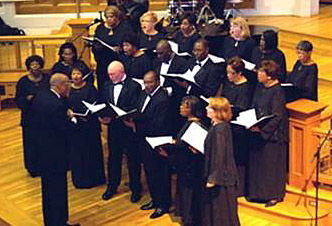
Their core music continues to be Negro Spirituals. These powerful songs have sustained people in times and circumstances when faith and hope were the only source of comfort and relief. The group sings arrangements by a wide variety of musicians, but many of their songs are arranged by and for the group. The group has also developed a large repertoire of music from composers like Burleigh, Dett, Hogan, Moore, Barnwell, Carter, Hariston, Morris and others. They also sing tunes from popular musical theatre and other sources. Over the years they have developed from a choir swaying to its music to an ensemble with richly choreographed moves.
It has been 25 years and Juan Huey-Ray is still the director of the 50-member group. Now they are preparing to sing at Carnegie Hall in New York City in its biggest concert opportunity of its history. The group will sing as a part of a larger, 300-voice choir under guest conductor Jacqueline Harrison. The big event for them, however is the 25 minutes when they will be onstage as a solo group.
They will begin their set with the Negro National Hymn, “Lift Every Voice and Sing.” The lyrics are a poem by James Weldon Johnson:
Lift every voice and sing,
till earth and heaven ring,
Ring with the harmonies of liberty;
Let our rejoicing rise
High as the listening skies,
Let it resound loud as the rolling sea.
Sing a song full of the faith that the
dark past has taught us,
Sing a song full of the hope that the present has brought us;
facing the rising sun of our new day begun,
let us march on till victory is won.
Stony the road we trod,
bitter the chastening rod,
belt in the days when hope unborn had died;
yet with a steady beat,
have not our weary feet
come to the place
for which our fathers died?
We have come over a way that with tears have been watered,
We have come, treading our path through the blood of the slaughtered,
out from the gloomy past,
till now we stand at last
where the white gleam
of our bright star is cast.
God of our weary years,
God of our silent tears,
thou who has brought us thus far on the way;
thou who hast by thy might let us into the light,
keep us forever in the path, we pray.
Lest our feet stray from the places, our God, where we meet thee;
lest our hearts drunk with the wine of the world, we forget thee,
shadowed beneath thy hand,
may we forever stand,
true to our God,
true to our native land.
If that doesn’t get the attention of the audience in Carnegie Hall, they just aren’t listening. The choir will also sing “Children Go Where I Send Thee,” “My Soul Has Been Anchored in the Lord,” “Wouldn’t Take Nothing for My Journey” and “Soon I Will Be Done.”
The music is a reminder for all who hear it that human beings have faced incredible challenges in the past. The day-to-day life of a slave was so harsh that death itself became something to look forward to. They saw death as a passageway to a better life. We live in a different time, and the pressures on people are different – some might say much less harsh. Still there are those for whom life is so painful that they resort to a wide variety of activities in an attempt to lessen the pain. Alcohol and drugs top the list of self-administered medications that rarely provide solutions, and often aren’t even good for temporary respite. The African-American slaves of the founding centuries of the United States didn’t have access to alcohol or drugs. They faced the drudgery and cruelty of their lives without anything to dull the pain. From their experience has come music that can lift the spirit of anyone who takes the time to listen.
And a community choir from Seattle is heading to New York City this month to share that music. There is a part of me that wishes I could be there to hear it.
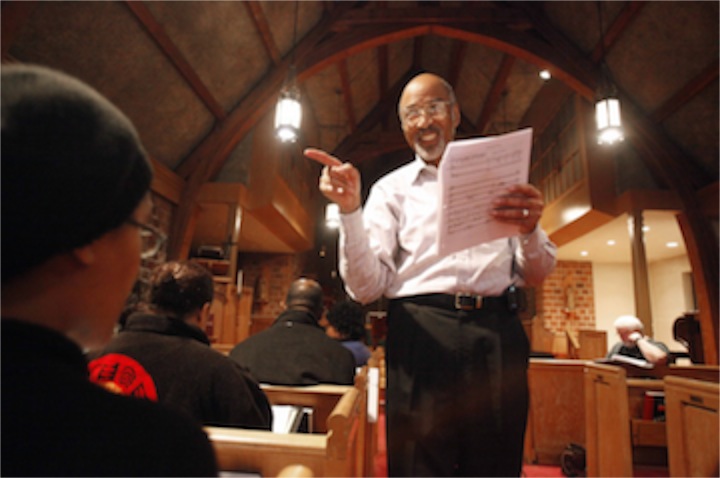
In these days of austerity measures and educational cutbacks, schools have been encouraged to drop extra-curricular activities and focus on the basics. I hope that they don’t loose sight of the true foundations of our human endeavor. Music is deeper than “reading, writing and arithmetic.” When people were brought to this land against their wills, without the benefit of speaking English, and often without the benefit of a shared language, they figured out how to survive and how to pass on from one generation the truth of faith and hope. It wasn’t done with volumes of literature or with complex mathematical formulas. It was done with a song.
If we fail to teach the songs to our children, we will fail to pass on the faith of previous generations.
One community group in Seattle is making sure that the songs are still sung.
Juan Huey-Ray agreed to form a gospel choir to perform at the meeting. The group was a success. The participants in the meeting really enjoyed them and the group really enjoyed singing together. So they just kept singing. They met in various churches and usually held their concerts in churches as well. As a community choir, they had little funding and kept coming together for the joy of the music. As an interracial group, their music helped to bridge cultural barriers in the community and they were asked to sing for public events and occasions from time to time.

Their core music continues to be Negro Spirituals. These powerful songs have sustained people in times and circumstances when faith and hope were the only source of comfort and relief. The group sings arrangements by a wide variety of musicians, but many of their songs are arranged by and for the group. The group has also developed a large repertoire of music from composers like Burleigh, Dett, Hogan, Moore, Barnwell, Carter, Hariston, Morris and others. They also sing tunes from popular musical theatre and other sources. Over the years they have developed from a choir swaying to its music to an ensemble with richly choreographed moves.
It has been 25 years and Juan Huey-Ray is still the director of the 50-member group. Now they are preparing to sing at Carnegie Hall in New York City in its biggest concert opportunity of its history. The group will sing as a part of a larger, 300-voice choir under guest conductor Jacqueline Harrison. The big event for them, however is the 25 minutes when they will be onstage as a solo group.
They will begin their set with the Negro National Hymn, “Lift Every Voice and Sing.” The lyrics are a poem by James Weldon Johnson:
Lift every voice and sing,
till earth and heaven ring,
Ring with the harmonies of liberty;
Let our rejoicing rise
High as the listening skies,
Let it resound loud as the rolling sea.
Sing a song full of the faith that the
dark past has taught us,
Sing a song full of the hope that the present has brought us;
facing the rising sun of our new day begun,
let us march on till victory is won.
Stony the road we trod,
bitter the chastening rod,
belt in the days when hope unborn had died;
yet with a steady beat,
have not our weary feet
come to the place
for which our fathers died?
We have come over a way that with tears have been watered,
We have come, treading our path through the blood of the slaughtered,
out from the gloomy past,
till now we stand at last
where the white gleam
of our bright star is cast.
God of our weary years,
God of our silent tears,
thou who has brought us thus far on the way;
thou who hast by thy might let us into the light,
keep us forever in the path, we pray.
Lest our feet stray from the places, our God, where we meet thee;
lest our hearts drunk with the wine of the world, we forget thee,
shadowed beneath thy hand,
may we forever stand,
true to our God,
true to our native land.
If that doesn’t get the attention of the audience in Carnegie Hall, they just aren’t listening. The choir will also sing “Children Go Where I Send Thee,” “My Soul Has Been Anchored in the Lord,” “Wouldn’t Take Nothing for My Journey” and “Soon I Will Be Done.”
The music is a reminder for all who hear it that human beings have faced incredible challenges in the past. The day-to-day life of a slave was so harsh that death itself became something to look forward to. They saw death as a passageway to a better life. We live in a different time, and the pressures on people are different – some might say much less harsh. Still there are those for whom life is so painful that they resort to a wide variety of activities in an attempt to lessen the pain. Alcohol and drugs top the list of self-administered medications that rarely provide solutions, and often aren’t even good for temporary respite. The African-American slaves of the founding centuries of the United States didn’t have access to alcohol or drugs. They faced the drudgery and cruelty of their lives without anything to dull the pain. From their experience has come music that can lift the spirit of anyone who takes the time to listen.
And a community choir from Seattle is heading to New York City this month to share that music. There is a part of me that wishes I could be there to hear it.

In these days of austerity measures and educational cutbacks, schools have been encouraged to drop extra-curricular activities and focus on the basics. I hope that they don’t loose sight of the true foundations of our human endeavor. Music is deeper than “reading, writing and arithmetic.” When people were brought to this land against their wills, without the benefit of speaking English, and often without the benefit of a shared language, they figured out how to survive and how to pass on from one generation the truth of faith and hope. It wasn’t done with volumes of literature or with complex mathematical formulas. It was done with a song.
If we fail to teach the songs to our children, we will fail to pass on the faith of previous generations.
One community group in Seattle is making sure that the songs are still sung.
Copyright © 2012 by Ted Huffman. I wrote this. If you want to copy it, please ask for permission. There is a contact me button at the bottom of this page. If you want to share my blog a friend, please direct your friend to my web site.
One
09/02/12 06:29
One year ago today we were waiting, waiting, waiting. We were at home, which is Mountain Time while the events that held our attention were unfolding in the Pacific Time Zone. At 2:20 we got a message that Allison was heading home from work with contractions beginning to get stronger. Just before 4 the message was: “Water broke to St. Peters . . .”

By then we were having trouble keeping our emotions in check. Our anticipation was really, really strong. At 8:59 we got the message we were waiting for. It simply said: “Baby.” Through the wonders of electronic wizardry, there was also a picture on the screen of my cell phone.
And now it is one year later. What a year it has been! Developmental psychologists have long known that he first 18 months of life is a time of incredible growth and learning. An infant comes into the world in an incredibly vulnerable state. The child is dependent upon adults for all of his or her needs. And this world must be a very confusing thing at first sight for a newborn. Bright lights and an array of sounds that must sound like a cacophony surround the tiny one.
But there is also love. Babies are good at inspiring love. And those of us who are fortunate to meet them are clearly susceptible to love at first sight.
With great care and love a name was chosen: Elliot Thomas. A journey was begun. Like many epic journeys, my role will be to travel alongside for a little while. Though I was emotionally engaged and kept apprised of much of the beginning of the journey, I know that it is a journey that will stretch beyond the span of my time on this earth.
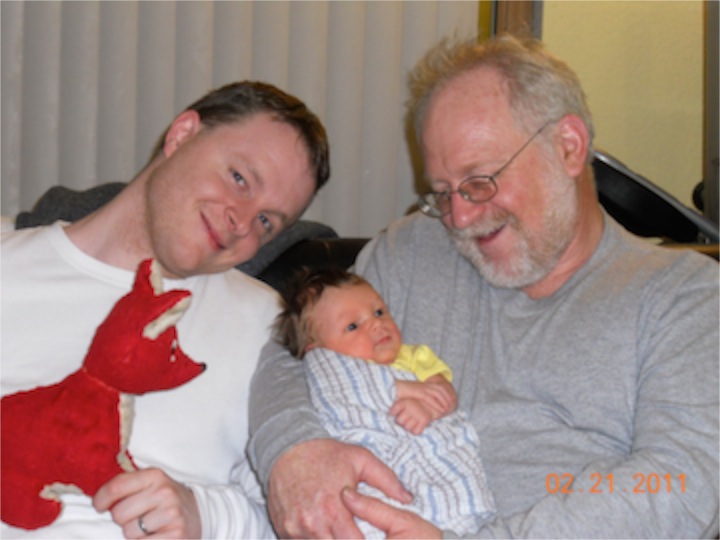
The journey of the first year has been incredible! I have been given the honor and privilege of staring into that tiny face as he slept and listening to the emerging giggle when he was awake. I have been amazed at the growth in size and he growth in abilities that have been the first year. It wasn’t my first experience with a baby. I got to be in on the adventure of the first year of his father’s life as well. There is something wonderful about being the grandfather. The rest of the family doesn’t seem to mind a bit of blubbering emotionalism and they don’t expect every idea that a grandfather proposes to be practical. In my experience, caring for a grandchild is accomplished with plenty of backup. The somewhat frightening experience of being alone and in charge that comes with your own children is replaced with a sense that there are plenty of helpful hands close by. When fat grandpa fingers can’t do the button, there is always someone who can make the task look easy. When grandpa’s application of the washcloth is less than thorough there is another gentle hand that cleans behind the ears and scrubs away the dirt grandpa missed. When a fussy baby’s needs are hard to understand, other loving hands will scoop the baby from grandpa and help find what is needed. Grandpa gets to be there for the winks and giggles and coos and smiles. The smiles can melt your heart.

One is a marvelous age as near as I can figure. I can’t remember my own experience of the number. I do know that there is no feeling like having your fingers grasped by those little hands and sensing the tug of one who is leaning into life and heading forward with the biggest steps he can take. I do know that there is no sound like the giggle of a boy discovering the game of tossing something on the floor for grandpa to retrieve. I do know that an old guy who is easily bored and always needs to have a book at hand can be mesmerized by sitting on the floor and tossing a ball back and forth with a child whose capacity for repetition provides the means to learn new things every day.
I guess I must be the most fortunate person in the world. And knowing that other grandfathers get to feel the same way does not diminish my joy in the least.
Elliot will not remember his first birthday. He would be happy and satisfied simply to be surrounded by the people in his life. A few bites of food and a sippy cup of water give him joy. A hug is a wonder. And he is completely entertained by someone who will offer hands to hold so he can walk around and around the room.
But as one who has a grandpa’s memory, it is a real treat to be here for the first birthday. Mom and dad have invested energy in planning a party, with thoughts of guests to invite and food to serve and some fun activities to share. Grandpa will pitch in with the work, but is quick to offer to hold the baby or play with him so others can do other chores. It is light duty for the old guy and he loves every minute of it.
If mom and dad think that grandpa gets a little carried away with presents, grandma understands that the gifts are mostly gifts for grandpa. He enjoyed shopping for the little guy more than he enjoys shopping for anything else. He’s not much of a shopper and isn’t attracted to stores and advertisements, but there is genuine pleasure in finding something that will be a fun toy for a one year old.

I’ve never aspired to be rich or famous, thought I once harbored career goals that were, in retrospect, a bit unrealistic. My ego was a bit over-inflated when I was a young man and I had to learn lessons in humility as I may my way through this life. When I was going through the process of discovering my vocation and establishing my career, I didn’t realize how quickly the days would pass and how soon my priorities would shift. But life has been a good teacher and somehow I keep discovering what is most important. I guess all of that is part of being the most fortunate person in the world.
Happy Birthday Elliot! You’ve got a lot more ahead of you and some will be much more memorable for you than this one. But it is a day your grandpa will never forget and I’m just glad I get to be here to see it.

By then we were having trouble keeping our emotions in check. Our anticipation was really, really strong. At 8:59 we got the message we were waiting for. It simply said: “Baby.” Through the wonders of electronic wizardry, there was also a picture on the screen of my cell phone.
And now it is one year later. What a year it has been! Developmental psychologists have long known that he first 18 months of life is a time of incredible growth and learning. An infant comes into the world in an incredibly vulnerable state. The child is dependent upon adults for all of his or her needs. And this world must be a very confusing thing at first sight for a newborn. Bright lights and an array of sounds that must sound like a cacophony surround the tiny one.
But there is also love. Babies are good at inspiring love. And those of us who are fortunate to meet them are clearly susceptible to love at first sight.
With great care and love a name was chosen: Elliot Thomas. A journey was begun. Like many epic journeys, my role will be to travel alongside for a little while. Though I was emotionally engaged and kept apprised of much of the beginning of the journey, I know that it is a journey that will stretch beyond the span of my time on this earth.

The journey of the first year has been incredible! I have been given the honor and privilege of staring into that tiny face as he slept and listening to the emerging giggle when he was awake. I have been amazed at the growth in size and he growth in abilities that have been the first year. It wasn’t my first experience with a baby. I got to be in on the adventure of the first year of his father’s life as well. There is something wonderful about being the grandfather. The rest of the family doesn’t seem to mind a bit of blubbering emotionalism and they don’t expect every idea that a grandfather proposes to be practical. In my experience, caring for a grandchild is accomplished with plenty of backup. The somewhat frightening experience of being alone and in charge that comes with your own children is replaced with a sense that there are plenty of helpful hands close by. When fat grandpa fingers can’t do the button, there is always someone who can make the task look easy. When grandpa’s application of the washcloth is less than thorough there is another gentle hand that cleans behind the ears and scrubs away the dirt grandpa missed. When a fussy baby’s needs are hard to understand, other loving hands will scoop the baby from grandpa and help find what is needed. Grandpa gets to be there for the winks and giggles and coos and smiles. The smiles can melt your heart.

One is a marvelous age as near as I can figure. I can’t remember my own experience of the number. I do know that there is no feeling like having your fingers grasped by those little hands and sensing the tug of one who is leaning into life and heading forward with the biggest steps he can take. I do know that there is no sound like the giggle of a boy discovering the game of tossing something on the floor for grandpa to retrieve. I do know that an old guy who is easily bored and always needs to have a book at hand can be mesmerized by sitting on the floor and tossing a ball back and forth with a child whose capacity for repetition provides the means to learn new things every day.
I guess I must be the most fortunate person in the world. And knowing that other grandfathers get to feel the same way does not diminish my joy in the least.
Elliot will not remember his first birthday. He would be happy and satisfied simply to be surrounded by the people in his life. A few bites of food and a sippy cup of water give him joy. A hug is a wonder. And he is completely entertained by someone who will offer hands to hold so he can walk around and around the room.
But as one who has a grandpa’s memory, it is a real treat to be here for the first birthday. Mom and dad have invested energy in planning a party, with thoughts of guests to invite and food to serve and some fun activities to share. Grandpa will pitch in with the work, but is quick to offer to hold the baby or play with him so others can do other chores. It is light duty for the old guy and he loves every minute of it.
If mom and dad think that grandpa gets a little carried away with presents, grandma understands that the gifts are mostly gifts for grandpa. He enjoyed shopping for the little guy more than he enjoys shopping for anything else. He’s not much of a shopper and isn’t attracted to stores and advertisements, but there is genuine pleasure in finding something that will be a fun toy for a one year old.

I’ve never aspired to be rich or famous, thought I once harbored career goals that were, in retrospect, a bit unrealistic. My ego was a bit over-inflated when I was a young man and I had to learn lessons in humility as I may my way through this life. When I was going through the process of discovering my vocation and establishing my career, I didn’t realize how quickly the days would pass and how soon my priorities would shift. But life has been a good teacher and somehow I keep discovering what is most important. I guess all of that is part of being the most fortunate person in the world.
Happy Birthday Elliot! You’ve got a lot more ahead of you and some will be much more memorable for you than this one. But it is a day your grandpa will never forget and I’m just glad I get to be here to see it.
Copyright © 2012 by Ted Huffman. I wrote this. If you want to copy it, please ask for permission. There is a contact me button at the bottom of this page. If you want to share my blog a friend, please direct your friend to my web site.
Amazing World
08/02/12 03:40
Thousands of people do it every day. I am sure that people learn to take it for granted. But it still amazes me. Yesterday we got up in Rapid City. It was about 19 degrees with a skiff of snow on the ground. We headed out to the airport where our airplane boarded a few minutes early so there would be time to de-ice the plane for an on-time departure. We ended up leaving Rapid City about 8 minutes late, and arrived in Denver about 5 minutes behind the scheduled time. The weather in Denver was blustery with wind and blowing snow. We had no trouble with our connection and soon were on our way to Seattle. We gathered our luggage at the airport and walked to the shuttle stop where our van was waiting for us. An hour later we were at our motel in Olympia. Our son came by on his lunch hour and took us out to lunch.
We had breakfast in Rapid City, South Dakota, and lunch in Olympia, Washington on the same day. It never ceases to amaze me.
I grew up around airplanes. I soloed as soon as I was old enough. I got my pilot’s license when I was 17. That summer, as I was waiting for my birthday so I could take my flying test, I would fly 500 miles before work some days. I have known a life of many wonderful trips and a few fairly long ones. I have flown from Calgary, BC to Amsterdam, Netherlands; from Los Angeles to Melbourne, Australia; from Vancouver, BC to London. I’ve made some of the big trips. I grew up expecting to travel. Through my father’s connections, I got a ride on the first 747 that Northwest Airlines bought. I’ve ridden in the jump seat as an airline pilot takes a check ride being examined for proficiency in instrument procedures. I’ve had my 15 minutes in the left seat of the B-1 Lancer Bomber full motion flight simulator. I’ve sort of grown up to expect that there are some incredible journeys in life.
What amazes me is the amount of travel that is routine in our world today. It is not just incredible that we can cover such a distance in so short an amount of time, but also that such travel is routine. This isn’t the first time we have made the trip from home to the West Coast in a half of a day. We expect to be able to make such trips on a regular basis. Such long-distance travel was virtually unknown to previous generations. And there are still many people in the world for whom the kind of trips we take for granted are simply impossible.

As we traveled across Idaho yesterday, the skies began to clear. From the airplane, we could see the giants of he northern cascades appear: Mt. Hood, Mt. Adams, Mt. St. Helens and Mt. Rainier. Our flight path took us just to the north of Mt. Rainier where we could get a good look at the snow-covered peak. I was reminded how these mountains were sacred places to the people who dwelt in this area long before there were any methods of high-speed travel. When there were just a few people living in the area, they could see the mountain that we know as Mt. Rainier from the Puget Sound. The people lived close to the water, eating from the rich stores of seafood that were abundant in the relatively calm waters of the sound. On clear days, however, they could see the Olympic Mountains to the West and the Cascades to the east. Mt. Rainier was so high and prominent that it was impossible to ignore. Some of the people were drawn to the mountain and undertook the journey for a closer look. We don’t know whether or not early people climbed to the peak. It is unlikely, as the peak is covered in snow and ice all year around and such a climb is treacherous, even with modern equipment. But they would have had to walk for several days even to make the walk up the base of the mountain. And even if they only climbed part way up, they would have had an incredible view.
Yesterday, as our plane descended, we could see the sound stretching to the south to Olympia and to the north towards Vancouver Island. The day was beautiful and clear and the surface of the water was dotted with all kinds of boats. Several huge ocean-going freighters were being unloaded in the ports and others were making their way across the water. On the land the highways were filled with cars and trucks heading in every direction. We are a mobile people and we have developed a lifestyle that is dependent upon moving great amounts of goods over great distances. It is not just that we rode the airplanes yesterday. So did the mail, fresh food and produce, and a variety of other items. We are used to going to the grocery store and being able to purchase seafood that was fresh caught just hours before the store opened. We have grown accustomed to having fresh fruits and vegetables every day and in every season. The systems of transportation are so reliable that we rarely think of them. Usually it takes a temporary disruption in the transportation to get us to notice at all.
The real treasure for us, of course, is to be able to share time with our family. For generations families have parted as one or more members choose to live in different locations. In the past, having a child move thousands of miles away meant that face-to-face contact was rare. Even reliable mail service is a relatively new phenomenon in human history. These days, we are able to videoconference regularly and see one another whenever we want.

In the early afternoon we went to the day care center where our grandson stays when his parents are working. He woke from his nap and recognized us. It is a simple thing, really. And nonetheless it is amazing. We live a long way from his home. Tomorrow he will be one year old. And even though we live in different places we are able to maintain a close relationship. We live in an amazing world. And we are indeed fortunate.
We had breakfast in Rapid City, South Dakota, and lunch in Olympia, Washington on the same day. It never ceases to amaze me.
I grew up around airplanes. I soloed as soon as I was old enough. I got my pilot’s license when I was 17. That summer, as I was waiting for my birthday so I could take my flying test, I would fly 500 miles before work some days. I have known a life of many wonderful trips and a few fairly long ones. I have flown from Calgary, BC to Amsterdam, Netherlands; from Los Angeles to Melbourne, Australia; from Vancouver, BC to London. I’ve made some of the big trips. I grew up expecting to travel. Through my father’s connections, I got a ride on the first 747 that Northwest Airlines bought. I’ve ridden in the jump seat as an airline pilot takes a check ride being examined for proficiency in instrument procedures. I’ve had my 15 minutes in the left seat of the B-1 Lancer Bomber full motion flight simulator. I’ve sort of grown up to expect that there are some incredible journeys in life.
What amazes me is the amount of travel that is routine in our world today. It is not just incredible that we can cover such a distance in so short an amount of time, but also that such travel is routine. This isn’t the first time we have made the trip from home to the West Coast in a half of a day. We expect to be able to make such trips on a regular basis. Such long-distance travel was virtually unknown to previous generations. And there are still many people in the world for whom the kind of trips we take for granted are simply impossible.

As we traveled across Idaho yesterday, the skies began to clear. From the airplane, we could see the giants of he northern cascades appear: Mt. Hood, Mt. Adams, Mt. St. Helens and Mt. Rainier. Our flight path took us just to the north of Mt. Rainier where we could get a good look at the snow-covered peak. I was reminded how these mountains were sacred places to the people who dwelt in this area long before there were any methods of high-speed travel. When there were just a few people living in the area, they could see the mountain that we know as Mt. Rainier from the Puget Sound. The people lived close to the water, eating from the rich stores of seafood that were abundant in the relatively calm waters of the sound. On clear days, however, they could see the Olympic Mountains to the West and the Cascades to the east. Mt. Rainier was so high and prominent that it was impossible to ignore. Some of the people were drawn to the mountain and undertook the journey for a closer look. We don’t know whether or not early people climbed to the peak. It is unlikely, as the peak is covered in snow and ice all year around and such a climb is treacherous, even with modern equipment. But they would have had to walk for several days even to make the walk up the base of the mountain. And even if they only climbed part way up, they would have had an incredible view.
Yesterday, as our plane descended, we could see the sound stretching to the south to Olympia and to the north towards Vancouver Island. The day was beautiful and clear and the surface of the water was dotted with all kinds of boats. Several huge ocean-going freighters were being unloaded in the ports and others were making their way across the water. On the land the highways were filled with cars and trucks heading in every direction. We are a mobile people and we have developed a lifestyle that is dependent upon moving great amounts of goods over great distances. It is not just that we rode the airplanes yesterday. So did the mail, fresh food and produce, and a variety of other items. We are used to going to the grocery store and being able to purchase seafood that was fresh caught just hours before the store opened. We have grown accustomed to having fresh fruits and vegetables every day and in every season. The systems of transportation are so reliable that we rarely think of them. Usually it takes a temporary disruption in the transportation to get us to notice at all.
The real treasure for us, of course, is to be able to share time with our family. For generations families have parted as one or more members choose to live in different locations. In the past, having a child move thousands of miles away meant that face-to-face contact was rare. Even reliable mail service is a relatively new phenomenon in human history. These days, we are able to videoconference regularly and see one another whenever we want.

In the early afternoon we went to the day care center where our grandson stays when his parents are working. He woke from his nap and recognized us. It is a simple thing, really. And nonetheless it is amazing. We live a long way from his home. Tomorrow he will be one year old. And even though we live in different places we are able to maintain a close relationship. We live in an amazing world. And we are indeed fortunate.
Copyright © 2012 by Ted Huffman. I wrote this. If you want to copy it, please ask for permission. There is a contact me button at the bottom of this page. If you want to share my blog a friend, please direct your friend to my web site.
Moral Imagination
07/02/12 04:00
In 1790 Edmund Burke published a book titled Reflections on the Revolution in France. Among other things, he describes the destruction of civilizing manners by the revolutionaries. He recoils against the breakdown or order and doesn’t quite comprehend the thrust of revolution to make the world better. In that book, he coined the phrase “moral imagination.”

“All the decent drapery of life is to be rudely torn off. All the superadded ideas, furnished from the wardrobe of a moral imagination, which the heart owns, and the understanding ratifies, as necessary to cover the defects of our naked shivering nature, and to raise it to dignity in our own estimation, are to be exploded as a ridiculous, absurd, and antiquated fashion.”
I am not sure that I understand Burke’s descriptions, but the term “moral imagination” has caught on. In 2005, John Paul Lederach published a book titled “The Moral Imagination: The Art and Soul of Building Peace.” Lederach is internationally recognized as a leader in conciliation and mediation. He has provided direct conciliation services around the world from Nicaragua to Somalia, Northern Ireland, the Basque Country and the Philippines.

His assertion is that resolving conflicts without violence requires creative action. The inspiration for creation is always imagination. Making a creation is always art. Peace begins with the ability to envision peace. This world requires a moral imagination – the ability to envision a world where justice is achieved without violence.
Achieving peace is not easy. In fact imagining peace is not easy. John Horgan is a professor in the Center for Science Writings at Stevens Institute of Technology in Hoboken New Jersey. He is a widely recognized author in scientific journals. For several years now, he has been informally asking people whether they think that there will be a time when war will end. He has surveyed liberal, conservative, female, male, affluent, poor, educated, and uneducated people. Over 80% believe that war will never end. The numbers are even less hopeful among young people. Students in his classes are about 90% in agreement that there will never be a time when people do not go to war against each other.
Many experts agree that war is inevitable. Even our President, Barak Obama, winner of the Nobel Peace Prize believes that war is endemic to human nature: “War, in one form or another, appeared with the first man . . . We must begin by acknowledging the hard truth: we will not eradicate violent conflict in our lifetime.” (From a speech given at West Point on December 1, 2009.)
The majority of the people in our country believe that war is a perpetual condition of human beings. We seem to be unable to imagine a world at peace. Perhaps we have lost our moral imagination. If indeed we cannot imagine a world at peace, what other elements of the prophetic vision are we incapable of believing? Have we lost our ability to imagine proper care for widows and orphans? Do we believe that we are condemned to a world where there is a class of people who live in perpetual poverty?
The stories of our people are filled with times when we forgot the path to which we have been called. Not long after God lead us out of the land of Slavery through the Red Sea, we began to operate out of fear. We had no experience in the wilderness. We wondered where our next meal would come from. We felt thirsty. We forgot to trust God. Even after God had demonstrated the great power and investment in the people to bring us into the land of freedom, we quickly forgot that we could trust. Even after our bellies were full and our thirst quenched, we continued to lose our ability to imagine what it was that God was calling us to do.
When Moses went up on the mountain, our people convinced themselves that a golden calf that they could see was preferable to a God they could not see. We wondered what God might look like. We didn’t seem to have the ability to imagine. And each time we suffered a failure of imagination, God gave us leaders to inspire us and to remind us that God calls us to imagine a world that is different than the humdrum of our everyday lives.
![The%20Prophet%20Jeremiah%20after%20Rembrant[1]](the002520prophet002520jeremiah002520after002520rembrant005b1005d.jpg)
After the establishment of a settled monarchy in Israel, the leaders and many of the people got caught up in the repetition of ritual acts. They even convinced themselves that if they said the right prayers and observed the right rituals that they could go about their everyday lives and retain their favor with God. In those days God sent prophets to remind all of the people of the simple truth that relationship with God is about everyday living as much as temple observance. The prophets pointed out the failure to share; the treatment of widows, orphans, and immigrants; and the failure to give justice to all of the people as moral issues – issues that threatened Israel’s relationship with God and the very future of the community.
It is no mystery that the prophets used poetry to communicate their message. Read any of the major Biblical prophets. Spend time in their poetic images. Simple language was insufficient to convey the deep concepts that were critical to the life of the community. God inspired the prophets to think beyond the normal bounds of language. It took creative imagination to create and to read the poetry of God’s truth. These days, thousands of years later, we are inspired to greater imagination through reading the words of the prophets.
Once again our people need a recovery of imagination. If we can no longer imagine a world of justice, peace and compassion, we cannot live in step with God’s call for our lives. God’s call is clear. The prophet Micah put it this way: “God has told you, O human, what is good. And what does the LORD require of you? To act justly and to love mercy and to walk humbly with your God.”
May God grant us a renewal of our moral imagination in this generation.

“All the decent drapery of life is to be rudely torn off. All the superadded ideas, furnished from the wardrobe of a moral imagination, which the heart owns, and the understanding ratifies, as necessary to cover the defects of our naked shivering nature, and to raise it to dignity in our own estimation, are to be exploded as a ridiculous, absurd, and antiquated fashion.”
I am not sure that I understand Burke’s descriptions, but the term “moral imagination” has caught on. In 2005, John Paul Lederach published a book titled “The Moral Imagination: The Art and Soul of Building Peace.” Lederach is internationally recognized as a leader in conciliation and mediation. He has provided direct conciliation services around the world from Nicaragua to Somalia, Northern Ireland, the Basque Country and the Philippines.

His assertion is that resolving conflicts without violence requires creative action. The inspiration for creation is always imagination. Making a creation is always art. Peace begins with the ability to envision peace. This world requires a moral imagination – the ability to envision a world where justice is achieved without violence.
Achieving peace is not easy. In fact imagining peace is not easy. John Horgan is a professor in the Center for Science Writings at Stevens Institute of Technology in Hoboken New Jersey. He is a widely recognized author in scientific journals. For several years now, he has been informally asking people whether they think that there will be a time when war will end. He has surveyed liberal, conservative, female, male, affluent, poor, educated, and uneducated people. Over 80% believe that war will never end. The numbers are even less hopeful among young people. Students in his classes are about 90% in agreement that there will never be a time when people do not go to war against each other.
Many experts agree that war is inevitable. Even our President, Barak Obama, winner of the Nobel Peace Prize believes that war is endemic to human nature: “War, in one form or another, appeared with the first man . . . We must begin by acknowledging the hard truth: we will not eradicate violent conflict in our lifetime.” (From a speech given at West Point on December 1, 2009.)
The majority of the people in our country believe that war is a perpetual condition of human beings. We seem to be unable to imagine a world at peace. Perhaps we have lost our moral imagination. If indeed we cannot imagine a world at peace, what other elements of the prophetic vision are we incapable of believing? Have we lost our ability to imagine proper care for widows and orphans? Do we believe that we are condemned to a world where there is a class of people who live in perpetual poverty?
The stories of our people are filled with times when we forgot the path to which we have been called. Not long after God lead us out of the land of Slavery through the Red Sea, we began to operate out of fear. We had no experience in the wilderness. We wondered where our next meal would come from. We felt thirsty. We forgot to trust God. Even after God had demonstrated the great power and investment in the people to bring us into the land of freedom, we quickly forgot that we could trust. Even after our bellies were full and our thirst quenched, we continued to lose our ability to imagine what it was that God was calling us to do.
When Moses went up on the mountain, our people convinced themselves that a golden calf that they could see was preferable to a God they could not see. We wondered what God might look like. We didn’t seem to have the ability to imagine. And each time we suffered a failure of imagination, God gave us leaders to inspire us and to remind us that God calls us to imagine a world that is different than the humdrum of our everyday lives.
![The%20Prophet%20Jeremiah%20after%20Rembrant[1]](the002520prophet002520jeremiah002520after002520rembrant005b1005d.jpg)
After the establishment of a settled monarchy in Israel, the leaders and many of the people got caught up in the repetition of ritual acts. They even convinced themselves that if they said the right prayers and observed the right rituals that they could go about their everyday lives and retain their favor with God. In those days God sent prophets to remind all of the people of the simple truth that relationship with God is about everyday living as much as temple observance. The prophets pointed out the failure to share; the treatment of widows, orphans, and immigrants; and the failure to give justice to all of the people as moral issues – issues that threatened Israel’s relationship with God and the very future of the community.
It is no mystery that the prophets used poetry to communicate their message. Read any of the major Biblical prophets. Spend time in their poetic images. Simple language was insufficient to convey the deep concepts that were critical to the life of the community. God inspired the prophets to think beyond the normal bounds of language. It took creative imagination to create and to read the poetry of God’s truth. These days, thousands of years later, we are inspired to greater imagination through reading the words of the prophets.
Once again our people need a recovery of imagination. If we can no longer imagine a world of justice, peace and compassion, we cannot live in step with God’s call for our lives. God’s call is clear. The prophet Micah put it this way: “God has told you, O human, what is good. And what does the LORD require of you? To act justly and to love mercy and to walk humbly with your God.”
May God grant us a renewal of our moral imagination in this generation.
Copyright © 2012 by Ted Huffman. I wrote this. If you want to copy it, please ask for permission. There is a contact me button at the bottom of this page. If you want to share my blog a friend, please direct your friend to my web site.
Hype
06/02/12 05:16
OK The Super Bowl is over for another year. Frankly, it is OK by me. I’m not that much of a football fan. We don’t own a big screen TV and we don’t seem to want one. We sort of pay attention to the teams and I watched a few playoff games. But I am in no way a fan and not the target demographic for the advertisers.

The truth is, however, that we live our lives in the midst of our culture. As much as we want to be shapers of culture, it is silly to think that we are not shaped by the culture. If you don’t believe me, you should have been in our church yesterday. Once again, as we have been doing for a dozen years, we made significant mention of the Super Bowl in our worship service. It makes sense to do so. The Souper Bowl of Caring is a way to take the spirit of the day an turn it into an opportunity to make a significant opportunity to combat hunger in our community and around the world. With relatively small effort, the youth raised hundreds of dollars and gathered pounds of healthy food to benefit local charities.
Here is the statistic that bothers me. Last year, our congregation was the second largest donor to Church Response, the local organization that works to give assistance to hungry and needy families in our community. I’m proud of our church and of our efforts to make a difference. I am bothered that a congregation that is less than a fourth the size of the biggest congregations in town is the number 2 donor. Where are the big churches when it comes to a combined effort to serve the hungry and needy people of our community?
Once again, I come to the conclusion that bigger isn’t always better. At least I am convinced that God isn’t calling us to grow by imitating the bigger churches. We are called to be faithful in service. Once again, “Not so with you. Instead, whoever wants to become great among you must be your servant.” (Matthew 20:6) May we become servants.
This means that we will have to get used to operating with a lot less attention. In the eyes of the world, what we are doing is pretty small potatoes. 30 seconds of Super Bowl advertising is equal to about ten years of operation for our entire church.
From time to time, members of our congregation ask me why we don’t do more advertising. They come to me with a genuine belief that we should have better public relations.

I really don’t know much about advertising. I am not good at public relations. And part of the reason is that these are not important to me. I’ve never been good at blowing my own horn. What seems to work in Super Bowl advertising doesn’t appeal to me at all. I know that the ads of the Super Bowl receive a lot of attention. Stories about the ads are as common as stories about the game in news reporting. This year all of the ads were released in advance, so there were no surprises and, quite frankly, I didn’t watch too many of them.
I don’t make purchase decisions based on who is shown in his or her underwear or swimming suit. Celebrities don’t make that much of an impression on me, either. The idea of Clint Eastwood staring in a 2-minute commercial for Chrysler sounded intriguing to me, but I didn’t watch the half time of the game and by the time I got around to looking up the ad on YouTube, it had been pulled due to a copyright dispute between YouTube and NFL Properties. The basic thrust of the commercial is that despite the recession, the game isn’t over and that America and American manufacturing are ready to stay in the game. Chrysler was said to have tried to keep the commercial under wraps before the game, but You Tube reported more than 21 million views before it pulled the ad.
I could care less if Jay Leno and Jerry Seinfeld want to compete for a car. I’m pretty sure if those two are fighting over it, it would be something I cannot afford.
Quite frankly, the ads I saw weren’t that innovative. I don’t watch much TV and I know the E-trade baby and Careerbuilder.com chimps are relics of many past Super Bowls. There was a Honda ad that was a spin off of the movie “Ferris Bueller’s Day Off.” I’ve already seen that movie.
The ads probably didn’t influence any of my purchase decisions. Then again, I’m not very typical.
To me the whole phenomenon is hype. That is it is excessive. The publicity is excessive, the claims made by the promoters are extravagant, there are more than a few exaggerated takes on the real world.

In the face of all of the hype, I think a fair amount of countercultural thinking is warranted. I have nothing against sports, but the game really wasn’t the most important thing going on yesterday. Ask any person living in the Syrian city of Homs, in which anti-government activists are being attacked with heavy artillery. Ask the residents of the West Bank and Gaza Strip who are trying to work out an interim unity government as they prepare for elections. Ask the families of the people, including women and children who are trapped in the collapse of a factory building in Lahore, Pakistan. Ask the families who have had to leave their homes as floods inundate Queensland, Australia, for the second year in a row.
Our culture wants us to believe that the game was the biggest thing going on yesterday. I was big. It might not have been the most important. As a lesson for churches, I think, it is that we aren’t called to imitate. We can be more efficient and less extravagant with God’s gifts. We can be more truthful and less exaggerated with the words we use. We can be more compassionate and less combative in relationship to other people.
For now, I’m glad we aren’t in the hype business. For what it is worth, I hope we stay out of it.

The truth is, however, that we live our lives in the midst of our culture. As much as we want to be shapers of culture, it is silly to think that we are not shaped by the culture. If you don’t believe me, you should have been in our church yesterday. Once again, as we have been doing for a dozen years, we made significant mention of the Super Bowl in our worship service. It makes sense to do so. The Souper Bowl of Caring is a way to take the spirit of the day an turn it into an opportunity to make a significant opportunity to combat hunger in our community and around the world. With relatively small effort, the youth raised hundreds of dollars and gathered pounds of healthy food to benefit local charities.
Here is the statistic that bothers me. Last year, our congregation was the second largest donor to Church Response, the local organization that works to give assistance to hungry and needy families in our community. I’m proud of our church and of our efforts to make a difference. I am bothered that a congregation that is less than a fourth the size of the biggest congregations in town is the number 2 donor. Where are the big churches when it comes to a combined effort to serve the hungry and needy people of our community?
Once again, I come to the conclusion that bigger isn’t always better. At least I am convinced that God isn’t calling us to grow by imitating the bigger churches. We are called to be faithful in service. Once again, “Not so with you. Instead, whoever wants to become great among you must be your servant.” (Matthew 20:6) May we become servants.
This means that we will have to get used to operating with a lot less attention. In the eyes of the world, what we are doing is pretty small potatoes. 30 seconds of Super Bowl advertising is equal to about ten years of operation for our entire church.
From time to time, members of our congregation ask me why we don’t do more advertising. They come to me with a genuine belief that we should have better public relations.

I really don’t know much about advertising. I am not good at public relations. And part of the reason is that these are not important to me. I’ve never been good at blowing my own horn. What seems to work in Super Bowl advertising doesn’t appeal to me at all. I know that the ads of the Super Bowl receive a lot of attention. Stories about the ads are as common as stories about the game in news reporting. This year all of the ads were released in advance, so there were no surprises and, quite frankly, I didn’t watch too many of them.
I don’t make purchase decisions based on who is shown in his or her underwear or swimming suit. Celebrities don’t make that much of an impression on me, either. The idea of Clint Eastwood staring in a 2-minute commercial for Chrysler sounded intriguing to me, but I didn’t watch the half time of the game and by the time I got around to looking up the ad on YouTube, it had been pulled due to a copyright dispute between YouTube and NFL Properties. The basic thrust of the commercial is that despite the recession, the game isn’t over and that America and American manufacturing are ready to stay in the game. Chrysler was said to have tried to keep the commercial under wraps before the game, but You Tube reported more than 21 million views before it pulled the ad.
I could care less if Jay Leno and Jerry Seinfeld want to compete for a car. I’m pretty sure if those two are fighting over it, it would be something I cannot afford.
Quite frankly, the ads I saw weren’t that innovative. I don’t watch much TV and I know the E-trade baby and Careerbuilder.com chimps are relics of many past Super Bowls. There was a Honda ad that was a spin off of the movie “Ferris Bueller’s Day Off.” I’ve already seen that movie.
The ads probably didn’t influence any of my purchase decisions. Then again, I’m not very typical.
To me the whole phenomenon is hype. That is it is excessive. The publicity is excessive, the claims made by the promoters are extravagant, there are more than a few exaggerated takes on the real world.

In the face of all of the hype, I think a fair amount of countercultural thinking is warranted. I have nothing against sports, but the game really wasn’t the most important thing going on yesterday. Ask any person living in the Syrian city of Homs, in which anti-government activists are being attacked with heavy artillery. Ask the residents of the West Bank and Gaza Strip who are trying to work out an interim unity government as they prepare for elections. Ask the families of the people, including women and children who are trapped in the collapse of a factory building in Lahore, Pakistan. Ask the families who have had to leave their homes as floods inundate Queensland, Australia, for the second year in a row.
Our culture wants us to believe that the game was the biggest thing going on yesterday. I was big. It might not have been the most important. As a lesson for churches, I think, it is that we aren’t called to imitate. We can be more efficient and less extravagant with God’s gifts. We can be more truthful and less exaggerated with the words we use. We can be more compassionate and less combative in relationship to other people.
For now, I’m glad we aren’t in the hype business. For what it is worth, I hope we stay out of it.
Copyright © 2012 by Ted Huffman. I wrote this. If you want to copy it, please ask for permission. There is a contact me button at the bottom of this page. If you want to share my blog a friend, please direct your friend to my web site.
Toy Tractors
05/02/12 05:16
My father started out as a pilot. After World War II, he settled in a small town and began to run the local airport with a variety of aviation services. He sold airplanes and fuel, did repairs, sprayed crops, did charter work, ran an air ambulance, flew fire patrols, counted animals for the fish and game service and even hunted coyotes from his airplanes. Most days were consumed with working and thinking of new ways to ear a few dollars flying airplanes. It wasn’t easy to make a living. One had to plan carefully. In those days it took more than piloting skill to earn a living in the aviation business. It took an entrepreneurial spirit.
Somewhere along the way, he decided to expand his business interests beyond the airport and purchased Big Timber Farm Supply, the local John Deere dealership. John Deere was preparing for a major change in its tractors, leaving behind the old two-cylinder tractors that had been famous for their sound and reliability. The line of more powerful tractors was introduced as “a new generation of power.” It was a good time to go into the farm machinery business.
He quickly built his business into a service-based dealership. He purchased a truck to haul machines into the shop and developed an extensive parts inventory.

And he stocked a full line of toys. In the days before licensing of John Deere Products to lots of different manufacturers, Ertl Toys made all of the John Deere toys. They were die cast steel toys with rubber tires and they looked authentic. The Farm Supply kept all of the toys including tractors, bailers, combines, plows, wagons and more. The most popular toys were 1/16 scale. I think that dad enjoyed selling the toys as much as he did the full sized tractors. He began to take trade-ins on the toys. Kids in our town knew that they could get a fair deal from my dad and that he would give them a little something for their old Tonka trucks. He especially delighted in taking in toys that were modeled after Ford, Farmall or Case tractors. Each year he’d have a big box for the toys for tots Christmas drive. He’d usually have a few tractors of the competitor’s brands with broken wheels or other defects on display next to the shining new toys.
Over the years, my brothers and I had most of the available John Deere toys. We each had a tractor and there was an assortment of other implements in our toy boxes. I was a bit too old when he went into the John Deere business to have my turn on the riding tractor, but there was one of those at our house for the littler boys.
These days those Ertl toys are collectors’ items. I suppose that if we had kept them, they would have a great deal of value. But we played with our toys. And we played hard with them. Tractors were for outdoors work and ours spend nights in the sand box or in the dirt next to the swing set. They got the paint rubbed off of them and had plenty of signs of hard play. My dad appreciated that as well. He was proud of the fact that the first tractor he sold, a used model R, was still in the field and working 25 years after he went into the business.
As a teenager, I began to operate the real machines. I spent a couple of summers working summer fallow on my cousin’s place in the dust and heat behind a popping 2-cylander diesel. I learned the procedure for starting the diesel with a gasoline pony engine for a starting motor and the operation of the hand clutch. I worked mile-long strips with a 12’ toolbar. The tractor was rated at 35 drawbar horsepower. In those days anything over 100 drawbar horsepower was considered to be a big tractor. The big 8010 John Deere, sporting 215 hp was considered to be simply too big for our country.
The times have changed. The small farms began to disappear. The large farms began to get bigger and bigger. When I was away in school and during the first years of my career, the farm crisis deeply changed American farming practices. The result was that the tractors began to get bigger and bigger. These days, farmers work their fields with articulated 4 wheel drive tractors with over 400 horsepower. The machines are too big and two expensive to let a high school kid operate. With a price tag that tops a quarter of a million dollars for a used tractor, the farms have serious investments to protect.

I headed off to college with a small set of seven 1/64 scale toy tractors. It was a promotional set, designed to illustrate the history of John Deere tractors. The first tractor was a Waterloo Boy from about 1918, the year the John Deere bought the company and went into the tractor business. There were various other models including a GP, an AW and a 720 all the way up to the seventh toy in the set, a 4010 from the mid ‘60’s. Those tractors have been sitting on a bookshelf in my home since the early 1970’s. They’ve survived the moves from one home to another. Over the years, I have added another seven tractors to the collection, all 1/64 scale. My latest acquisition is a 2009 8295RT. While not the biggest tractor in the collection, it demonstrates advanced technology with the rubber track system. The “big” tractor in my little collection is a 9430 with triple tires on all four corners.

There is no practical reason for me to have a collection of tractors. They collect dust and they have to be moved to get the books off of the shelf. They are too small for young children to play with. The collection has very little value. They aren’t real antiques, just some toys that I have kept around. But there are lots of things in life that aren’t practical. The tractors remind me of a phase of my own life and of the joy of sharing an interest with my father. I can look at them and remember what it felt like to check out the new toys when they arrived at my dad’s shop.
And, once in a while, the tractors bring a smile to the face of a visitor. When someone comes into my library and heads to the tractors first, I know that we will have something to talk about.
Perhaps we all need a bit of silliness from time to time.
Somewhere along the way, he decided to expand his business interests beyond the airport and purchased Big Timber Farm Supply, the local John Deere dealership. John Deere was preparing for a major change in its tractors, leaving behind the old two-cylinder tractors that had been famous for their sound and reliability. The line of more powerful tractors was introduced as “a new generation of power.” It was a good time to go into the farm machinery business.
He quickly built his business into a service-based dealership. He purchased a truck to haul machines into the shop and developed an extensive parts inventory.

And he stocked a full line of toys. In the days before licensing of John Deere Products to lots of different manufacturers, Ertl Toys made all of the John Deere toys. They were die cast steel toys with rubber tires and they looked authentic. The Farm Supply kept all of the toys including tractors, bailers, combines, plows, wagons and more. The most popular toys were 1/16 scale. I think that dad enjoyed selling the toys as much as he did the full sized tractors. He began to take trade-ins on the toys. Kids in our town knew that they could get a fair deal from my dad and that he would give them a little something for their old Tonka trucks. He especially delighted in taking in toys that were modeled after Ford, Farmall or Case tractors. Each year he’d have a big box for the toys for tots Christmas drive. He’d usually have a few tractors of the competitor’s brands with broken wheels or other defects on display next to the shining new toys.
Over the years, my brothers and I had most of the available John Deere toys. We each had a tractor and there was an assortment of other implements in our toy boxes. I was a bit too old when he went into the John Deere business to have my turn on the riding tractor, but there was one of those at our house for the littler boys.
These days those Ertl toys are collectors’ items. I suppose that if we had kept them, they would have a great deal of value. But we played with our toys. And we played hard with them. Tractors were for outdoors work and ours spend nights in the sand box or in the dirt next to the swing set. They got the paint rubbed off of them and had plenty of signs of hard play. My dad appreciated that as well. He was proud of the fact that the first tractor he sold, a used model R, was still in the field and working 25 years after he went into the business.
As a teenager, I began to operate the real machines. I spent a couple of summers working summer fallow on my cousin’s place in the dust and heat behind a popping 2-cylander diesel. I learned the procedure for starting the diesel with a gasoline pony engine for a starting motor and the operation of the hand clutch. I worked mile-long strips with a 12’ toolbar. The tractor was rated at 35 drawbar horsepower. In those days anything over 100 drawbar horsepower was considered to be a big tractor. The big 8010 John Deere, sporting 215 hp was considered to be simply too big for our country.
The times have changed. The small farms began to disappear. The large farms began to get bigger and bigger. When I was away in school and during the first years of my career, the farm crisis deeply changed American farming practices. The result was that the tractors began to get bigger and bigger. These days, farmers work their fields with articulated 4 wheel drive tractors with over 400 horsepower. The machines are too big and two expensive to let a high school kid operate. With a price tag that tops a quarter of a million dollars for a used tractor, the farms have serious investments to protect.

I headed off to college with a small set of seven 1/64 scale toy tractors. It was a promotional set, designed to illustrate the history of John Deere tractors. The first tractor was a Waterloo Boy from about 1918, the year the John Deere bought the company and went into the tractor business. There were various other models including a GP, an AW and a 720 all the way up to the seventh toy in the set, a 4010 from the mid ‘60’s. Those tractors have been sitting on a bookshelf in my home since the early 1970’s. They’ve survived the moves from one home to another. Over the years, I have added another seven tractors to the collection, all 1/64 scale. My latest acquisition is a 2009 8295RT. While not the biggest tractor in the collection, it demonstrates advanced technology with the rubber track system. The “big” tractor in my little collection is a 9430 with triple tires on all four corners.

There is no practical reason for me to have a collection of tractors. They collect dust and they have to be moved to get the books off of the shelf. They are too small for young children to play with. The collection has very little value. They aren’t real antiques, just some toys that I have kept around. But there are lots of things in life that aren’t practical. The tractors remind me of a phase of my own life and of the joy of sharing an interest with my father. I can look at them and remember what it felt like to check out the new toys when they arrived at my dad’s shop.
And, once in a while, the tractors bring a smile to the face of a visitor. When someone comes into my library and heads to the tractors first, I know that we will have something to talk about.
Perhaps we all need a bit of silliness from time to time.
Copyright © 2012 by Ted Huffman. I wrote this. If you want to copy it, please ask for permission. There is a contact me button at the bottom of this page. If you want to share my blog a friend, please direct your friend to my web site.
Living in Tension
04/02/12 05:37
Change always involves tension. There is always an element of saying goodbye to the past when embracing the future. Saying goodbye involves grief. But there is a lure to the future and an excitement that comes with the sense of moving forward. Most institutions struggle with change. There is a bit of inertia that is built into any organization. There is a tendency to want to maintain what has been built.
But change cannot be stopped. It is a part of the world. And we see the tensions of change all around us.
I often refer to museums as one of the examples of change in the world. You would think that museums, with their focus on the past and on what has already happened, would establish their displays and then look the same year after year. But I can think of no museum that I have visited multiple times that does not look very different from the way it looked years ago. Static displays have been replaced with dynamic interactive experiences. Dioramas have been replaced with video screens. Even the stories being told have changed. When I was younger, many museums presented a very Euro-centric interpretation of history. It was not uncommon for a museum to portray indigenous people as primitive, lacking culture and ignorant. Some museums displayed sacred items and even human remains without any information about the deep spiritual meanings of the objects. Times have changed.
Times have changed in the church as well. And change in the church is filled with tension if, for no other reason that we see maintaining traditions to be at the core of our identity. Many churches use the Wesleyan Quadrilateral as one of the ways of interpreting their core values. Put simply, the Quadrilateral states that there are four ways of knowing God: scripture, tradition, reason and experience. Some add revelation to the four.
If history and tradition are one of the ways of knowing God, it is impossible to simply throw out the tradition. Even as we long to embrace the future, we carry the weight of the past within our church structures and organization.
So it may always have been that the institutional church has consisted of many different parts held in tension and sometimes giving rise to conflict. It seems to be a mode of existence for the congregation I serve. Being the first Christian congregation established in our city, our church is proud of its history and traditions. We have generations of shared experience and a sense of being well established in our community. We like to tell the story of our founding and of our establishment. Our church parlor boasts photographs of all of the different buildings that have been home to our congregation. We offer books about the church’s history as a free gift to members and those seeking to become affiliated with our congregation. Our congregation is home to four emeritus staff members and at least eight retired clergy persons. Even though our sanctuary is very modern it its design, the building that houses our congregation is now more than 50 years old. We even held an anniversary celebration on the occasion of our building’s 50th year.
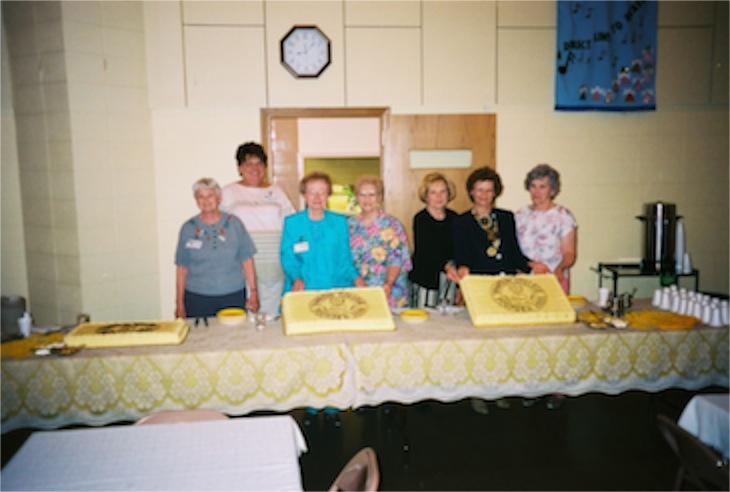
We are also a congregation that is slightly older than the surrounding population. And the population of our community is heavily retired. South Dakota tends to export the majority of its youth to spend their working lives in other places and this is even more so of Rapid City than of the cities on the Eastern edge of our state. But it is a great place to retire, so we experience the influx of seniors and our community’s economy is geared in part to providing for the needs of this population. Our church reflects our community, and also has the legacy of a long-standing congregation. We have members whose families have belonged to this congregation for five generations.
Change is inevitable in all congregations. It is dramatic in a church where we mourn the deaths of 12 – 20 members every year. Just keeping our membership stable, which we have done for a century or more, means that about a third of our congregation is new every decade.
Sometimes I speak of two congregations in the same church: an existing congregation and an emerging congregation. The choice of the names for the two congregations is important because both congregations are living and vital. It would be inaccurate to say that the tension is simply between the old guard and the new members, as we attract new members with leanings toward each expression of faith. But there are differences between these congregations.
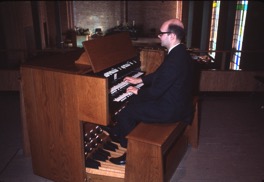
The existing church leans towards classical music. The emerging church prefers jazz, folk and sometimes rock music. The existing church participates primarily through regular attendance in worship. The emerging church is less regular about worship and leans towards special events. The existing church supports the church through planned giving and regular support. The emerging church is very generous for special projects and experiences ups and downs in its patterns of giving. The existing church supports committees and boards. The emerging church shuns meetings and prefers hands-on engagement in mission.
I could go on and on, and in fact, I have made several different lists of descriptors of the differences between the existing and emerging churches. But it is not accurate to think of these descriptions as two groups of people who occupy the same church building. The same individual participates in both congregations. There are members of historic families who prefer hands on mission to committee work. There are new members who fill out pledge cards and give the same amount every month. There are folks who were first attracted to our congregation because of its classical music who are irregular in their attendance patterns. In a sense we all belong to the past and to the future at the same time.
So we practice the art of being a community of faith at the intersection of two churches: one existing and the other emerging. And any traffic officer can tell you that there are more accidents at the intersections. There are days when the tension gets to me as pastor of the congregation, but those days are far fewer than the days when it is simply exciting to be a part of such intense activity. Even when we have disagreements, they often are such signs of vitality that I relish the opportunity to listen to the disagreements and work to find ways to keep both points of view alive in our mission and ministry.
The truth is that our moment is very small in the overall flow of history. The issues that seem big to us at the moment are rarely as important as we think they might be. Big problems we face and overcome often seem small when we look back on them. Taking a broader perspective and a long-term view reveals that the tension is essential. It is how we get from the past to the future.
So I thank God for both the existing church and the emerging church. May I find the grace to be pastor to both.
But change cannot be stopped. It is a part of the world. And we see the tensions of change all around us.
I often refer to museums as one of the examples of change in the world. You would think that museums, with their focus on the past and on what has already happened, would establish their displays and then look the same year after year. But I can think of no museum that I have visited multiple times that does not look very different from the way it looked years ago. Static displays have been replaced with dynamic interactive experiences. Dioramas have been replaced with video screens. Even the stories being told have changed. When I was younger, many museums presented a very Euro-centric interpretation of history. It was not uncommon for a museum to portray indigenous people as primitive, lacking culture and ignorant. Some museums displayed sacred items and even human remains without any information about the deep spiritual meanings of the objects. Times have changed.
Times have changed in the church as well. And change in the church is filled with tension if, for no other reason that we see maintaining traditions to be at the core of our identity. Many churches use the Wesleyan Quadrilateral as one of the ways of interpreting their core values. Put simply, the Quadrilateral states that there are four ways of knowing God: scripture, tradition, reason and experience. Some add revelation to the four.
If history and tradition are one of the ways of knowing God, it is impossible to simply throw out the tradition. Even as we long to embrace the future, we carry the weight of the past within our church structures and organization.
So it may always have been that the institutional church has consisted of many different parts held in tension and sometimes giving rise to conflict. It seems to be a mode of existence for the congregation I serve. Being the first Christian congregation established in our city, our church is proud of its history and traditions. We have generations of shared experience and a sense of being well established in our community. We like to tell the story of our founding and of our establishment. Our church parlor boasts photographs of all of the different buildings that have been home to our congregation. We offer books about the church’s history as a free gift to members and those seeking to become affiliated with our congregation. Our congregation is home to four emeritus staff members and at least eight retired clergy persons. Even though our sanctuary is very modern it its design, the building that houses our congregation is now more than 50 years old. We even held an anniversary celebration on the occasion of our building’s 50th year.

We are also a congregation that is slightly older than the surrounding population. And the population of our community is heavily retired. South Dakota tends to export the majority of its youth to spend their working lives in other places and this is even more so of Rapid City than of the cities on the Eastern edge of our state. But it is a great place to retire, so we experience the influx of seniors and our community’s economy is geared in part to providing for the needs of this population. Our church reflects our community, and also has the legacy of a long-standing congregation. We have members whose families have belonged to this congregation for five generations.
Change is inevitable in all congregations. It is dramatic in a church where we mourn the deaths of 12 – 20 members every year. Just keeping our membership stable, which we have done for a century or more, means that about a third of our congregation is new every decade.
Sometimes I speak of two congregations in the same church: an existing congregation and an emerging congregation. The choice of the names for the two congregations is important because both congregations are living and vital. It would be inaccurate to say that the tension is simply between the old guard and the new members, as we attract new members with leanings toward each expression of faith. But there are differences between these congregations.

The existing church leans towards classical music. The emerging church prefers jazz, folk and sometimes rock music. The existing church participates primarily through regular attendance in worship. The emerging church is less regular about worship and leans towards special events. The existing church supports the church through planned giving and regular support. The emerging church is very generous for special projects and experiences ups and downs in its patterns of giving. The existing church supports committees and boards. The emerging church shuns meetings and prefers hands-on engagement in mission.
I could go on and on, and in fact, I have made several different lists of descriptors of the differences between the existing and emerging churches. But it is not accurate to think of these descriptions as two groups of people who occupy the same church building. The same individual participates in both congregations. There are members of historic families who prefer hands on mission to committee work. There are new members who fill out pledge cards and give the same amount every month. There are folks who were first attracted to our congregation because of its classical music who are irregular in their attendance patterns. In a sense we all belong to the past and to the future at the same time.
So we practice the art of being a community of faith at the intersection of two churches: one existing and the other emerging. And any traffic officer can tell you that there are more accidents at the intersections. There are days when the tension gets to me as pastor of the congregation, but those days are far fewer than the days when it is simply exciting to be a part of such intense activity. Even when we have disagreements, they often are such signs of vitality that I relish the opportunity to listen to the disagreements and work to find ways to keep both points of view alive in our mission and ministry.
The truth is that our moment is very small in the overall flow of history. The issues that seem big to us at the moment are rarely as important as we think they might be. Big problems we face and overcome often seem small when we look back on them. Taking a broader perspective and a long-term view reveals that the tension is essential. It is how we get from the past to the future.
So I thank God for both the existing church and the emerging church. May I find the grace to be pastor to both.
Copyright © 2012 by Ted Huffman. I wrote this. If you want to copy it, please ask for permission. There is a contact me button at the bottom of this page. If you want to share my blog a friend, please direct your friend to my web site.
Followup to Yesterday's Blog
03/02/12 05:40
I suppose that you already have heard the news. Yesterday at about the same time that I was writing my blog Punxsutawney Phil was seeing his shadow and predicting six more weeks of winter. Regular readers will recall that I was wishing for such a prediction. Our winter has been so uncommonly mild that it feels like we haven’t really had any winter yet. Even the media are getting into the act. All day yesterday there were predictions on the radio of the snow that was heading our way. Never mind that the snow went 300 miles south of town. Never mind that I awoke to no snow on the ground. I suppose I could drive down to Scottsbluff to see a blizzard, but somehow it just doesn’t seem to be worth the effort.
Here is the deal, however. If we are going to get six more weeks of winter, I really, really, really hope that they’ve got some good sheds or a warm barn on the Giannonatti and Siaba ranches up by Ludlow. Here’s why:

This year the Black Hills Stock Show and Rodeo was host to the National Sheep Shearing Championships. Maybe some sports fans lost the event in all of the Super Bowl hype that is filling up the television, but if you grew up where I did, you’d know that sheep shearing is a manly sport. Did you ever try to wrestle a lamb? Try doing it with one hand while you are holding the clippers in the other. Add in a clock. Remember you get docked for each time you cut the sheep instead of the wool. It can get very interesting. It requires strength, dexterity and training.
The math is pretty simple. On the ranches a shearer gets paid about $3 per sheep. The more you shear in a day, the more money you earn. The really good shearers can separate the wool from a hundred sheep a day. Anything more than that is legendary. When I was a kid there was a rumor of a traveling shearer who could do 200 head a day. I never got to see the guy, but I have always believed that he is out there somewhere.
Most ranchers don’t have enough sheep to handle very many shearers who can shear 200 sheep a day. They don’t really care how fast the shearers go as long as they don’t cut the sheep and don’t damage the wool. 300 sheep are going to cost $900 to get sheared. They should produce a couple thousand pounds of wool. If the price is good, say $2.25 a pound, there is enough to pay the shearers, the cost of feed and veterinarian supplies. There will also be a bit left over for equipment repairs and paying the power bill. Some years there’s a little grocery money in it as well.
There isn’t much glory or wealth in sheep ranching. The Shepherds in the Bible got some fame out of the deal, but not in their own lifetime. Even the shearers don’t get much glory. There are a couple of trophies and the national winner gets a belt buckle. It is about the size of a postcard and has some gold on it, but around the Civic Center this week, that buckle wouldn’t be out of place. It’s smaller than the buckles won by some of the rodeo cowboys.
I guess we’ve come a long way if we can have a big stock show and rodeo with she sheep contests running alongside the rodeo. If you’re going to haul more than a hundred semi loads of dirt into the Civic Center and about half that amount onto the parking lot to accommodate all the critters, you might as well include sheep along with the cattle and horses. It wasn’t always so. There was a lot of animosity between cowboys and sheepherders back in the days when the leases on government pasture were cheap and critters straying from one place to another was common. In my hometown, the closest thing we had to an integrated bar was the Timber, where business people from town mixed with loggers. The sheepherders had their own bar at one end of the street and the cowboys had another at the other end. They didn’t need to have fighting words. If a cowboy stepped into The Court or a sheepherder into The Grand that was enough to make the sheriff nervous. If they actually ordered a drink it was enough to get a fight going. They usually didn’t bother to fight in the alley behind the bar – main street was good enough for a good old fight.
Those days are long gone, thank goodness. I’ve got friends that raise sheep and cattle on the same place. The sheepherders and cowboys are mixing well at the Civic Center this week. I guess the place isn’t quite fully integrated. At least I haven’t heard of a hog-hollering contest yet, but we’re making progress.
It is all in good fun. People get together are stock shows and they are good people so getting together with them is a treat. When they get together they have a good time and having a good time is what the whole event is about in the first place. In the ranching business there are plenty of days of solitude and lots of time to be out in the hills or plains by your self. You learn to be independent and self-reliant. When the shop says your 12 year old pickup truck isn’t worth repairing because it has a quarter of a million miles on it, you tow it back to the place for a parts truck and start shopping for a used truck of the same make, model and year with a few less miles on it. When something breaks, you fix it. So when there is an opportunity to get together with other folks you take it and you really enjoy it.

Which is why I hope that there are some warm barns up by Ludlow. The people may have been having a good time, but there are 300 or so sheep that just got sheared. If Punxsutawney Phil is right and we’re headed for six more weeks of winter that is a great big bunch of cold critters. They’ll probably spend the next six weeks dreaming of spring.
On the other hand, I’m glad they sheared some of them. If it does turn cold, I’ve got my fleece-lined moccasins and my wool blanket to keep me toasty until spring comes.
Here is the deal, however. If we are going to get six more weeks of winter, I really, really, really hope that they’ve got some good sheds or a warm barn on the Giannonatti and Siaba ranches up by Ludlow. Here’s why:

This year the Black Hills Stock Show and Rodeo was host to the National Sheep Shearing Championships. Maybe some sports fans lost the event in all of the Super Bowl hype that is filling up the television, but if you grew up where I did, you’d know that sheep shearing is a manly sport. Did you ever try to wrestle a lamb? Try doing it with one hand while you are holding the clippers in the other. Add in a clock. Remember you get docked for each time you cut the sheep instead of the wool. It can get very interesting. It requires strength, dexterity and training.
The math is pretty simple. On the ranches a shearer gets paid about $3 per sheep. The more you shear in a day, the more money you earn. The really good shearers can separate the wool from a hundred sheep a day. Anything more than that is legendary. When I was a kid there was a rumor of a traveling shearer who could do 200 head a day. I never got to see the guy, but I have always believed that he is out there somewhere.
Most ranchers don’t have enough sheep to handle very many shearers who can shear 200 sheep a day. They don’t really care how fast the shearers go as long as they don’t cut the sheep and don’t damage the wool. 300 sheep are going to cost $900 to get sheared. They should produce a couple thousand pounds of wool. If the price is good, say $2.25 a pound, there is enough to pay the shearers, the cost of feed and veterinarian supplies. There will also be a bit left over for equipment repairs and paying the power bill. Some years there’s a little grocery money in it as well.
There isn’t much glory or wealth in sheep ranching. The Shepherds in the Bible got some fame out of the deal, but not in their own lifetime. Even the shearers don’t get much glory. There are a couple of trophies and the national winner gets a belt buckle. It is about the size of a postcard and has some gold on it, but around the Civic Center this week, that buckle wouldn’t be out of place. It’s smaller than the buckles won by some of the rodeo cowboys.
I guess we’ve come a long way if we can have a big stock show and rodeo with she sheep contests running alongside the rodeo. If you’re going to haul more than a hundred semi loads of dirt into the Civic Center and about half that amount onto the parking lot to accommodate all the critters, you might as well include sheep along with the cattle and horses. It wasn’t always so. There was a lot of animosity between cowboys and sheepherders back in the days when the leases on government pasture were cheap and critters straying from one place to another was common. In my hometown, the closest thing we had to an integrated bar was the Timber, where business people from town mixed with loggers. The sheepherders had their own bar at one end of the street and the cowboys had another at the other end. They didn’t need to have fighting words. If a cowboy stepped into The Court or a sheepherder into The Grand that was enough to make the sheriff nervous. If they actually ordered a drink it was enough to get a fight going. They usually didn’t bother to fight in the alley behind the bar – main street was good enough for a good old fight.
Those days are long gone, thank goodness. I’ve got friends that raise sheep and cattle on the same place. The sheepherders and cowboys are mixing well at the Civic Center this week. I guess the place isn’t quite fully integrated. At least I haven’t heard of a hog-hollering contest yet, but we’re making progress.
It is all in good fun. People get together are stock shows and they are good people so getting together with them is a treat. When they get together they have a good time and having a good time is what the whole event is about in the first place. In the ranching business there are plenty of days of solitude and lots of time to be out in the hills or plains by your self. You learn to be independent and self-reliant. When the shop says your 12 year old pickup truck isn’t worth repairing because it has a quarter of a million miles on it, you tow it back to the place for a parts truck and start shopping for a used truck of the same make, model and year with a few less miles on it. When something breaks, you fix it. So when there is an opportunity to get together with other folks you take it and you really enjoy it.

Which is why I hope that there are some warm barns up by Ludlow. The people may have been having a good time, but there are 300 or so sheep that just got sheared. If Punxsutawney Phil is right and we’re headed for six more weeks of winter that is a great big bunch of cold critters. They’ll probably spend the next six weeks dreaming of spring.
On the other hand, I’m glad they sheared some of them. If it does turn cold, I’ve got my fleece-lined moccasins and my wool blanket to keep me toasty until spring comes.
Copyright © 2012 by Ted Huffman. I wrote this. If you want to copy it, please ask for permission. There is a contact me button at the bottom of this page. If you want to share my blog a friend, please direct your friend to my web site.
Groundhog Day
02/02/12 05:13
OK. This year I am taking sides. I am rooting for Punxsutawney Phil, the Seer of Seers, Sage of Sages, Prognosticator of Prognosticators and Weather Prophet Extraordinary to see his shadow today. I am ready for six weeks more of winter if for no other reason than we haven’t yet had six weeks of winter. I don’t count highs in the mid fifties with occasional colder days and a few snow skiffs to qualify as real winter. The weather has been unusually weird so far this winter. I am just fine with a few genuine blizzards and enough snow to slow the traffic.

Having said that, I do not believe that the groundhog has any abilities as a predictor of the future. It is all fun and games with a bit of superstition mixed in. I am simply not that superstitious. I’ll trust the meteorologists over the groundhog every time.
In the first place, the groundhog is a stand in for another animal in a more ancient tradition. The day is known in the church as the Presentation of the Lord. It is also sometimes called Candlemas. It is a day set aside for contemplation of the presentation of Jesus at the Temple in Jerusalem, reported in Luke 2:22-40. The day is also sometimes referred to as the Feast of the Purification of the Virgin, referring to the ritual cleansing of mothers following a birth that was part of temple observances. Another name is Meeting of the Lord, in reference to the pronouncements made by Simeon and Anna about the Christ child. In the Roman Catholic Church, the presentation of Jesus is the fourth joyful mystery of the Rosary.
The celebration lands on February 2 because it is 40 days after Christmas. The number 40 is significant in many Biblical stories and in the traditions of the church as well. It is probably among the most ancient of Christian observances. There are sermons on the Feast that have been preserved that date back to at least 312, Which means we’ve been observing this occasion for at least 1700 years.

I don’t know when the tradition of looking for a hedgehog or badger hole and observing it to see if the creature saw his shadow on Candlemas got started. It appears to have been around for quite a while. There are probably some connections with themes of light and darkness in the tradition somewhere. Anyway, by the time German settlers began to come to Pennsylvania, the tradition was deeply ingrained. Having trouble finding hedgehogs, or badgers for that matter, in Pennsylvania, the settlers soon resorted to watching groundhogs.
These days it is a tradition that has become ritual and there are many folks who claim that the Groundhog who lives in Gobbler’s Knob in Punxsutawney is the only legitimate groundhog and that The Punxsutawney Groundhog Club is the official keeper of the groundhog and interpreter of whether or not he sees his shadow.
I’ve always wondered whether or not a groundhog, emerging from an underground burrow on a bright, sunny day might close his eyes and even though he casts a shadow, he might not actually see the shadow, bringing the prediction into doubt. How do you know exactly what a groundhog actually saw or didn’t see?
Over the years we have had some fun with the day. It is the birthday of my great Uncle Ted, whose name I was given. He moved to our town when I was a child and so we spend many holidays together and for many years we always had a birthday cake and a special dinner in recognition of February 2. The tradition was expanded when my sister had a daughter born on that day, passing the holiday to a new generation.
The forecast for Rapid City is for mostly cloudy skies with the chance of snow over the next couple of days. It is going to get up into the 40’s today, but tomorrow and Saturday should be a bit cooler. The chance of snow is actually pretty slim, maybe 30% at best. But I guess Punxsutawney Phil doesn’t care about the weather in Rapid City. The forecast for Punxsutawney, PA, is also for a mostly cloudy day, so Phil may not see his shadow. There is a live web camera set up for those who just need to watch the entire event at this link: http://www.visitpa.com/groundhog-day-live-stream. People seem to be having a good time. The black suits and top hats look pretty cool. I’ve never had a hat like that and I like hats.
I heard one person comment that whether or not the groundhog sees his shadow we are in for nine more months of campaign speeches.
Still, I am hoping for more winter. I know it can cause problems for those who are traveling. And I know that it raises expenses with the need for more heat and more snowplowing, but the forest needs the snow. The plants all seem a bit stressed this winter as they wait for moisture to seep down into their roots. Some of the plants are confused by all of the warm days and are sending out premature shoots and buds.

And I will be thinking of the parents of Jesus on this day. Whether or not it is the exact day of his presentation in the temple, it must have been a powerful and overwhelming experience for the parents. On a regular basis I have the experience of parents of a child bringing their child and presenting it to me for baptism. With the water and the traditions of our people we offer our prayers of blessing and publicly acknowledge that this child is one of us. This child belongs to the traditions of our people. We are connected with generations and generations of grandmas and grandpas linking us to the most ancient of our ancestors. And we are connected to generations and generations of yet-unborn children who will grow into adults who will lead our people. I wonder if Joseph’s hands shook when he handed the baby to the elders. I wonder if Mary’s stomach fluttered as she heard their predictions and prayers. It must have been an awesome and overwhelming moment for the parents. Such joy. Such promise. Such responsibility.
And, like Punxsutawney Phil, they must have been tired – maybe even exhausted. After all, unlike Phil, they had been living with a baby for 40 days. That is equal to 40 nights of having your sleep interrupted.
On second thought, Joseph might have been relieved to hand the baby to someone else.

Having said that, I do not believe that the groundhog has any abilities as a predictor of the future. It is all fun and games with a bit of superstition mixed in. I am simply not that superstitious. I’ll trust the meteorologists over the groundhog every time.
In the first place, the groundhog is a stand in for another animal in a more ancient tradition. The day is known in the church as the Presentation of the Lord. It is also sometimes called Candlemas. It is a day set aside for contemplation of the presentation of Jesus at the Temple in Jerusalem, reported in Luke 2:22-40. The day is also sometimes referred to as the Feast of the Purification of the Virgin, referring to the ritual cleansing of mothers following a birth that was part of temple observances. Another name is Meeting of the Lord, in reference to the pronouncements made by Simeon and Anna about the Christ child. In the Roman Catholic Church, the presentation of Jesus is the fourth joyful mystery of the Rosary.
The celebration lands on February 2 because it is 40 days after Christmas. The number 40 is significant in many Biblical stories and in the traditions of the church as well. It is probably among the most ancient of Christian observances. There are sermons on the Feast that have been preserved that date back to at least 312, Which means we’ve been observing this occasion for at least 1700 years.

I don’t know when the tradition of looking for a hedgehog or badger hole and observing it to see if the creature saw his shadow on Candlemas got started. It appears to have been around for quite a while. There are probably some connections with themes of light and darkness in the tradition somewhere. Anyway, by the time German settlers began to come to Pennsylvania, the tradition was deeply ingrained. Having trouble finding hedgehogs, or badgers for that matter, in Pennsylvania, the settlers soon resorted to watching groundhogs.
These days it is a tradition that has become ritual and there are many folks who claim that the Groundhog who lives in Gobbler’s Knob in Punxsutawney is the only legitimate groundhog and that The Punxsutawney Groundhog Club is the official keeper of the groundhog and interpreter of whether or not he sees his shadow.
I’ve always wondered whether or not a groundhog, emerging from an underground burrow on a bright, sunny day might close his eyes and even though he casts a shadow, he might not actually see the shadow, bringing the prediction into doubt. How do you know exactly what a groundhog actually saw or didn’t see?
Over the years we have had some fun with the day. It is the birthday of my great Uncle Ted, whose name I was given. He moved to our town when I was a child and so we spend many holidays together and for many years we always had a birthday cake and a special dinner in recognition of February 2. The tradition was expanded when my sister had a daughter born on that day, passing the holiday to a new generation.
The forecast for Rapid City is for mostly cloudy skies with the chance of snow over the next couple of days. It is going to get up into the 40’s today, but tomorrow and Saturday should be a bit cooler. The chance of snow is actually pretty slim, maybe 30% at best. But I guess Punxsutawney Phil doesn’t care about the weather in Rapid City. The forecast for Punxsutawney, PA, is also for a mostly cloudy day, so Phil may not see his shadow. There is a live web camera set up for those who just need to watch the entire event at this link: http://www.visitpa.com/groundhog-day-live-stream. People seem to be having a good time. The black suits and top hats look pretty cool. I’ve never had a hat like that and I like hats.
I heard one person comment that whether or not the groundhog sees his shadow we are in for nine more months of campaign speeches.
Still, I am hoping for more winter. I know it can cause problems for those who are traveling. And I know that it raises expenses with the need for more heat and more snowplowing, but the forest needs the snow. The plants all seem a bit stressed this winter as they wait for moisture to seep down into their roots. Some of the plants are confused by all of the warm days and are sending out premature shoots and buds.

And I will be thinking of the parents of Jesus on this day. Whether or not it is the exact day of his presentation in the temple, it must have been a powerful and overwhelming experience for the parents. On a regular basis I have the experience of parents of a child bringing their child and presenting it to me for baptism. With the water and the traditions of our people we offer our prayers of blessing and publicly acknowledge that this child is one of us. This child belongs to the traditions of our people. We are connected with generations and generations of grandmas and grandpas linking us to the most ancient of our ancestors. And we are connected to generations and generations of yet-unborn children who will grow into adults who will lead our people. I wonder if Joseph’s hands shook when he handed the baby to the elders. I wonder if Mary’s stomach fluttered as she heard their predictions and prayers. It must have been an awesome and overwhelming moment for the parents. Such joy. Such promise. Such responsibility.
And, like Punxsutawney Phil, they must have been tired – maybe even exhausted. After all, unlike Phil, they had been living with a baby for 40 days. That is equal to 40 nights of having your sleep interrupted.
On second thought, Joseph might have been relieved to hand the baby to someone else.
Copyright © 2012 by Ted Huffman. I wrote this. If you want to copy it, please ask for permission. There is a contact me button at the bottom of this page. If you want to share my blog a friend, please direct your friend to my web site.
Serving
01/02/12 05:26
I didn’t take a single photograph yesterday. Today’s blog has no pictures. Don’t worry, the pictures will return.
Yesterday was one of those days that happen from time to time in the life of a pastor. I went into the office early to prepare a presentation and then headed off for my 8:30 meeting. That meeting ended in time for me to make a meeting at 10:30, another at 12:45, and additional meetings at 2:00, 3:30, 6:00 and 7:00. The 7 p.m. meeting was a long one and it was after 9 pm when I locked the building. There were short breaks between some of the meetings, but none long enough for me to do much more than gather my materials and wits for the next meeting.
I didn’t go into the ministry out of a love of meetings. On the other hand, it wouldn’t be fair for me to blame anyone but myself for my commitments that mean so many meetings. One of the dynamics of my current stage in life is that I care about many things. I serve a complex congregation with a lot of different organizational needs. I belong to a community with many worthwhile institutions. Two of my meetings yesterday were because of my involvement in the wider community.
There seems to be a bit more conflict, disagreement and dissent in meetings these days. I think it is stirred in part by the angry tone of national politics. We have become used to congress as a place that is nonstop argument. Cooperation is rarely held up as a positive virtue by politicians. The tone of even primary campaigns is focused on attack and tearing down the opposition rather than lifting up the virtues of the candidates for honest comparison.
We seem to be reflecting this tone as we work together to build our community. It may not be true, but it seems like this year I have spent more time listening to complaints and criticisms than usual. As a result I am going to make a few observations. They may be more a product of being tired than of rational thought, but writing them in my blog probably wastes less time than voicing them in meetings.
Bigger isn’t always better. At least three times in the last week I have heard someone describe a healthy institution as “dying.” Their rationale is that since it isn’t getting bigger, it must be dying. That may be true of some things, but it isn’t true of all things. Take the Black Hills Chamber Music Society, for example. Chamber music is by its nature intimate. The society has been drawing audiences of 75 to 125 for its concerts for nearly 50 years. The name chamber music refers to the size of the room. When audiences get too large, the music has to be moved to a concert hall. That isn’t a bad thing, but there are plenty of us who enjoy the intimacy of well-played acoustic music in a smaller venue.
Here is another example. The Black Hills Workshop and Training Center exists to serve persons with disabilities. One of the goals of the organization is to enable persons to live as independently as possible. Job coaching and placement, housing assistance and independent living assistance are among the services offered. Success is not measured by increasing the number of people who are dependent upon the services provided, but rather in enabling people to become independent and free from needing the services. There are a few economies of scale in purchasing supplies and securing funding for projects, but the services offered are best supplied on an individual basis. Creating pressure for the institution to become bigger and bigger leads it away from its core values and mission.
I could go on and on. It seems to me that faithfulness is far more important than growth for growth’s sake. I suspect that one thing that makes growth such a popular goal is that the simplicity of the mathematics. You can measure whether the audience is bigger or smaller than the last event. You can compare budgets to see if this year’s involves more dollars than last year’s. It is much more difficult to measure whether or not an organization is faithful to its mission.
When I serve as a director of a non-profit corporation, my fiduciary responsibility of loyalty requires me to focus on the core mission of that corporation. I read constitutions and by laws of the organizations I serve. They do not include statements like “become the richest,” or “become the biggest.” They usually speak of services provided to others and sometimes speak of the quality of care. Placing quantity over quality might be a successful business plan for Wal-Mart, but it is rarely the goal of a service organization.
That leads me to another observation. Nonprofit corporations do not run like for profit businesses. They don’t run like families, either, but families are often closer to the model than businesses. Volunteers don’t behave like employees. Persons served are not customers. Understanding the unique operations of nonprofit organizations serves directors better than trying to make them run like a for-profit business.
For me, it is all about the mission. I do not serve because I want glory or recognition. I serve because I am called to serve. That means putting others ahead of my own desires and wants. That means putting the health and long-term sustainability of the organization over short-term gains and statistical spikes. That means recognizing that I am a part of something that is bigger than myself. And, often it means working with those with whom I disagree rather than winning over them.
I cannot separate myself from the Christian faith that is at the core of my being. Jesus said, “whoever wants to be great among you must be your servant,” and “for whoever wishes to save his life will lose it; but whoever loses his life for my sake will find it.”
Instead of being so afraid of dying, those of us whose lives are based in a resurrection faith might do well to consider what it might mean to give up our lives for Jesus sake.
So even thought meeting after meeting can be energy sapping and sometimes it feels like they suck the life right out of me, I’ll probably continue to go to meetings. If it results in deeper service, my temporary discomfort will mean nothing by comparison.
Yesterday was one of those days that happen from time to time in the life of a pastor. I went into the office early to prepare a presentation and then headed off for my 8:30 meeting. That meeting ended in time for me to make a meeting at 10:30, another at 12:45, and additional meetings at 2:00, 3:30, 6:00 and 7:00. The 7 p.m. meeting was a long one and it was after 9 pm when I locked the building. There were short breaks between some of the meetings, but none long enough for me to do much more than gather my materials and wits for the next meeting.
I didn’t go into the ministry out of a love of meetings. On the other hand, it wouldn’t be fair for me to blame anyone but myself for my commitments that mean so many meetings. One of the dynamics of my current stage in life is that I care about many things. I serve a complex congregation with a lot of different organizational needs. I belong to a community with many worthwhile institutions. Two of my meetings yesterday were because of my involvement in the wider community.
There seems to be a bit more conflict, disagreement and dissent in meetings these days. I think it is stirred in part by the angry tone of national politics. We have become used to congress as a place that is nonstop argument. Cooperation is rarely held up as a positive virtue by politicians. The tone of even primary campaigns is focused on attack and tearing down the opposition rather than lifting up the virtues of the candidates for honest comparison.
We seem to be reflecting this tone as we work together to build our community. It may not be true, but it seems like this year I have spent more time listening to complaints and criticisms than usual. As a result I am going to make a few observations. They may be more a product of being tired than of rational thought, but writing them in my blog probably wastes less time than voicing them in meetings.
Bigger isn’t always better. At least three times in the last week I have heard someone describe a healthy institution as “dying.” Their rationale is that since it isn’t getting bigger, it must be dying. That may be true of some things, but it isn’t true of all things. Take the Black Hills Chamber Music Society, for example. Chamber music is by its nature intimate. The society has been drawing audiences of 75 to 125 for its concerts for nearly 50 years. The name chamber music refers to the size of the room. When audiences get too large, the music has to be moved to a concert hall. That isn’t a bad thing, but there are plenty of us who enjoy the intimacy of well-played acoustic music in a smaller venue.
Here is another example. The Black Hills Workshop and Training Center exists to serve persons with disabilities. One of the goals of the organization is to enable persons to live as independently as possible. Job coaching and placement, housing assistance and independent living assistance are among the services offered. Success is not measured by increasing the number of people who are dependent upon the services provided, but rather in enabling people to become independent and free from needing the services. There are a few economies of scale in purchasing supplies and securing funding for projects, but the services offered are best supplied on an individual basis. Creating pressure for the institution to become bigger and bigger leads it away from its core values and mission.
I could go on and on. It seems to me that faithfulness is far more important than growth for growth’s sake. I suspect that one thing that makes growth such a popular goal is that the simplicity of the mathematics. You can measure whether the audience is bigger or smaller than the last event. You can compare budgets to see if this year’s involves more dollars than last year’s. It is much more difficult to measure whether or not an organization is faithful to its mission.
When I serve as a director of a non-profit corporation, my fiduciary responsibility of loyalty requires me to focus on the core mission of that corporation. I read constitutions and by laws of the organizations I serve. They do not include statements like “become the richest,” or “become the biggest.” They usually speak of services provided to others and sometimes speak of the quality of care. Placing quantity over quality might be a successful business plan for Wal-Mart, but it is rarely the goal of a service organization.
That leads me to another observation. Nonprofit corporations do not run like for profit businesses. They don’t run like families, either, but families are often closer to the model than businesses. Volunteers don’t behave like employees. Persons served are not customers. Understanding the unique operations of nonprofit organizations serves directors better than trying to make them run like a for-profit business.
For me, it is all about the mission. I do not serve because I want glory or recognition. I serve because I am called to serve. That means putting others ahead of my own desires and wants. That means putting the health and long-term sustainability of the organization over short-term gains and statistical spikes. That means recognizing that I am a part of something that is bigger than myself. And, often it means working with those with whom I disagree rather than winning over them.
I cannot separate myself from the Christian faith that is at the core of my being. Jesus said, “whoever wants to be great among you must be your servant,” and “for whoever wishes to save his life will lose it; but whoever loses his life for my sake will find it.”
Instead of being so afraid of dying, those of us whose lives are based in a resurrection faith might do well to consider what it might mean to give up our lives for Jesus sake.
So even thought meeting after meeting can be energy sapping and sometimes it feels like they suck the life right out of me, I’ll probably continue to go to meetings. If it results in deeper service, my temporary discomfort will mean nothing by comparison.